VOLUME
ISSUE 13
Weather
Weather, as we know it, is a geoscientific term that refers to atmospheric elements to which planetary inhabitants residing on Earth are subjected. Weather is an integral and integrative system that places humans and animals within the ecology of their habitat. Daily, we glance at the skies as we go about our ritualised chores or plan our activities around the everyday temperateness of the weather. Changing weather defines our everyday sense of being, and over long periods of predictability, it aggregates into the climate of our existence.
ISSUE 13
2024
Weather
ISSN : 23154802
e-ISSN : 3041-0924
Introduction
Exhibition
Essays
Conversation
Contributors’ Bios
Introduction
Introduction: Weather
Exhibition
Everybody Talks About The Weather
Essays
Three Weather Reports on Burning Air
Monsoon Equinox
Conversation
Hà Nội: Weathered Art: Radical Instinct, Community resilience and forecasting in a post-colonial space
Contributors’ Bios
Contributors’ Bios
Introduction
Editor
Venka Purushothaman
Associate Editor
Susie Wong
Copy Editor
Weixin Quek Chong
Advisor
Milenko Prvački
Editorial Board
Asst. Professor Felipe Cervera, UCLA School of Theatre, Film and Television, University of California, Los Angeles
Professor Patrick Flores, University of the Philippines
Dr. Peter Hill, Artist and Honorary Enterprise Professor at the Victorian College of the Arts, University of Melbourne
Professor Janis Jefferies, Goldsmiths, University of London, UK
Dr. Charles Merewether, Art Historian, Independent Researcher, Curator and Scholar
Editorial and Publication Support Team
Malar Nadeson, Dr. Darren Moore, Sureni Salgadoe
Contributors
Peter Hill
Huy Nguyen
Janine Randerson
Dieter Roelstraete
Mithu Sen
Soh Kay Min
Tran Luong
Wang Ruobing
The Editors and Editorial Board thank all reviewers for their thoughtful and helpful comments and feedback to the contributors.
Introduction
Introduction: Weather
The theme of Issue 2024 is the weather.
Weather, as we know it, is a geoscientific term that refers to atmospheric elements to which planetary inhabitants residing on Earth are subjected. Weather is an integral and integrative system that places humans and animals within the ecology of their habitat. Daily, we glance at the skies as we go about our ritualised chores or plan our activities around the everyday temperateness of the weather. Changing weather defines our everyday sense of being, and over long periods of predictability, it aggregates into the climate of our existence. Moreover, as a geoscientific condition, the weather has a significant existential impact on the environment as the Anthropocene besets the human condition -heightened by environmental shifts and crises.
Climatic conditions and weathering themes pervade everyday life. From art and poetry to linguistic metaphors to cloud computing, fecund thematic variations remain essential for describing the human condition. In art, the weather remains a source of idyllic and lurid engagement: the outdoors is observed; colours and light are gazed at; wind, rain and fire are stilled. The weather remains a source of observational training in reaching a realism that parallels an emotional epiphany, romance, melancholy or fear. As artists become deft conquerors of the morphing weather, art history etches a tamed environment subdued by ocular desires.
In contemporary culture, weather becomes a timely indicator of decisions and social practices. In politics, be it ‘fair-weather friends’ or the ‘tide in the affairs of men’ or war ‘hails’, the invocations and incantations remain potent and poignant. While concerns around climate change are at the forefront of contemporary discourse, scholars acknowledge how “profoundly this omnipotent force shapes culture”.1 For example, time is situated closer to the rapidity of weather forecasts than the long durational planetary orbit. In recent times, climate anthropologists have advanced significant theories around the social and embodied dimension of the weathered human body, where “climate change has to be related to global inequality.”2
In scoping the vast weathered landscape, the concept of weather remains notoriously current, providing metaphoric and atmospheric propensities to reimagine the human condition. Given this backdrop, weather’s thematic richness offers endless avenues for exploration and expression. This volume aims to delve into these multiple dimensions, examining how weather shapes, disrupts, and enriches the human condition. By engaging with this theme, we hope to foster a deeper understanding of how atmospheric phenomena influence not just the physical world but also the landscape of human thought and culture. In doing so, we aim to enrich our readers’ perceptions of weather, not just as a series of meteorological events but as a continuous, dynamic dialogue between humanity and nature.
Footnotes
1 Strauss and Orlove, 2021.
2 Eriksen, 2021.
References
Strauss, Sarah and Orlove, Benjamin S. Weather, Climate, Culture. Routledge, 2021.
Eriksen, Thomas Hylland. “Climate change.” The Open Encyclopedia of Anthropology, edited by Felix Stein, 2021. http://doi.org/10.29164/21climatechange
Exhibition
Everybody Talks About The Weather
I get the news I need from the weather report
—Simon & Garfunkel, The Only Living Boy in New York
The following visual essay is based on an exhibition I curated for the Fondazione Prada in Venice in the spring of 2023 in the broader context of that year’s Architecture Biennale. Staged inside the sumptuous interiors of the Fondazione’s 18th-century Ca’ Corner della Regina, the exhibition was rooted in the observation that, even though the current and ongoing climate crisis may well be the single greatest existential threat humankind has ever had to face in its 100,000-ye ar history, it remains a subject, paradoxically enough, that is oddly absent from the broad sweep of mainstream art world attention; one might even make the claim that the climate crisis has yet to spawn its first great corpus of critically acclaimed masterpieces, whether in the realm of visual art, literature, or cinema. It is evidently the very enormity of this crisis that is one major cause of this misplaced paralysis and sense of powerlessness – an unwillingness, in effect, to “talk about the climate crisis” which led me to suggest that we talk about the weather instead. Resorting to the seemingly mundane quotidian ritual of that most timeless and universal of discursive deeds, Everybody Talks About the Weather charts a modest history of art’s meteorological imagination from the 16th century – the nadir of Europe’s “little ice age” – to a present day that has become unimaginable without the endless reporting of one extreme weather event after another. Indeed, what do we really talk about when we talk about the weather? Can we ever regain the innocence with which the likes of Friedrich and Turner turned their gaze to the clouds, or do even Turner’s cloudscapes already speak of a paradise forever lost to the advent and onslaught of anthropogenic climate change? The answers to these questions (“my friend”) are blowing in the wind of our own making.
Dieter Roelstraete, Chicago, February 2024
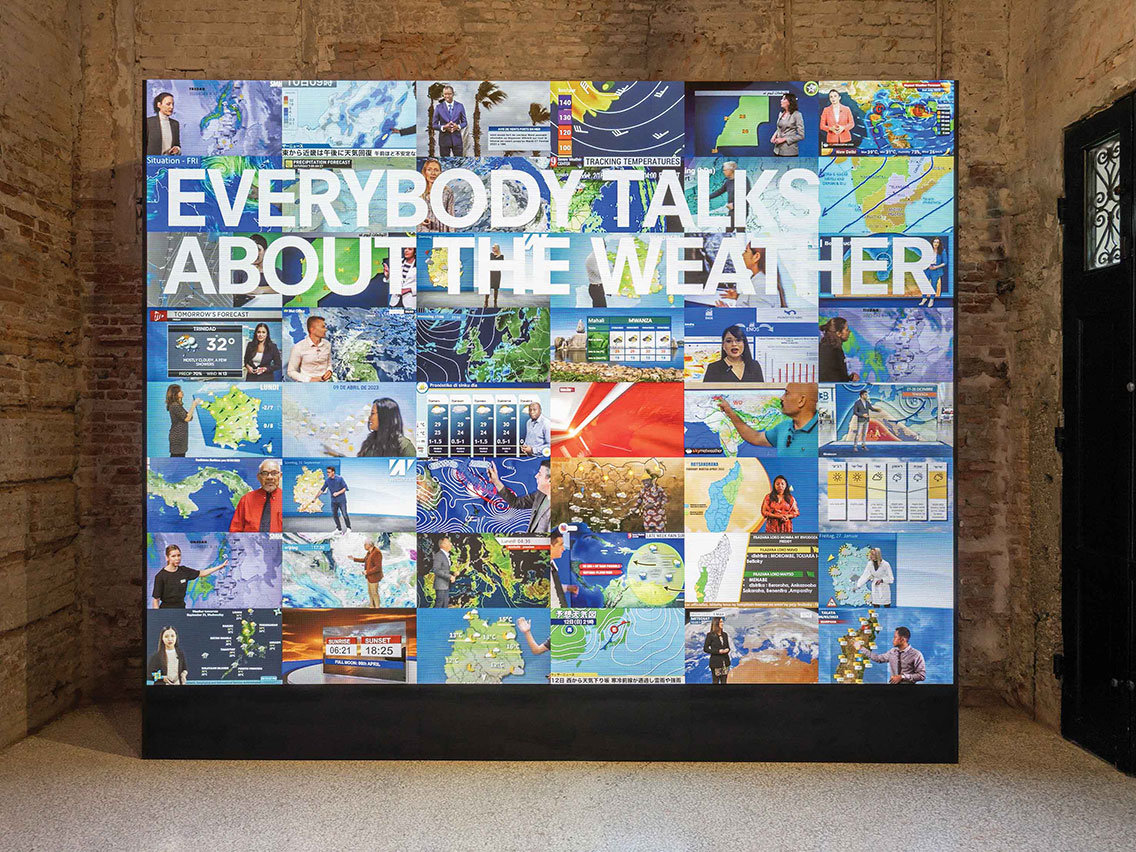
Photo: Marco Cappelletti
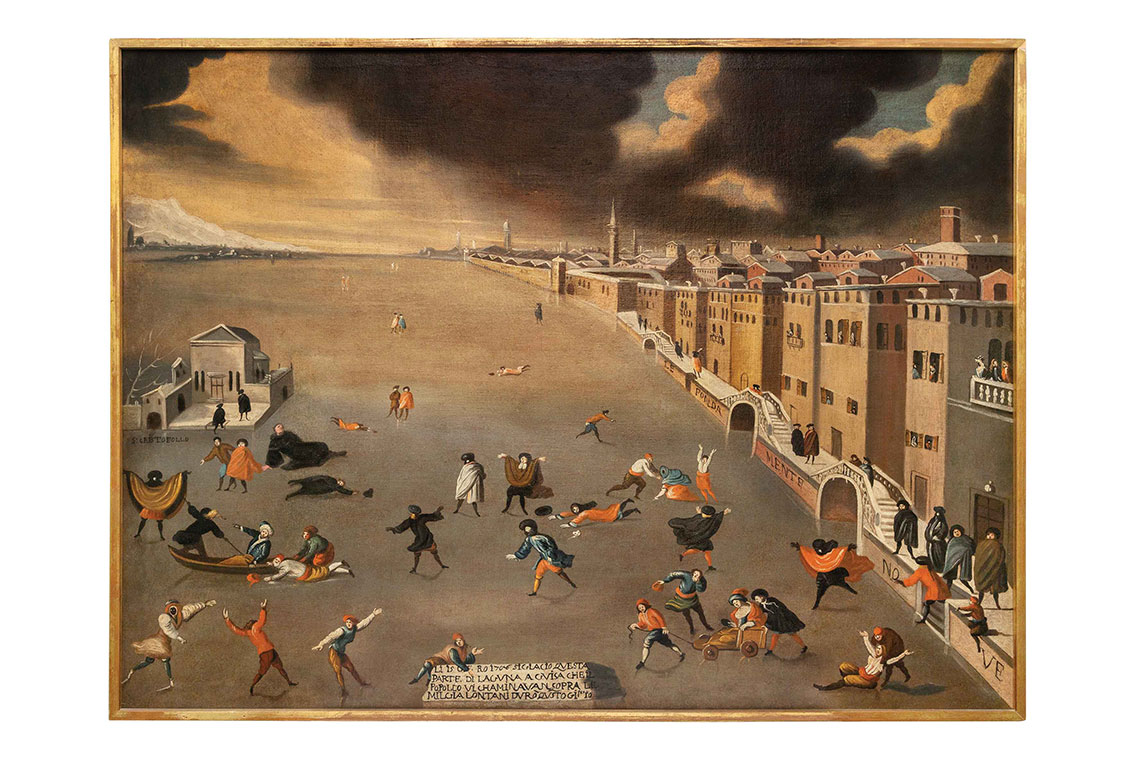
Frozen Lagoon at Fondamenta Nuove 1708 (c. 1709)
Anonymous artists from the Veneto region
oil on canvas
95 × 129 cm
Venice, Fondazione Querini Stampalia

jpg to01 (2022)
Thomas Ruff
inkjet, DiaSec Face, wooden frame
251 × 186 cm
Ed. 01/04
Courtesy the artist ©Thomas Ruff /VG Bild- Kunst, Bonn 2023 / SIAE 2023
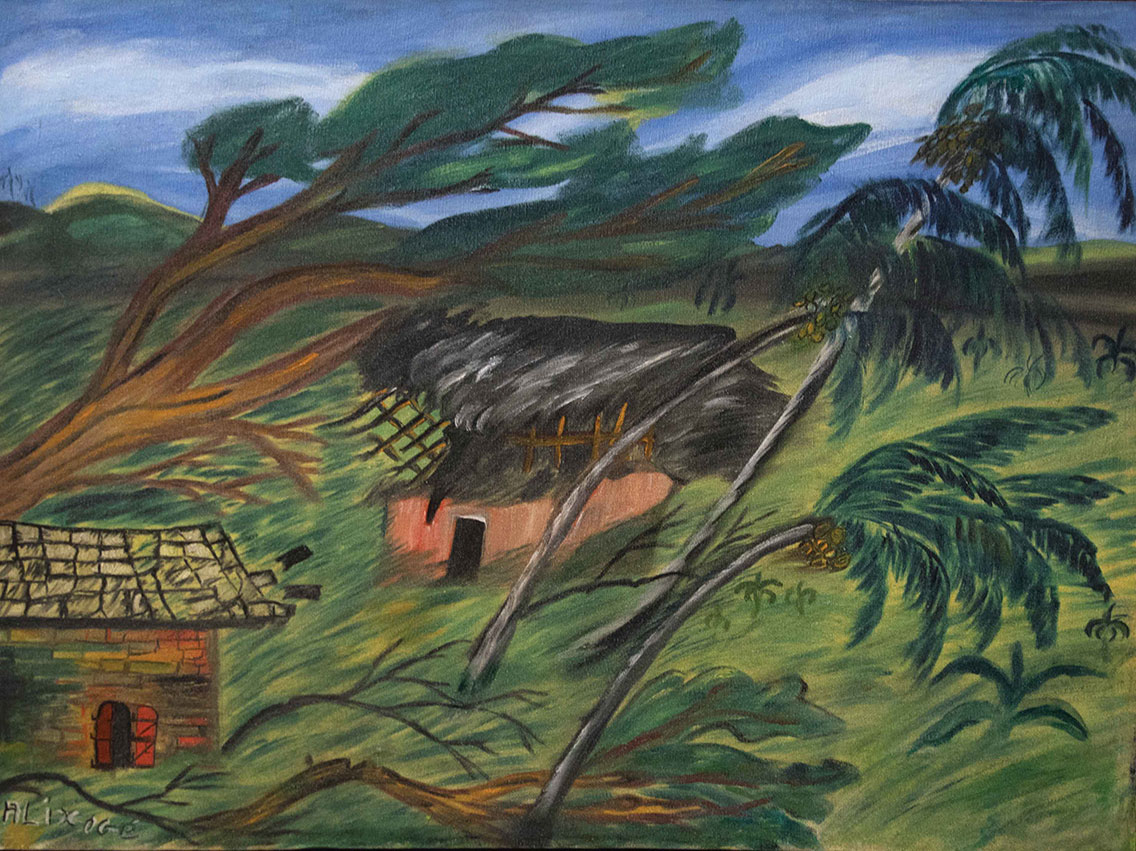
Storm (1969)
Alix Ogé
oil on canvas
48.3 × 63.5 cm
Stokes Haitian Art
Photo: Glenn Stokes
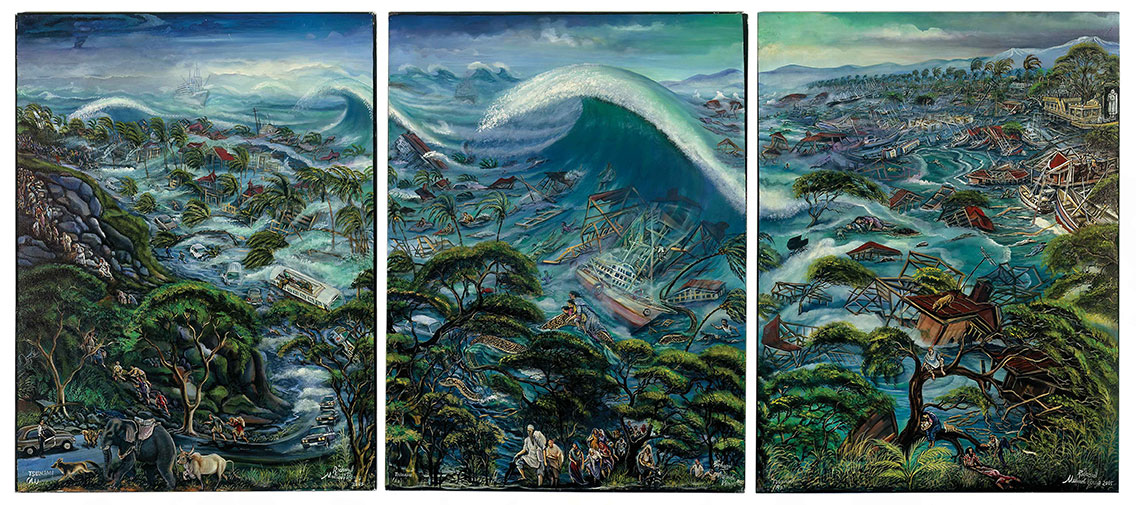
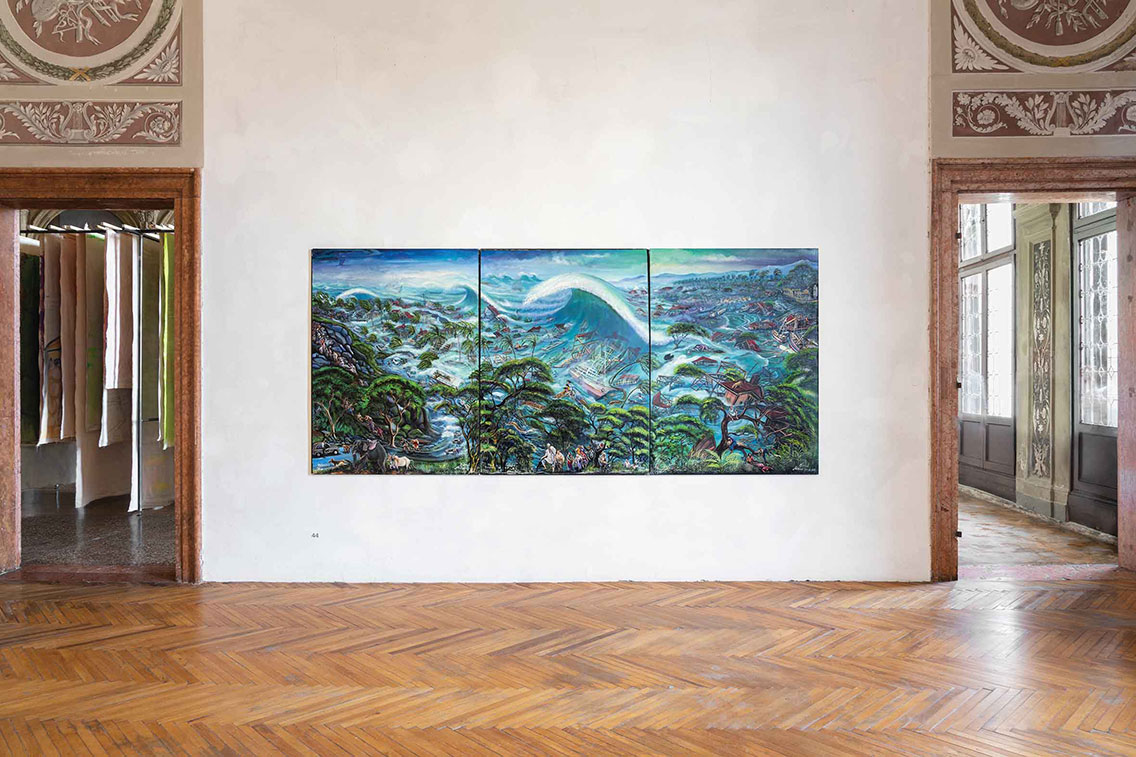
Photo: Marco Cappelletti
Tsunami (2005)
Richard Onyango
acrylic on canvas
160.5 × 365 cm
Geneva, The Jean Pigozzi African Art Collection
Courtesy The Jean Pigozzi African Art Collection
Photo: Maurice Aeschimann, Geneva
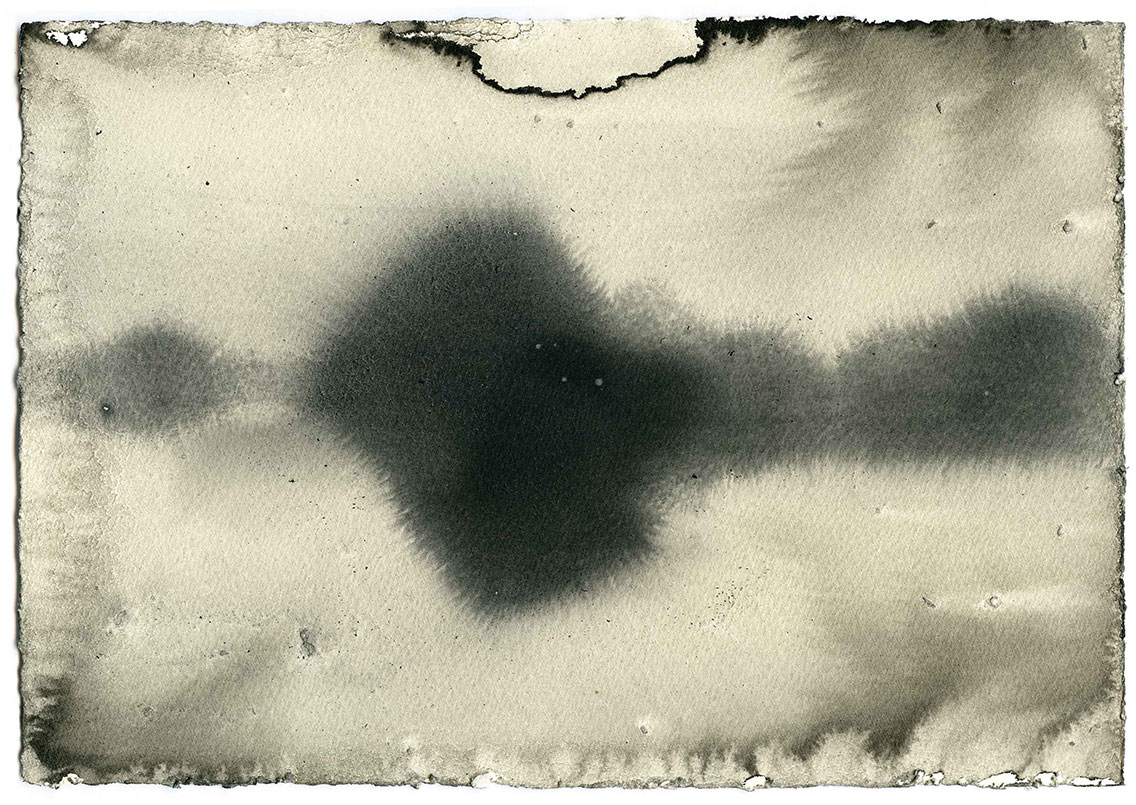
Horizon II (2014)
Antony Gormley
carbon and casein on paper
19.5 × 28 cm
© Antony Gormley, 2023
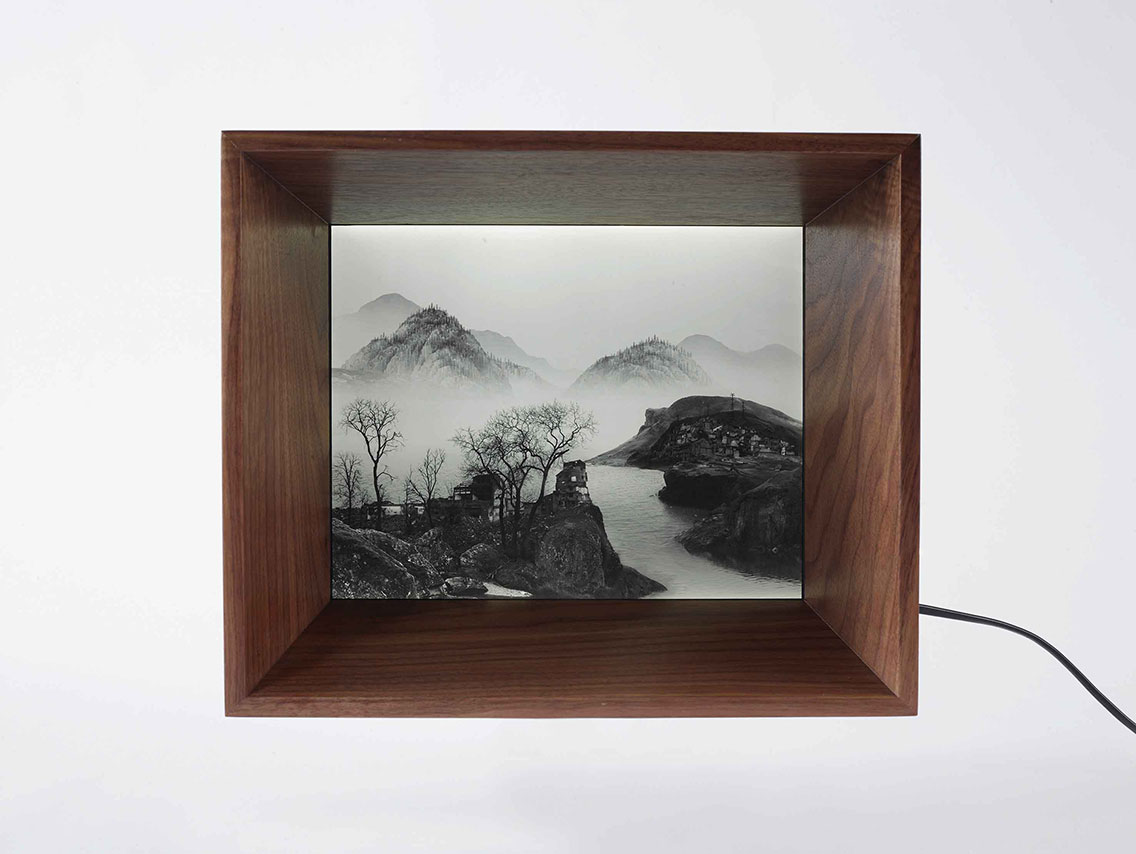
Time Immemorial – Other Shore (2016)
Yang Yongliang
film in lightbox, handmade wood box
20 × 20 cm (film size)
Courtesy Yang Yongliang Studio
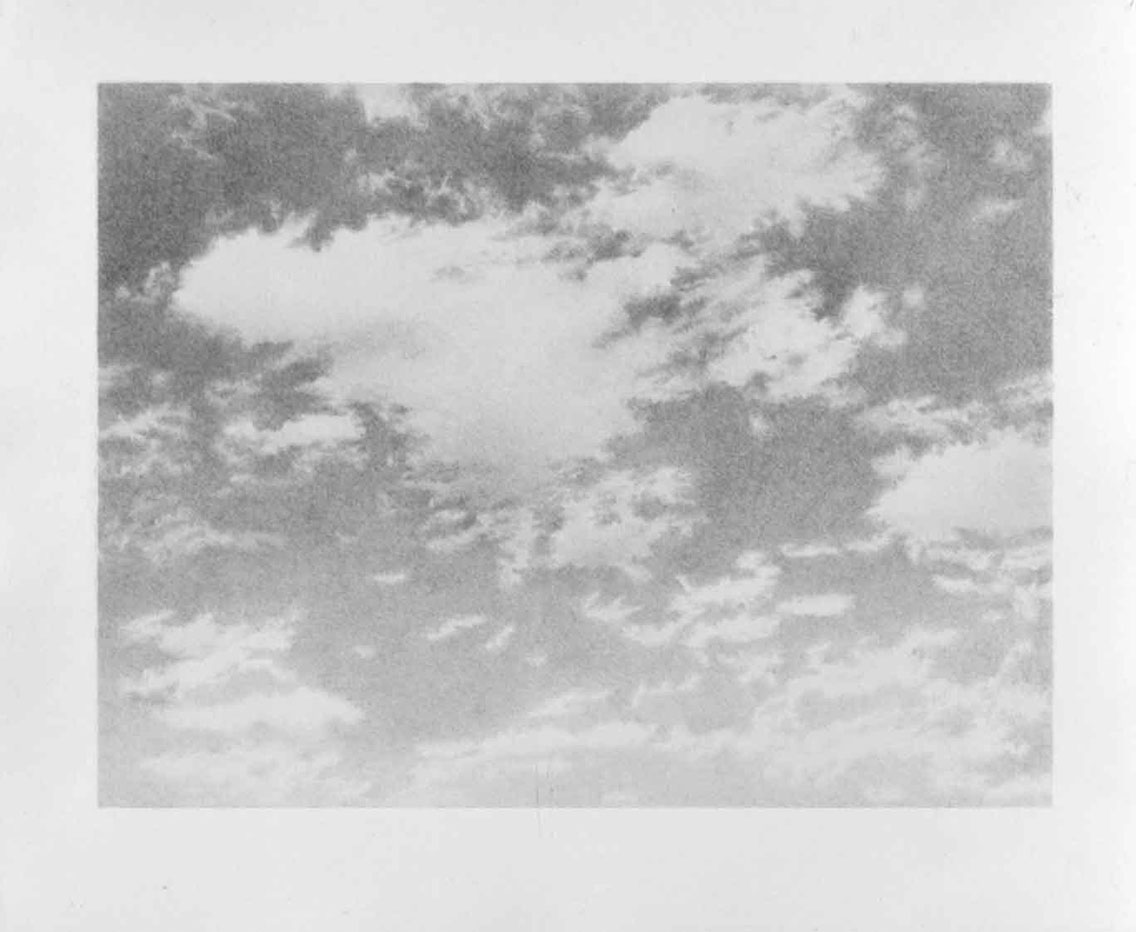
Untitled (Sky) (1975)
Vija Celmins
lithograph
42 × 52 cm
Los Angeles, Cirrus Gallery & Cirrus Editions LTD
Photo: Cirrus Gallery
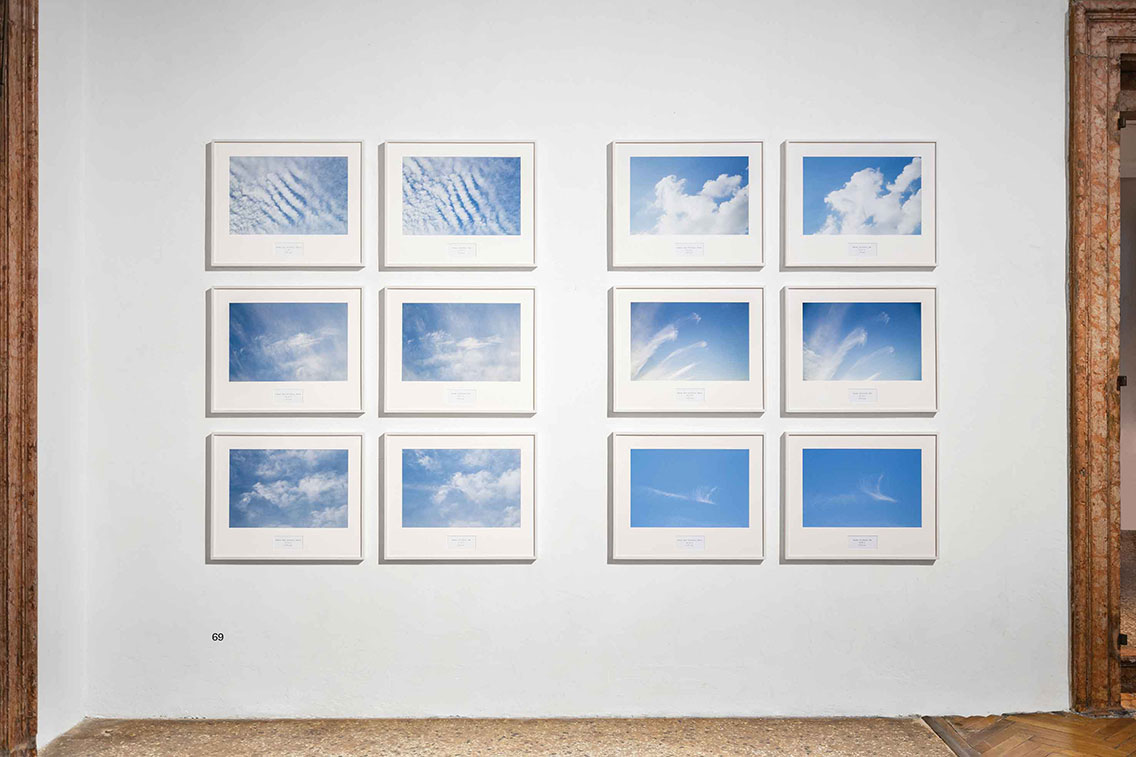
Untitled (2018)
Chantal Peñalosa
6 diptychs from the overall artwork, inkjet prints on photographic paper
53 × 64 × 3 cm each
Courtesy Galería Proyectos Monclova & Chantal Peñalosa
Photo: Marco Cappelletti
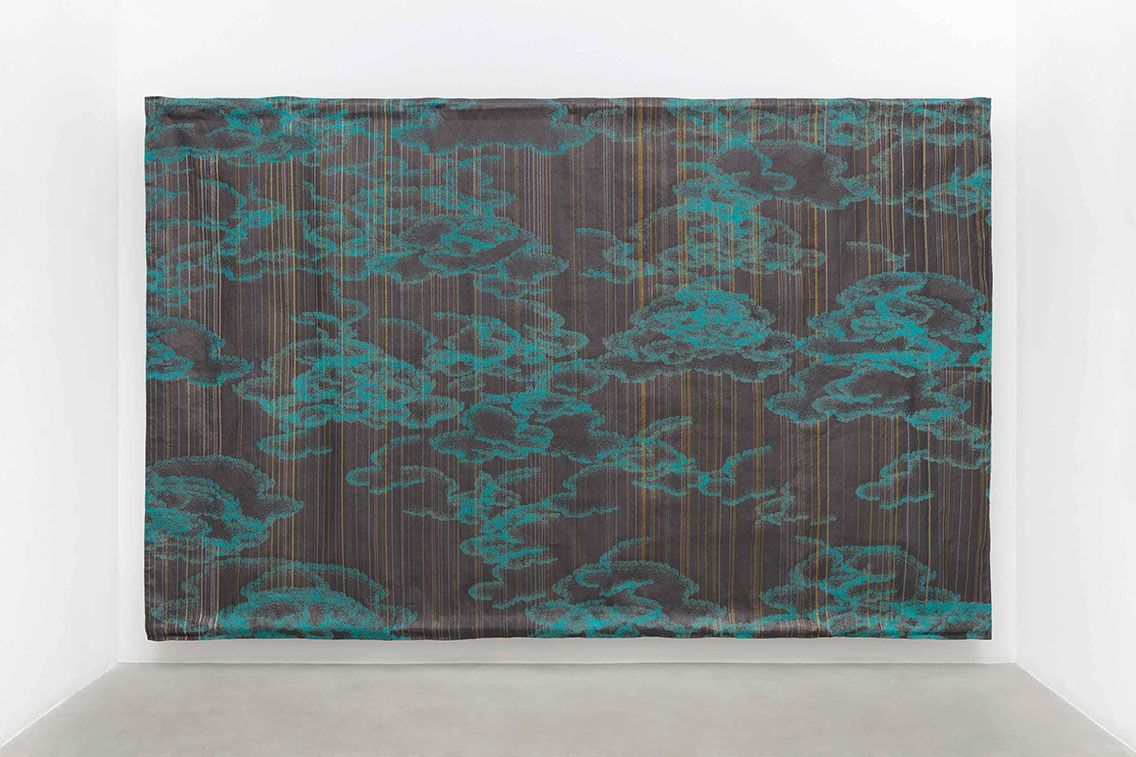

Photo: Marco Cappelletti
Kinked Rain / Gold (2022)
Pae White
cotton, polyester, Lurex 250 × 390 cm
Courtesy the artist and kaufmann repetto Milan / New York
Photo: Andrea Rossetti
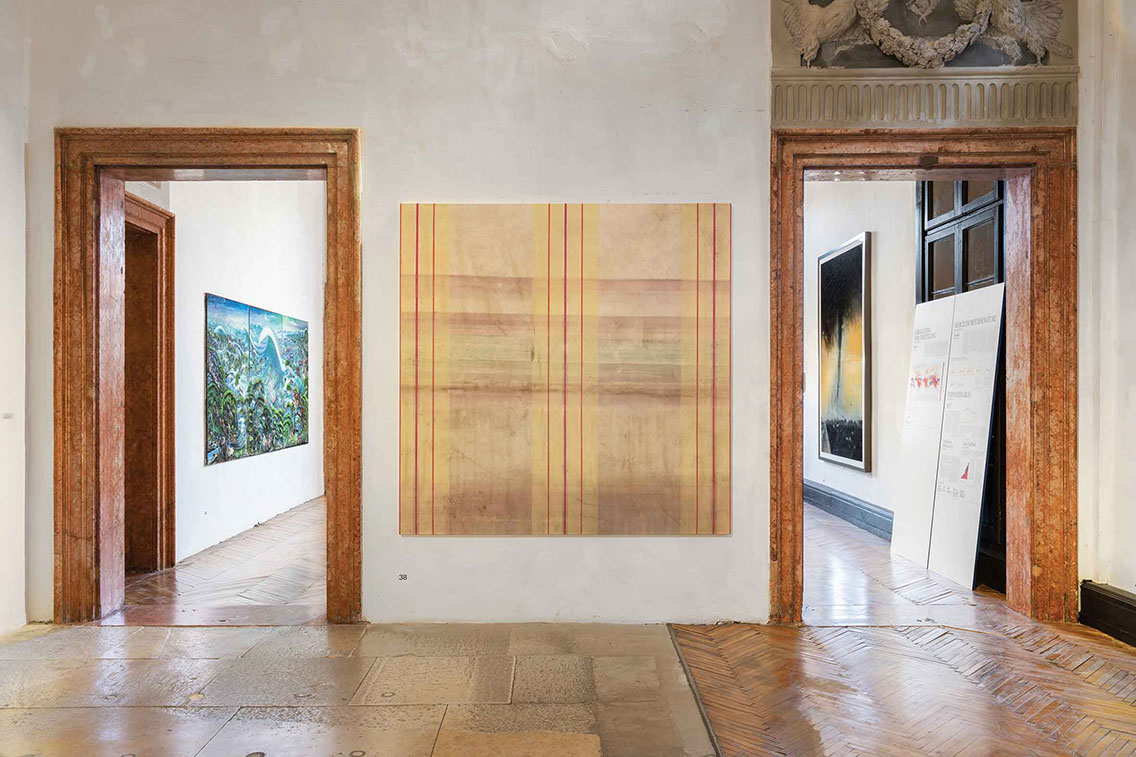
Untitled (indipendenza studio #3) (2012)
Fredrik Værslev
primer, spray paint, corrosion on cotton canvas
220 × 200 cm
Private collection
Photo: Marco Cappelletti

Untitled, 2023
Pieter Vermeersch
oil on marble
32 × 52 × 2 cm
Courtesy the artist and P420, Bologna
© Pieter Vermeersch by SIAE 2023
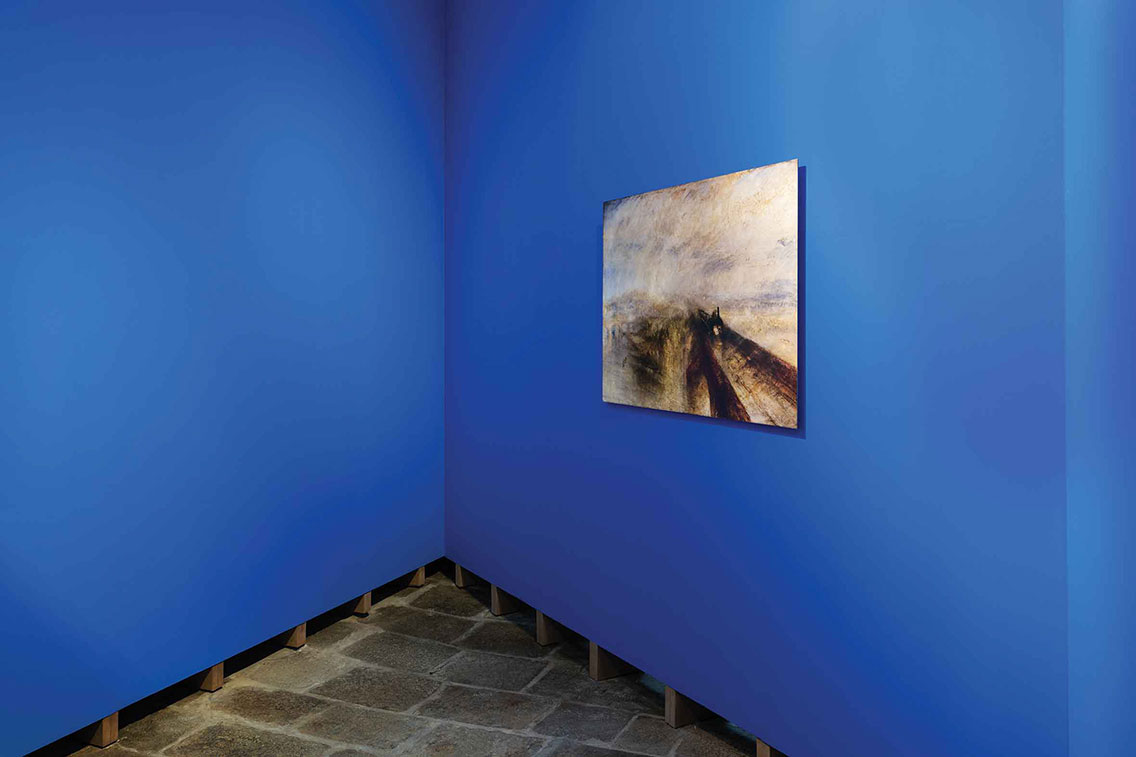
Troubled Air: Tribute to Sunn O))), 2023
Pieter Vermeersch
A specially commissioned site-specfiic installation
Courtesy Galerie Greta Meert (Brussels), Galerie Perrotin (Paris, Hong Kong, New York, Seoul, Tokyo, Shanghai, Dubai), ProjecteSD (Barcelona), and P420 (Bologna)
Photos: Marco Cappelletti
Above credits for this page and next four pages.
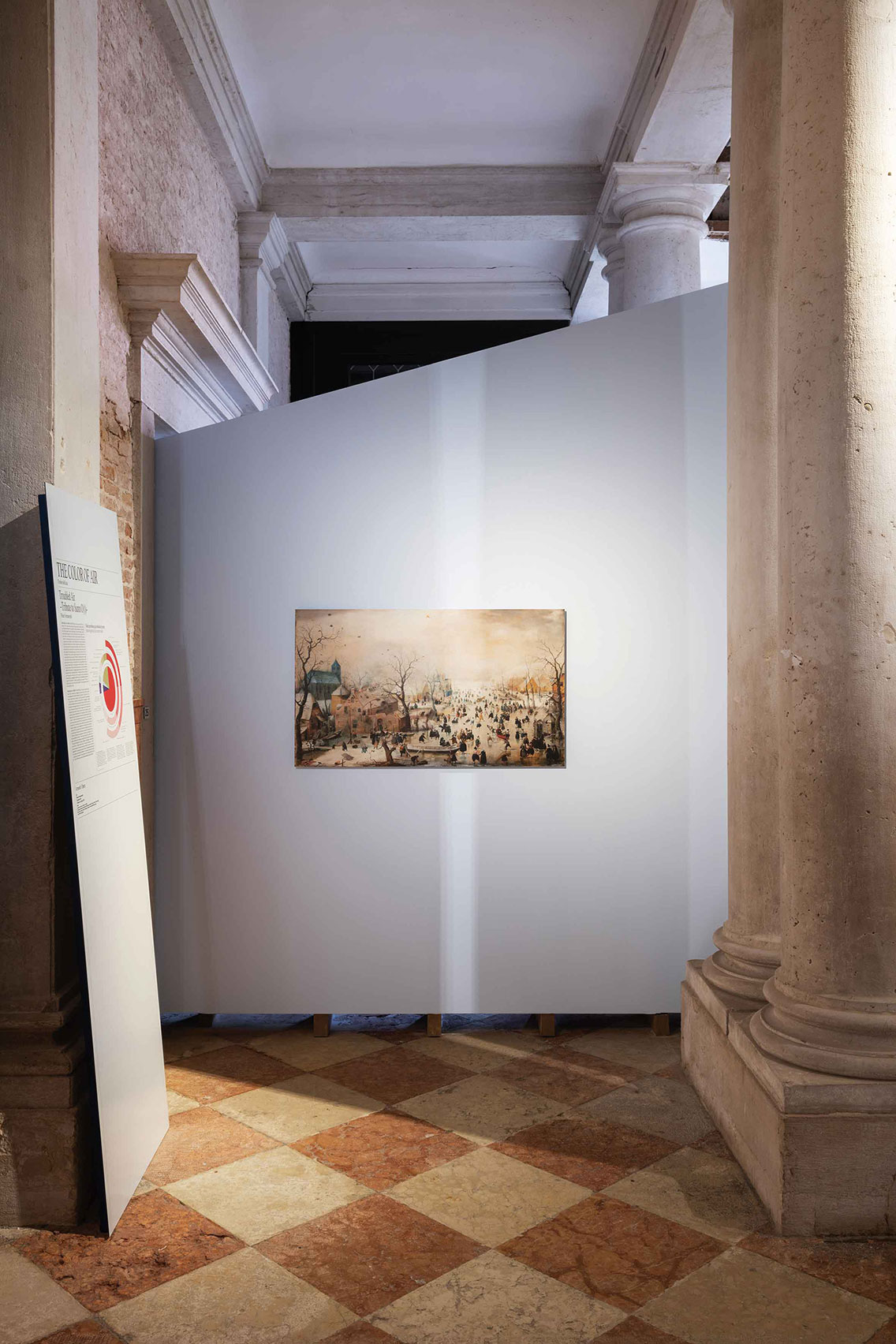
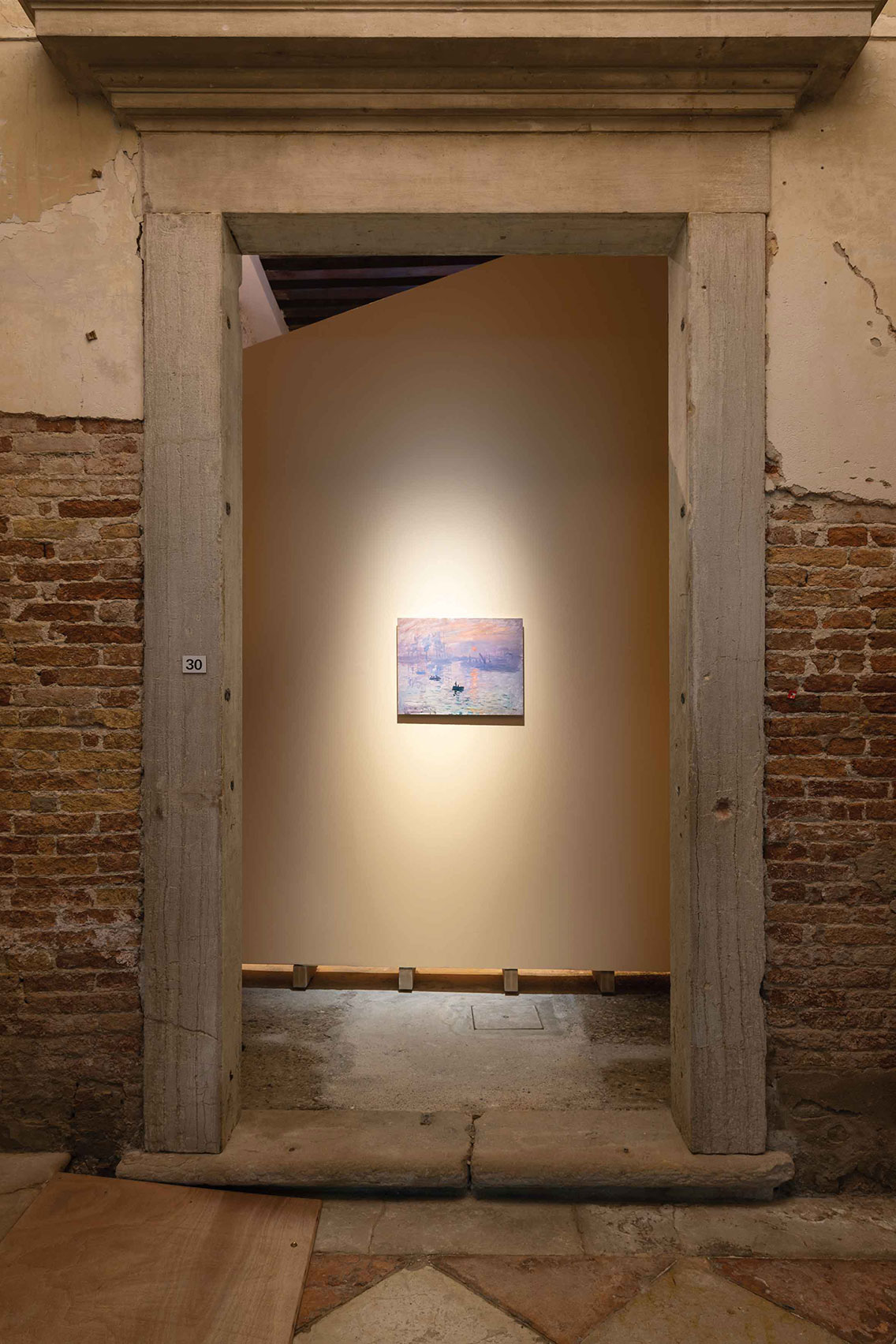
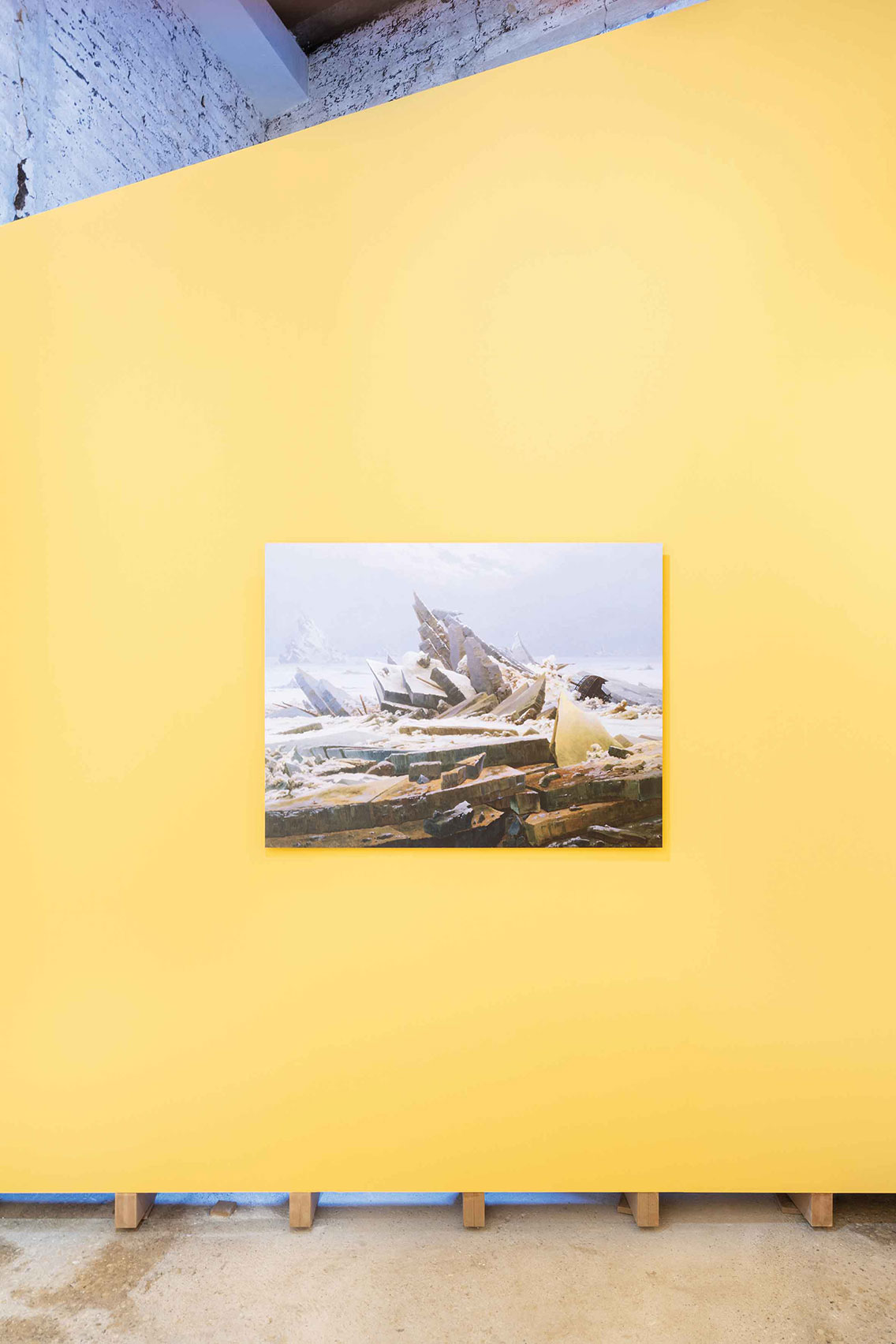
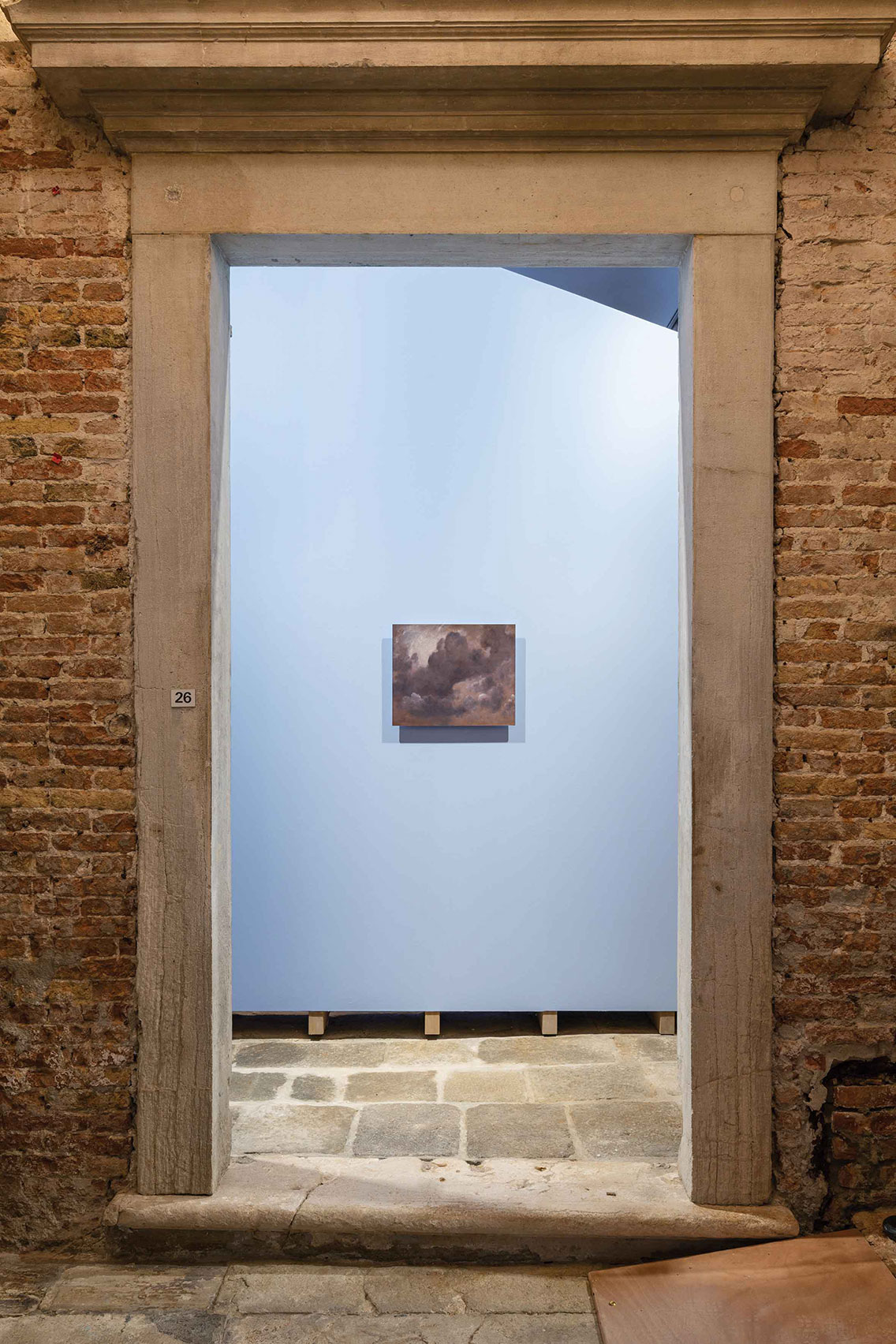
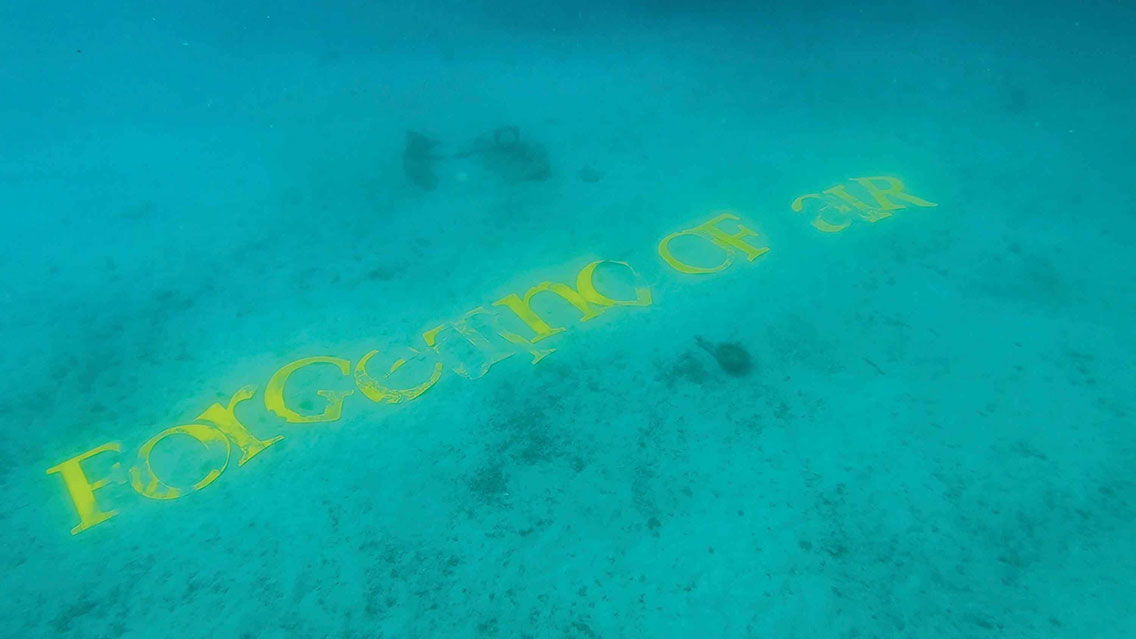
Deep Breath (2019/2022)
Raqs Media Collective
single screen digital video projection, 25’
Courtesy the artist and Frith Street Gallery, London
Deep Breath film still 2019/2022
© Raqs Media Collective, courtesy the artist and Frith Street Gallery, London
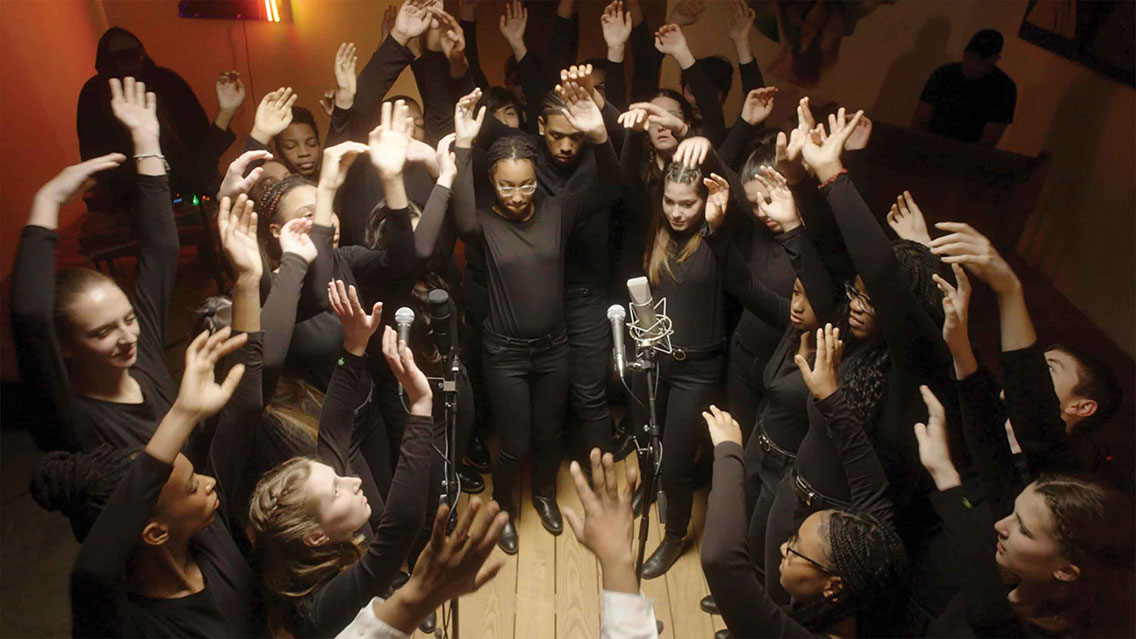

Photo: Marco Cappelletti
The Flood (2023)
Theaster Gates
colour video with sound 16’9’’
video still
Theaster Gates Studio © Theaster Gates Studio
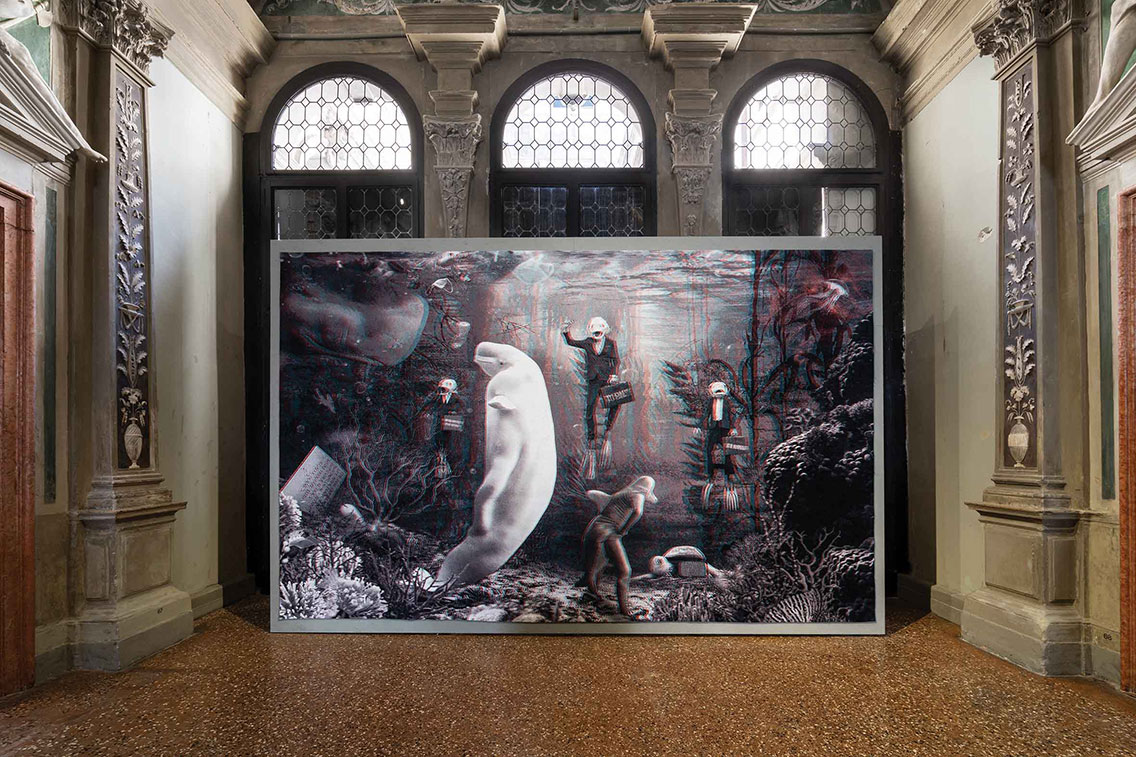
Who Gave Us a Sponge to Erase the Horizon? (2022)
Goshka Macuga
woven tapestry
290 × 460 cm
edition of 5 + 2 AP
Courtesy the artist and Kate MacGarry, London
© Goshka Macuga by SIAE 2023
Photo: Marco Cappelletti
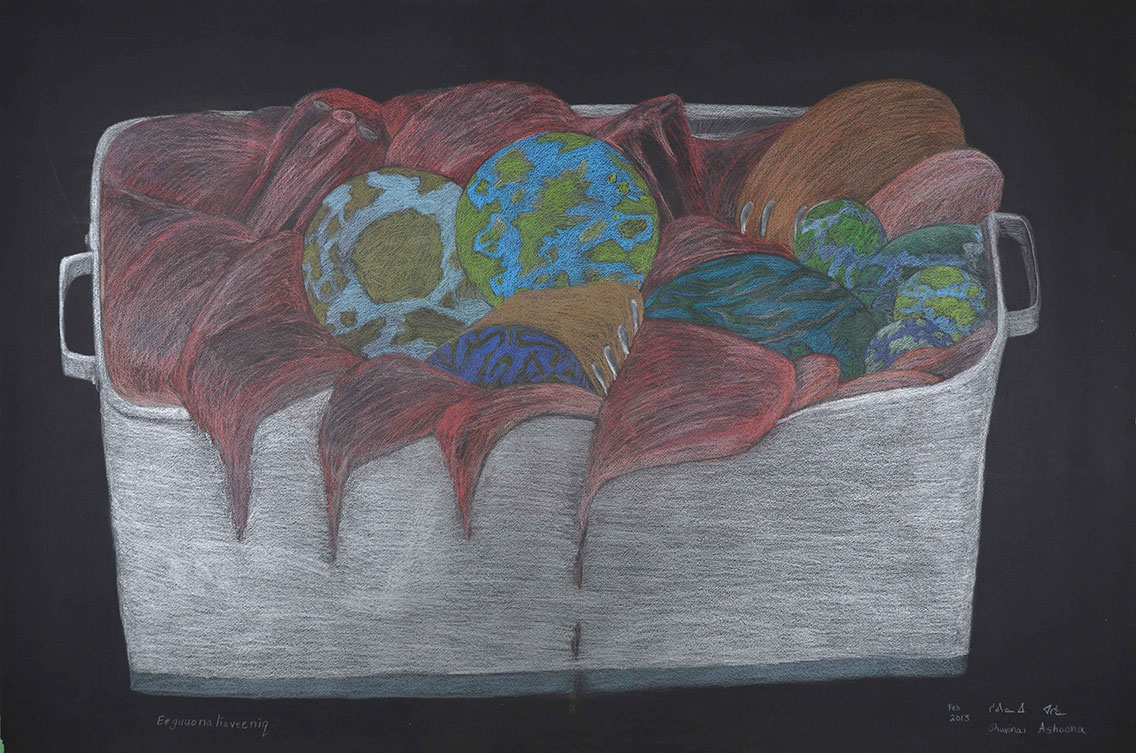
Going with Melting (2016)
Shuvinai Ashoona
coloured pencil and ink on paper
58.5 × 76.1 cm
Toronto, Dorset Fine Arts
Courtesy the artist
Photo: David Hannan
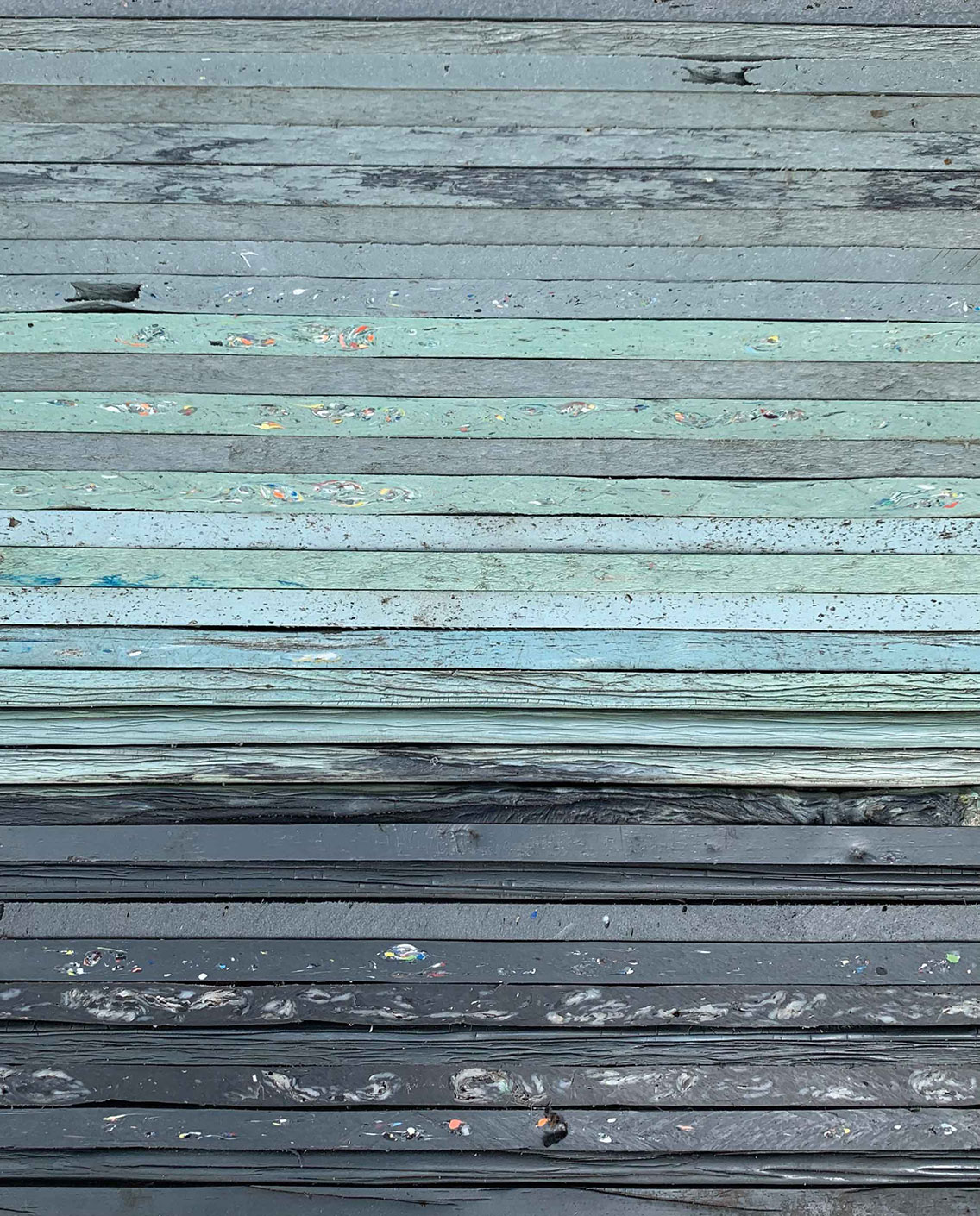
Plastic Horizon (w/distant weather event) (2014)
Dan Peterman
first generation post-consumer reprocessed plastics
40 × 52 × 6 cm
Courtesy the artist
Dan Peterman, Peterman Studio, Chicago, Illinois USA
Photo: Dan Peterman

How Does the World End (For Others)? (2022)
Beate Geissler & Oliver Sann
17 mounted and framed photographs, 37 mounted and framed typewritten pages
c. 1000 × 2500 × 50 cm
© Beate Geissler & Oliver Sann by SIAE 2023
Photo: Marco Cappelletti
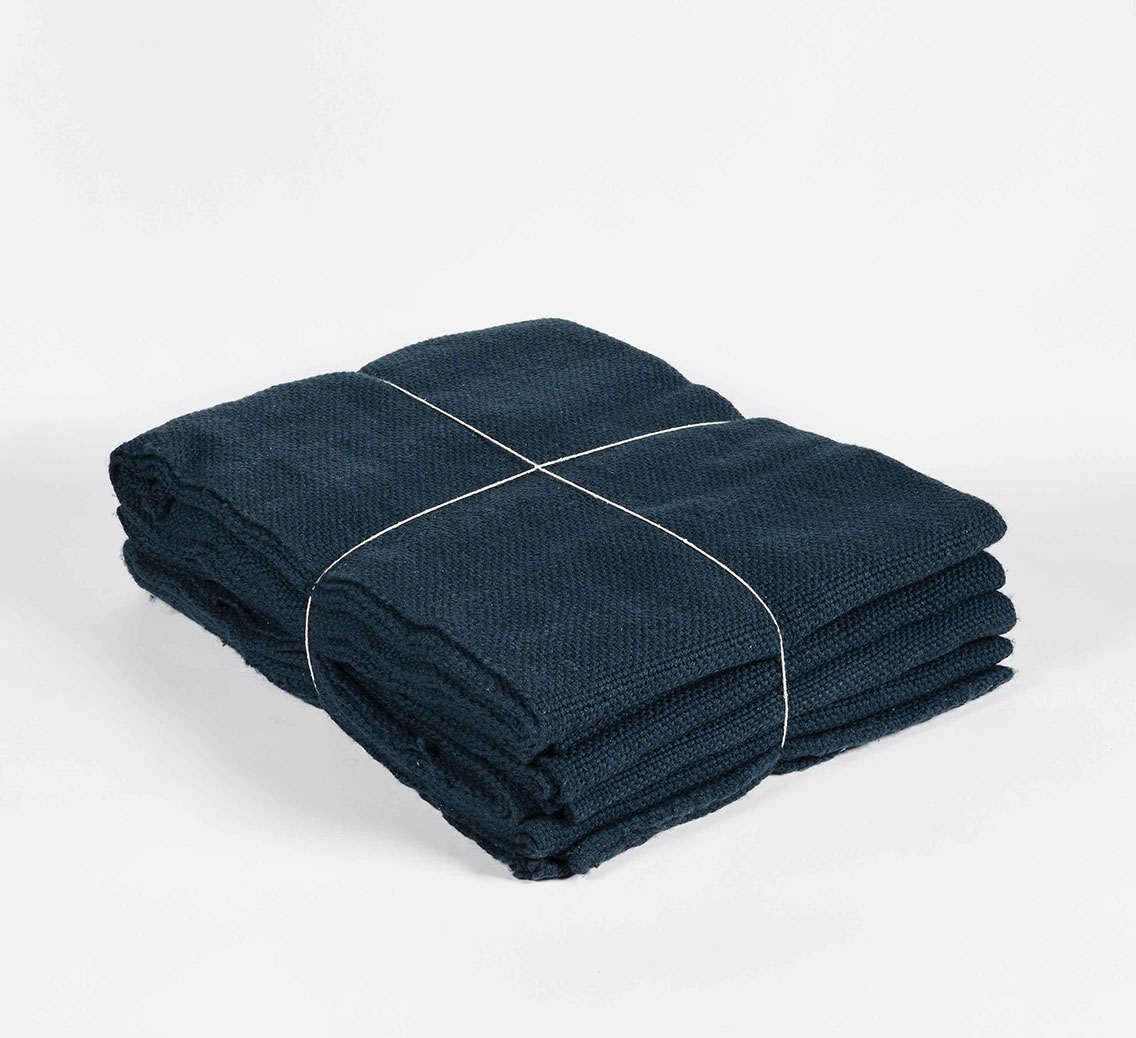
In Kashan, Iran, Pari Soltani dyed wool the color of night
and wove the distance from above the weather to the earth
Jason Dodge
Courtesy the artist and Galleria Franco Noero, Turin
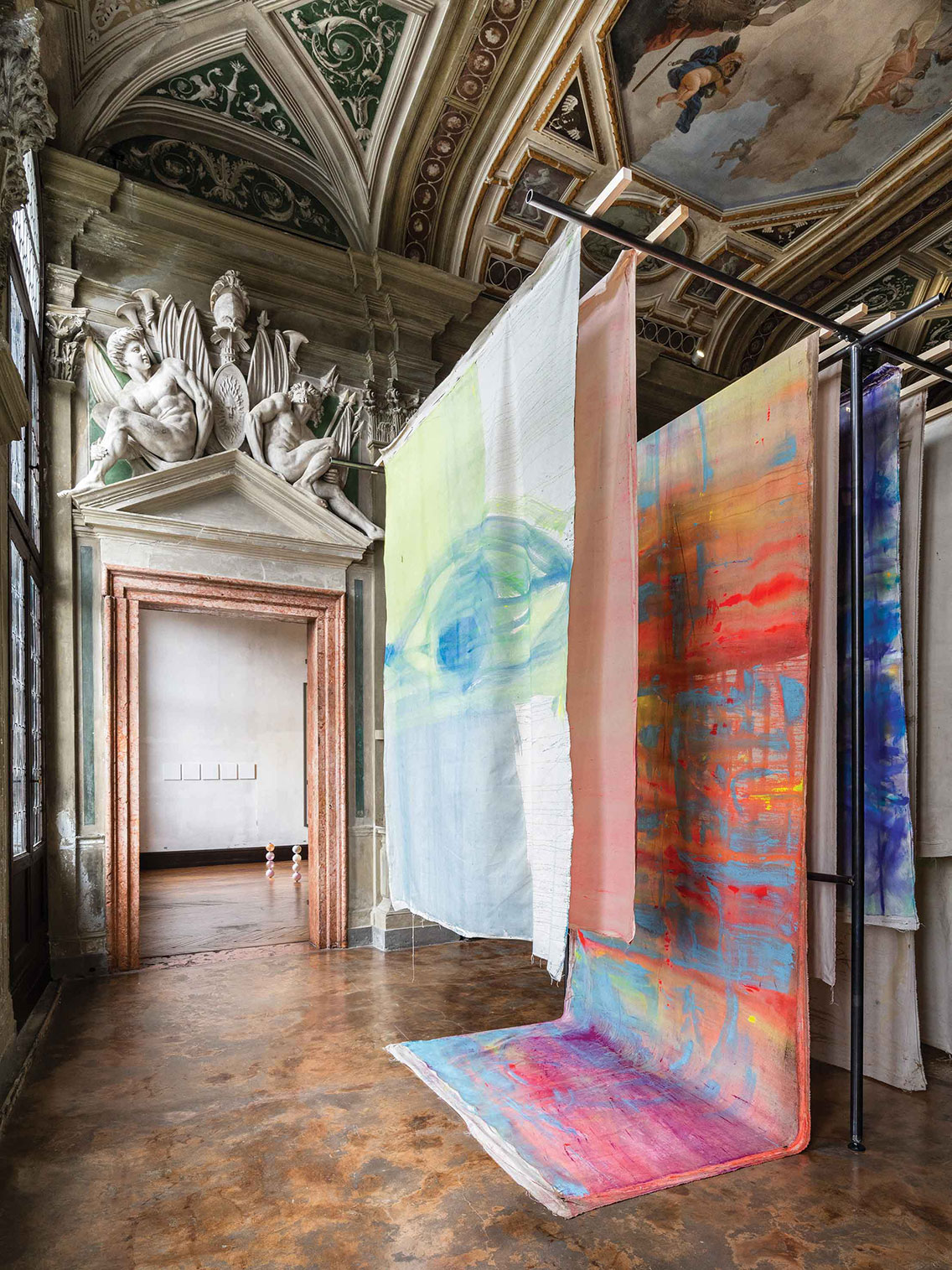
Untitled (2023)
Vivian Suter
mixed media installation
variable dimension
© Vivian Suter
Courtesy the artist and Karma International, Zurich; Gaga, Mexico City; Gladstone Gallery, New York/ Brussels; Proyectos Ultravioleta, Guatemala City; and Stampa, Basel
Photo: Marco Cappellitti

Photo: Marco Cappelletti

Interbeing Cloud 10.04 (2010)
Tsutomu Yamamoto
acrylic board, RGB, LED, glass, and MDF
91.2 × 45.7 × 11 cm
Geneva, The Jean Pigozzi African Art Collection
Courtesy The Jean Pigozzi African Art Collection
Photo: Maurice Aeschimann, Geneva
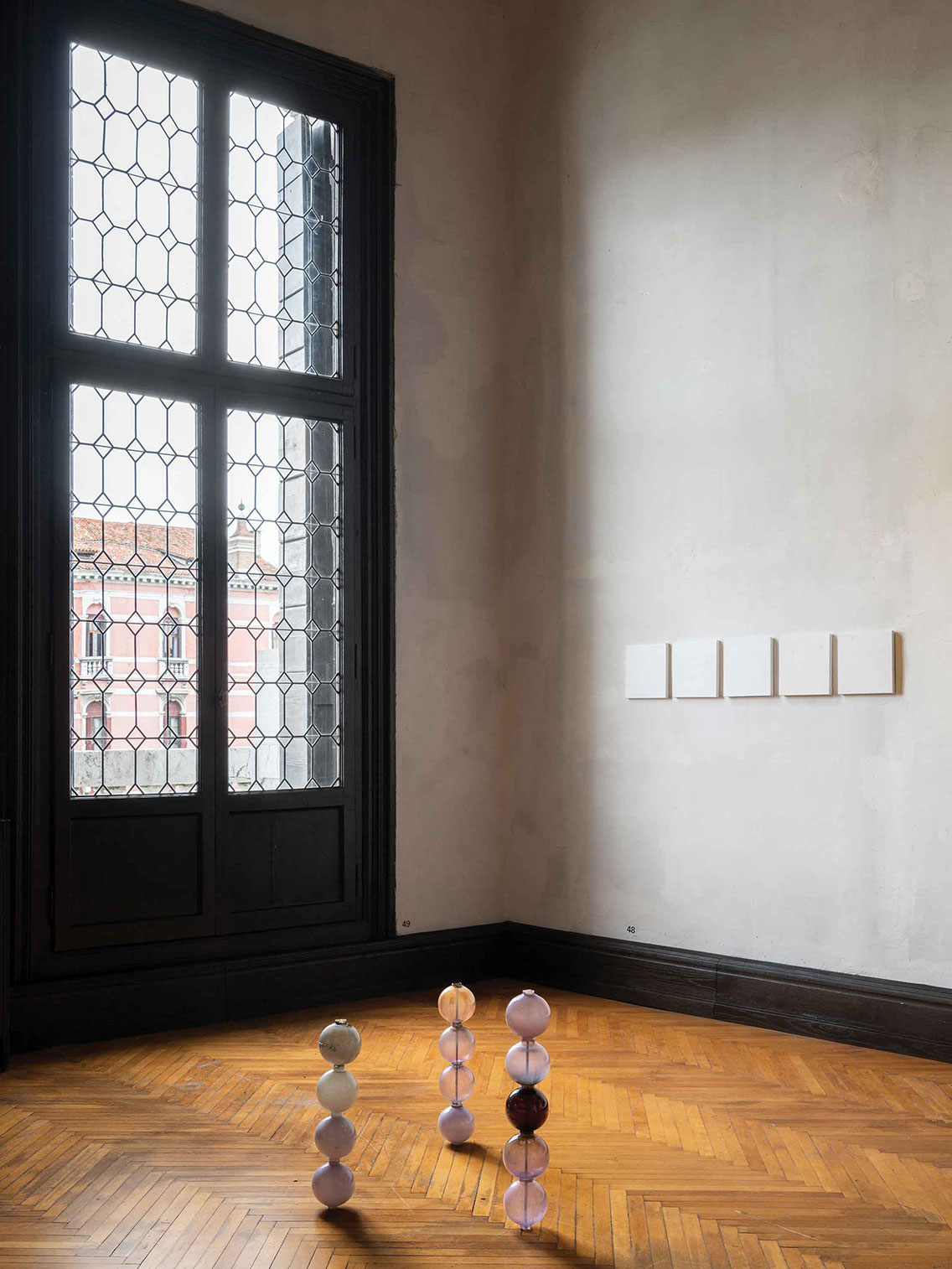
Moody (2019)
Nina Canell
lightning rod spheres (foreground)
Courtesy the artist and kaufmann repetto Milan / NewYork
© Nina Canell by SIAE 2023
Photo: Marco Cappelletti

A Wet Finger in the Air (2021)
Tiffany Sia
single-channel video 60’ in loop, infinite duration
edition of 3 + 2 AP
video still
Courtesy the artist and FELIX GAUDLITZ, Vienna
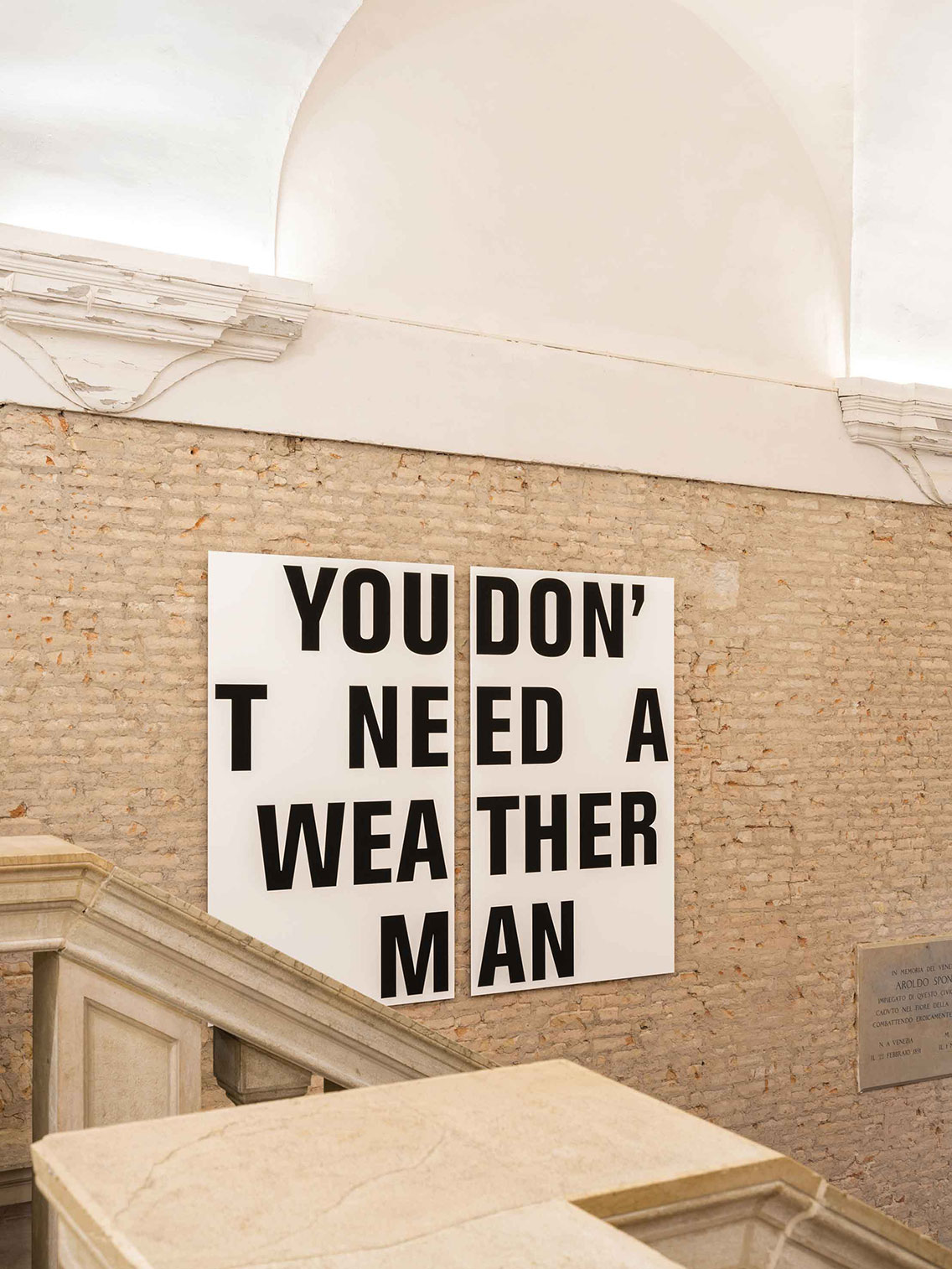
You Don’t Need a Weatherman (Version 3) (2017)
Iñigo Manglano-Ovalle
archival digital print mounted to panel
Diptych: 84.5 x 110 cm each panel
Courtesy the artist
Photo: Marco Cappelletti
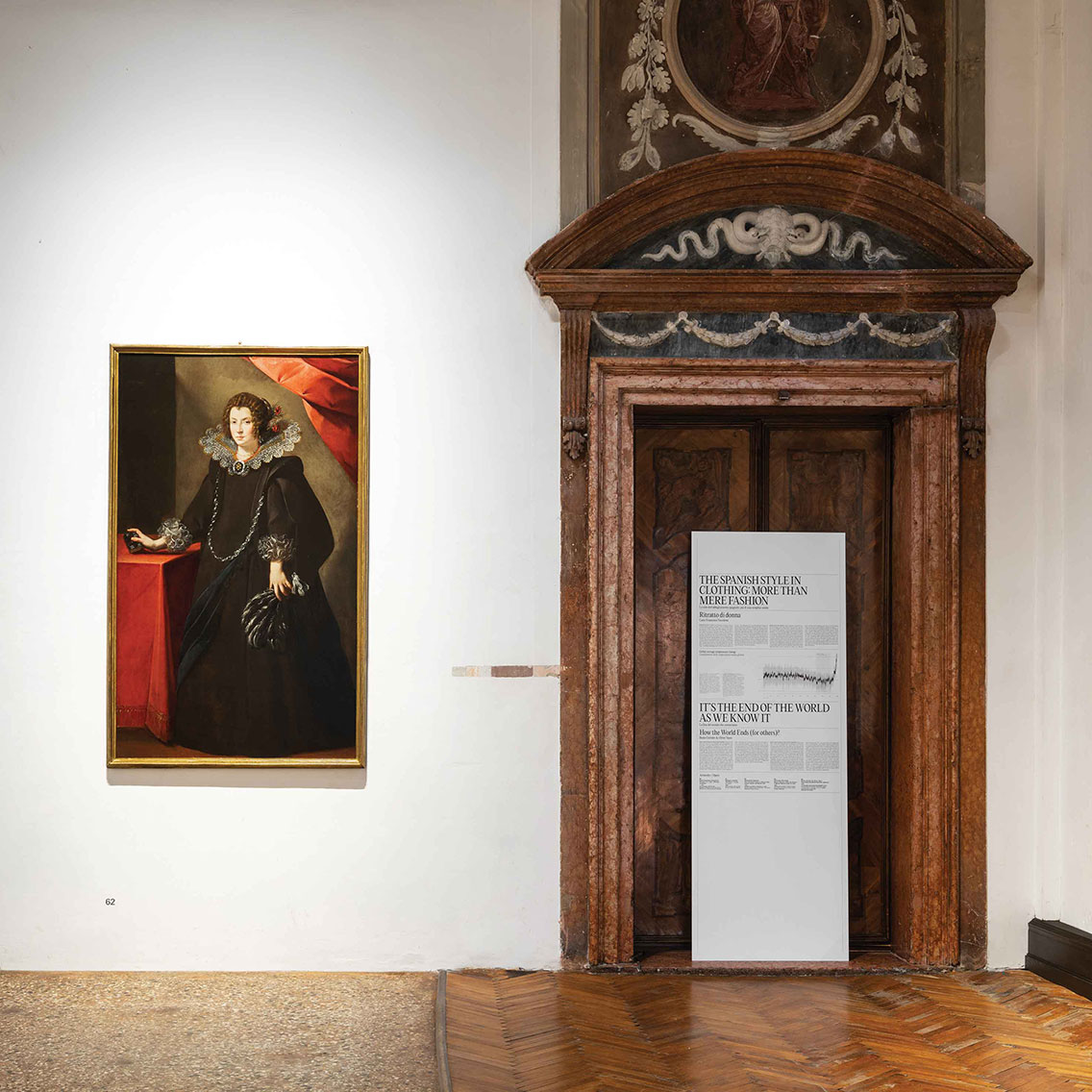
Portrait of a Lady (c. 1640)
Carlo Francesco Nuvolone
oil on canvas
201.5 × 120 cm
Bologna, Collezioni Comunali d’Arte – Musei Civici d’Arte Antica di Bologna
Photo: Marco Cappelletti

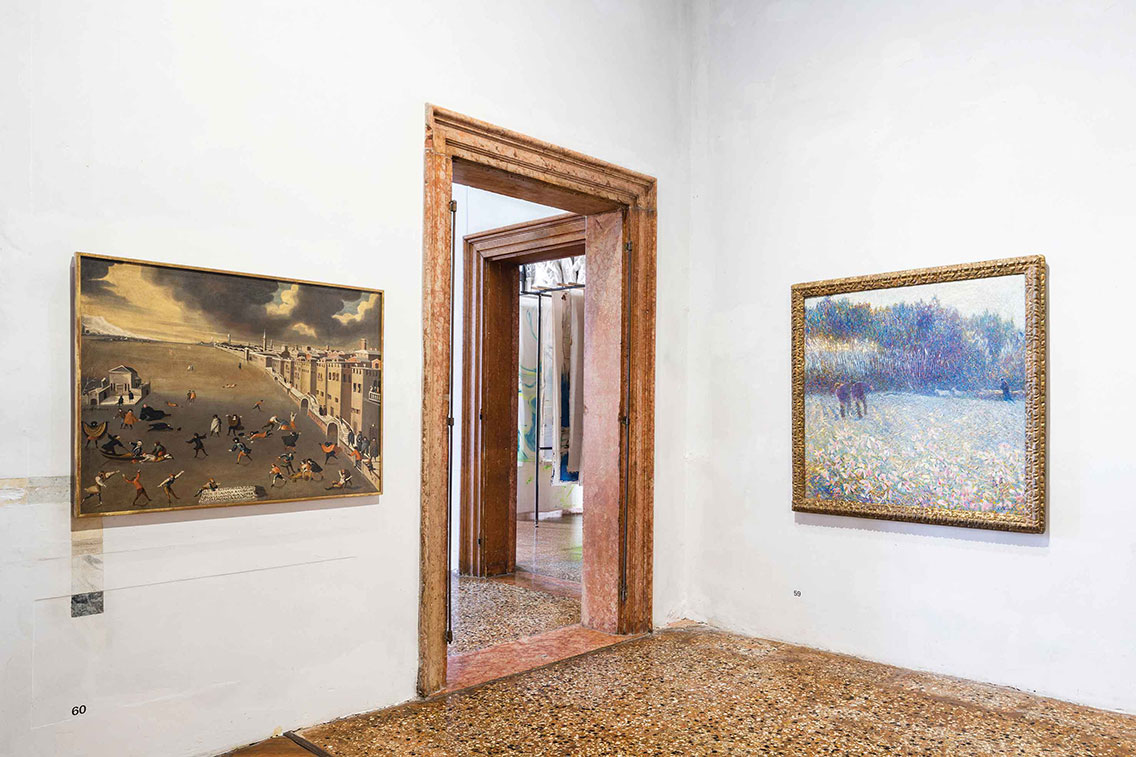
Photo: Marco Cappelletti
Sun and Frost (1905–10)
Plinio Nomellini
oil on canvas
125 × 125 cm
Novara, Galleria Giannoni, Musei Civici di Novara
© Centro Documentazione Musei Civici
Artists in order of appearance:
La laguna ghiacciata alle Fondamenta Nuove (The Frozen Lagoon at the Fondamenta Nuove) was painted by anonymous Venetian artists in 1709.
Thomas Ruff (b. 1958 in Zell am Harmersbach, Germany) is a German photo-artist who lives and works in Düsseldorf.
Alix Ogé (birth date unknown) was a 20th-century Haitian painter.
Richard Onyango (b. 1960 in Kisii, Kenya) is one of East Africa’s leading painters.
Antony Gormley (b. 1950 in London, UK) is a British sculptor.
Yang Yongliang (b. 1980 in Shanghai, China) is a Shanghai-based artist trained in traditional Chinese painting and calligraphy.
Vija Celmins (b. 1938 in Riga, Latvia) is an American artist best known for her photo-realistic drawings of natural phenomena.
Chantal Peñalosa Fong (b. 1987 in Tecate, Mexico) lives and works on and across the border between Mexico and the United States of America.
Pae White (b. 1963 in Pasadena, USA) is a Los Angeles-based artist best known for her large-scale tapestries.
Fredrik Vaerslev (b. 1979 in Moss, Norway) is a painter working in the expanded field of abstraction.
Raqs Media Collective was founded in Delhi, India, in 1992 by independent multi-media artists and researchers Jeebesh Bagchi, Monica Narula, and Shuddhabrata Sengupta
Theaster Gates (b. 1973 in Chicago, USA) is a multidisciplinary artist working at the intersection of social practice and installation art.
Goshka Macuga (b. 1967 in Warsaw, Poland) is a London-based installation artist widely known for her research-based projects.
Shuvinai Ashoona (b. 1962 in Cape Dorset/Kinngait, Canada) is an Inuk artist who works primarily in drawing.
Dan Peterman (b. 1960 in Minneapolis, USA) is a pioneer of ecologically themed installation art who lives and works in Chicago
Oliver Sann (b. 1968 in Düsseldorf, Germany) and Beate Geissler (b. 1970 in Neuendettelsau, Germany) work collaboratively in a range of photo-based practices.
Pieter Vermeersch (b. 1973 in Kortrijk, Belgium) is a color-field painter currently based in Turin, Italy.
Jason Dodge (b. 1969 in Newton, USA) is a sculptor and installation artist who lives and works on the Danish island of Møn.
Vivian Suter (b. 1944 in Buenos Aires, Argentina) is a Swiss artist who lives and works in Panajachel, Guatemala.
Tsutomu Yamamoto (b. 1980 in Okayama, Japan) is a Tokyo-based chronicler of natural phenomena at their most evanescent.
Nina Canell (b. 1979 in Växjö, Sweden) is a sculptor and installation artist based in Berlin.
Tiffany Sia (b. 1988 in Hong Kong) is an artist, filmmaker and writer living in New York.
Iñigo Manglano-Ovalle (b. 1961 in Madrid, Spain) is a Chicago-based artist primarily working in the expanded field of “social sculpture”.
Carlo Francesco Nuvolone (b. 1608 in Milan, Italy; d. 1662 in Milan, Italy) was the leading painter of the baroque in Lombardy.
Plinio Nomellini (b. 1866 in Livorno, Italy; d. 1943 in Florence, Italy) was a painter active in a range of post-impressionist styles.
Essays
Three Weather Reports on Burning Air
Our atmosphere is open and fluctuating, susceptible and conditioned by many human interferences; noise, industrial burning, exhaust fumes and our own exhalations. Weather emerges in momentary configurations of elements, energies, and forces, including the crowded, human-inflected air chemistry that effects catastrophic shifts in climate. I narrate a series of atmospheric encounters, weather reports of a kind, about three recent artworks that bear witness to our immediate and future weathers and the longer temporalities of climate heating. The first report is Scottish artist Katie Paterson’s collective ceremony To Burn, Forest, Fire (2021–2024); the second is Mithu Sen’s installation I Bleed River 2124 (2024) from New Delhi; and finally, theatre director Zuleikha Chaudhari’s fictional performance In the Matter of the Rights of Nature—A Staged Hearing (2023) that took place in Chandigarh.
I breathed in the aromas of Paterson’s incense burning ceremony in Tāmaki Makaurau, Auckland, shared through the World Weather Network, a global network of artists, writers and communities responding to the climate crisis.1
Paterson’s ceremony, including incense sticks sent by mail, was performed over more than a year in many parts of the world, offering a collective moment of pause to inhale and remember the evolution of forest life through our lungs. I suggest that such sensorial actions fold into an understanding of the urgent action required of us all to mitigate the ecological crisis. In a recent visit to Delhi, I spoke to Mithu Sen and Zuleikha Chaudhari about their respective installation and performance works that foreground anthropogenic permutations of air. These two latter artworks were commissioned by Khōj International Artist Association in New Delhi, an organisation who are also part of the World Weather Network, and who have long explored questions around the role of art in atmospheric politics.
Weather appears as an artists’ live medium, yet weather always slips beyond our control, and now the runaway effects of climate crisis inflect every conversation about the weather. This article eddies around the weather conditions suffusing these artworks in a form of bodily climate witnessing.2 They each directly or indirectly advocate for the Rights of Nature, along with social justice, drawing rituals of breath, speculative aesthetics and ‘experimental jurisprudence’3 into their weather-worlding.
1 March 2023, 25 °, AQI 21, Cockle Bay, Aotearoa New Zealand
On a clear summer day, we lift back the orange-and-white-striped hazard tape surrounding the four-hundred-year-old pōhutukawa tree named Te Tuhi a Manawatere (the mark of Manawatere). I clutch Scottish artist Katie Paterson’s instruction booklet for the ceremonial artwork To Burn, Forest, Fire in my hand. James Tapsell-Kururangi has already set up the incense sticks that tightly hold the aroma of the first and last forests, along with a bell on a small wooden table. Commissioned by the Finnish art organisation, IHME Helsinki in 2021, a partner organisation in the World Weather Network, Paterson’s contemporary incense ritual To Burn, Forest, Fire4 is hosted in Aotearoa by Te Tuhi. Director of Te Tuhi, Hiraani Himona and I represent the World Weather Network programme, however the event is led by female Tangata Whenua, the Indigenous people of this place. Through mail, we (and a dozen or more small arts organisations in the World Weather Network) received Paterson’s incense sticks carefully packaged and with instructions. The IHME Helsinki commission emerged from Paterson’s practice of amplifying sensorial connection to our fast-diminishing natural heritage across vast time scales, from forests to glaciers, at this critical time of sixth mass extinction5 for plants and other species.
The sacred tree where we gather has been marked off with the orange/white tape by council tree workers as broken branches have just been removed. Within the last six weeks two severe cyclones—Cyclone Gabrielle and Cyclone Hale—have slashed a saturating and deadly path through the North Island of Aotearoa New Zealand. People have died, animals have been washed away, houses have been destroyed, and many pōhutukawa trees have tumbled into the sea. These fallen giants once grew at perilous angles on cliffs in coastal regions, where their ropey spreading roots played a vital role in stabilising our shorelines. But edges of land once stable in the clement Holocene6 collapse in the carbon-soaked air and increasingly turbulent weather.
Today, the group is fanned by a light sea breeze. To begin To Burn, Forest, Fire, kuia (elder) Taini Drummond leads the assembled group towards the enduring tree. She performs a karakia, a ritual incantation. We sing a waiata, a song that Taini has composed for this ceremony, her words reaching back in time to the ancestor and astral traveller Manawatere who once marked this tree so future travellers by waka (canoe) would know the way to the shores of Aotearoa. Te Tuhi’s Pou Ārahi (principal cultural advisor), Carla Ruka plays pūtangitangi (flute) releasing gentle sounds that mingle with cicadas and the lapping sea. Taini leads us forward beneath the ancestor tree. The group of about twenty people, Te Tuhi’s elders, the perpetuals, quietly tread the carpet of leathery leaves and the low spreading branches. I slowly begin to read Paterson’s introductory text, and as instructed, I ring a small brass bell to commence the incense burning of the first and last forest.
James lights the First Forest, a bright green incense stick releasing scents from the oldest known forest in Cairo, New York State by the Hudson Valley, a forest that lived 385 million years ago. A thin curl of smoke mixes with the ozone from the ocean. The buried forest was discovered through fossilised root systems containing three types of ancient plant species, including Archaeopteris, which had well-developed roots, a large trunk and branches with leaves, akin to our pōhutukawa’s complex root systems. Paterson collaborated with the Japanese perfumers and incense makers Shoyeido, and with geologists to characterise these forests with aromas. The incense diffuses molecules of a very specific type including basic, identifiable elements from the ancient Devonian era environment before plants evolved to bloom with sugary flowers or fruits; the ancient forest soil was damp, the plants were something like what we know as mosses and ferns. There would have been no carpet of leaf-litter as there is today under our pōhutukawa, with its fingery red flowers, as deciduous species had not yet evolved.
One by one our assembled group inhales the incense scent of this transported ancient world. Carla Ruka has also set out a bowl of karamea, red ochre from a neighbouring soil, and each person dips their fingers in the pigment, then touches their hands to the ancient rough grey bark of the tree. Time becomes circular as we reenact the primordial mark of Manawatere. The touching is an attuning to the tree, to the many weathers the tree contains.
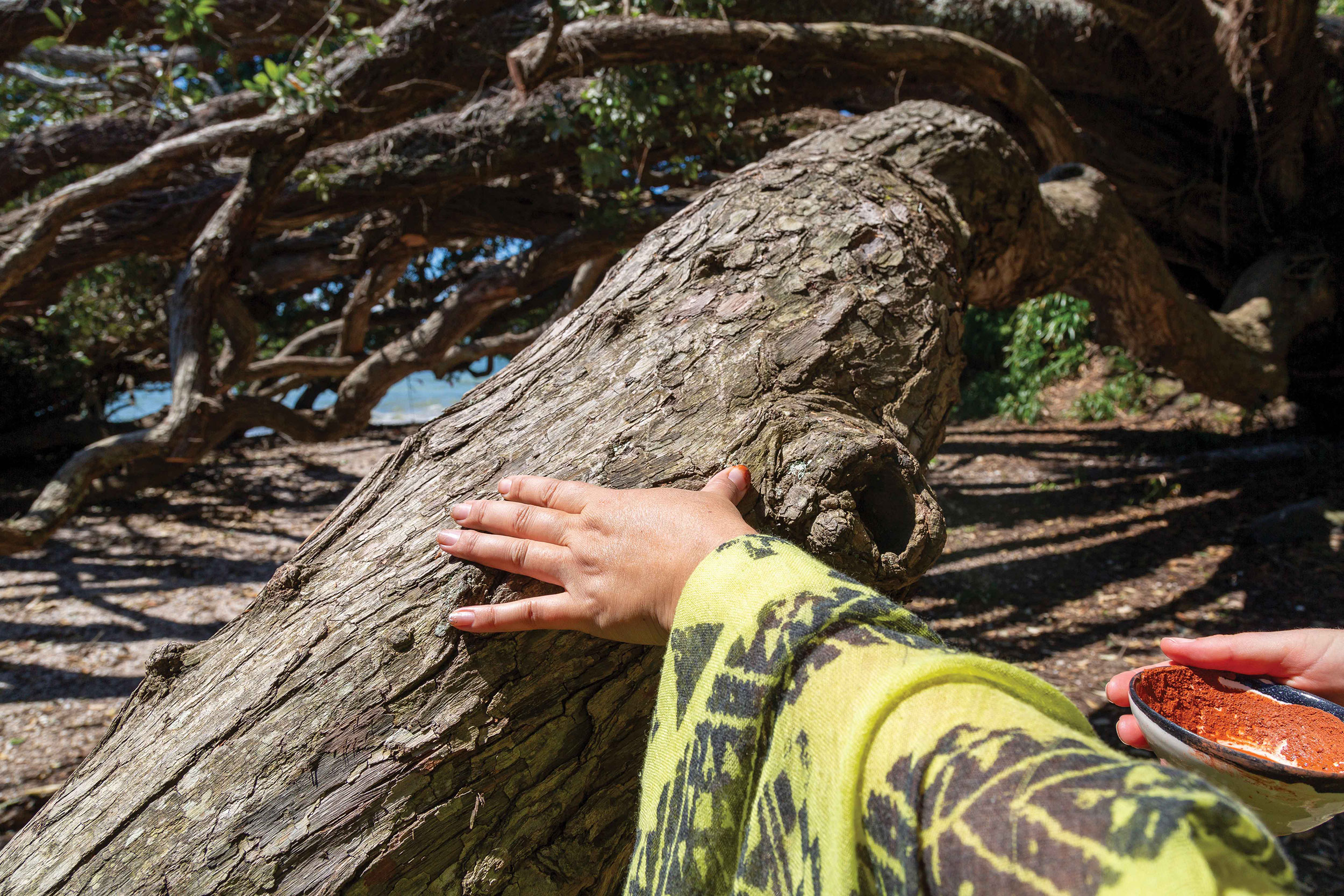
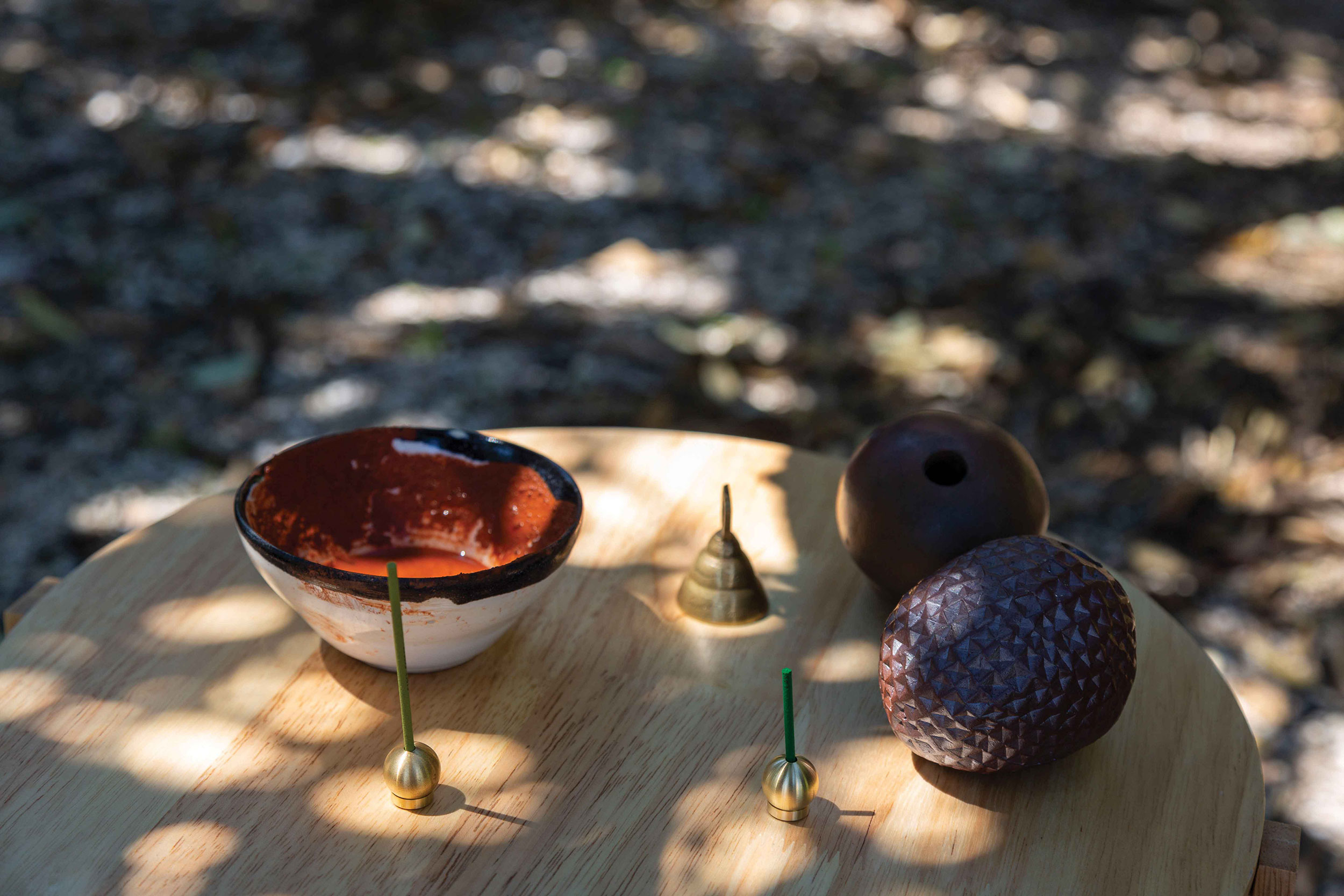
Katie Paterson, To Burn, Forest, Fire (2021–2024). An ancient pōhutukawa tree
named Te Tuhi a Manawatere is marked with karamea (red ochre) during the
incense ceremony hosted by Te Tuhi on 1st March 2023, Cockle Bay, Aotearoa
New Zealand. IHME Helsinki Commission 2021, shared on the
World Weather Network. Images courtesy of Te Tuhi.
I ring the bell again. When James lights the second, dark green Last Forest incense stick we are carried back to the present, to the scent of a living forest biome under threat from fire and human consumption: the Amazon Rainforest. For this aroma, Paterson’s collaborator, Dr. Ana María Yáñez Serrano introduced her research on airborne volatile organic compounds (VOCs) to describe the chemical constituents of the modern rainforest scents. The isoprene emitted by our pōhutukawa tree in Aotearoa melds with the molecules common to the trees and abundant plants in the Amazon. Yet the dozens of monoterpenes and sesquiterpenes unique to the Yasuní Biosphere Reserve in Ecuador, permeate the atmospheric chemistry of the gathering here in Cockle Bay. The tingling scent of the Tiputini station in Ecuador is described by Paterson and her collaborators as follows: “a stunning array of scents, from the alcoholic fizz of guava trees to the fresh peanut-like aroma of the Earth, all combining in a unique sweet and bitter fragrance of the modern Amazon.”7 Like the Amazon, in the past two years we have been subject to flood and fire. The reverent quiet that falls over the group suggests a deep biome vibration with the uncertain fate of this forest far from us.
According to geologist David George Haskell: “When volatile molecules, those chemicals that we call ‘aromas’, enter our nasal cavities, they bind to fragile microscopic hairs on receptor cells. These cells then signal to the deepest parts of our brain, neural centres where memory, emotion, and a sense of time reside. Aroma moves us, working below and at the edges of conscious awareness.”8 The scent in the air carries us back and forth across time and space, just as the roots of the pōhutukawa conjoin recall the primordial roots of the Devonian forest. We float back to the time of the mark of Manawatere, the ancient, astral voyager who travelled on a waka made of feathers; and back further, ten million years, to the time when pōhutukawa trees evolved and spread throughout Te Moana nui a Kiwa, the Pacific, carried on ocean currents.
Our ceremony at Cockle Bay fused our breath with ancient and present forest airs, collapsing distance, decelerating us, recalling species and plants that have disappeared or exist precariously as wildfires threaten the Amazon. Paterson’s ceremony invites the deep inhalation of the carefully constructed particulate she releases, rather than the thoughtless volatile compounds spat out by cars or the factories chasing multi-national capital. The act of inhaling approaches what Astrida Neimanis and Blanche Verlie (2023) call: “a mode of more-than-human witnessing” of climate catastrophe. They argue: “...to breathe climate catastrophe is to witness one’s own body-in-and-as-part-of-the-climate. Put otherwise: we are the climate change we witness.”9 We become the ancient trees and tempests to come, they dwell within our bodies. This attuning might invite us to suppress our toxic emissions in our everyday lives.
2 February 2024, 14°, AQI 425, New Delhi, India.
The air is gritty with metallic soot; through grey-yellow fog, a limpid sun. A weather App sends me a ‘SEVERE’ air quality warning. It‘s raining in intermittent bursts on the opening evening of the group show 28° North and Parallel Weathers. The curators have set the provocation: “What World opens up to us when we think of the body as a site for attuned sensing?”10 Wetness pervades the three tiers of gallery spaces around the open plan courtyard of Khōj International Artist Association in New Delhi, where my collaborator Rachel Shearer is performing a live electronic audio composition on the rooftop.11 The dirt road came awash with a fast micro-flood of the urban village of Khirkee and the damp swept up my long skirt, tugging at my skin; the rainwater an ever-present mediator of this encounter.12 We are in New Delhi through our work with Te Tuhi, a sister independent contemporary arts organisation to Khōj and IHME Helsinki, again conjoined in the activities of the World Weather Network. After two years of remote conversations between artists, scientists and writers among 28 small arts organisations, the WWN platform was launched online in 2022. We met in the making of creative weather reports with artists, writers, performers and scientists. Our parallel programmes metabolise and forecast matters of art, environmental justice and social inclusivity.
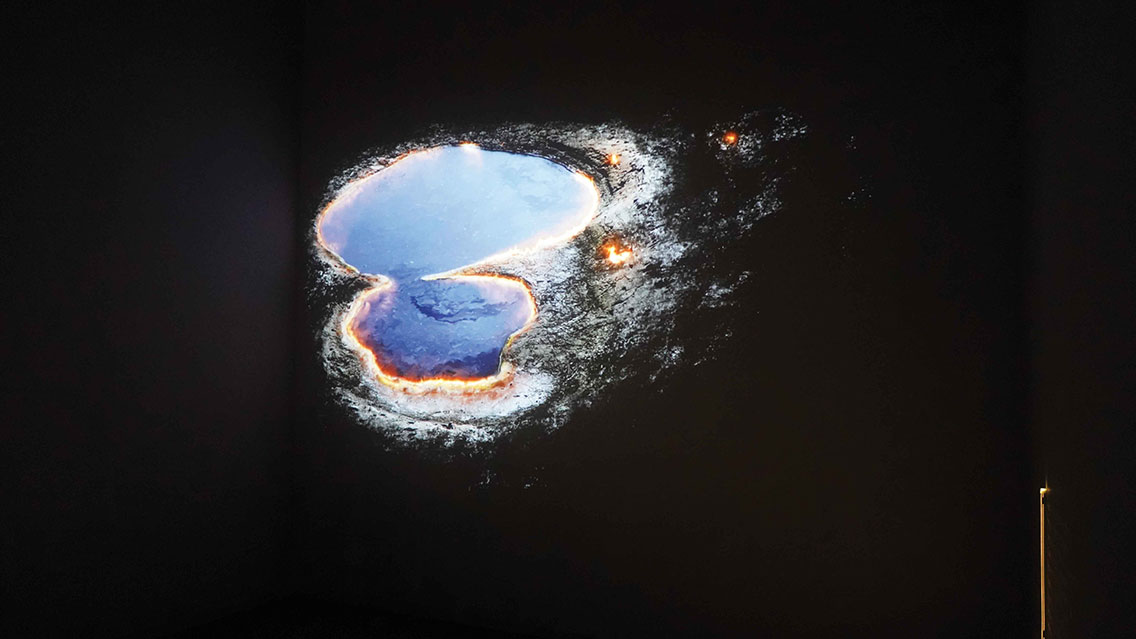
Mithu Sen, I Bleed River 2124. 28° North and Parallel Weathers, Khōj (2024).
Courtesy of Khōj International Artists’ Association.
I shelter at the edge of the courtyard with artist Mithu Sen, also exhibiting in Khōj. Sen is an inhabitant of New Delhi, born in West Bengal. As the rain falls heavily, we huddle in the reading room and talk about her installation I Bleed River 2124, where she traces the confluence of war and climate change. A projection of a burning river in toxic air dominates the room, while a smaller iPad narrates her journey along the present trans-boundary river, the Brahmaputra. The river, of rapidly diminishing width, and heavily compromised water quality flows through Tibet, Northeastern India, and Bangladesh, and has different names including the Luit in Assamese, Yarlung Tsangpo in Tibetan, and the Jamuna River in Bengali. For their World Weather Network project, Khōj invited artists to take a journey along the 28th Parallel North Latitude—which passes through Mount Everest in Nepal, the Northern Himalayas with Rajasthan in India and the Sindh Desert in Pakistan. This imagined cartographic line is an entry point for Sen and other artists in this exhibition at Khōj to speculate on future weathers of the ongoing climate crisis and the violent nature of the increasingly militarised human borders across the continent. A neon tube leads us from the gallery’s interior to the external courtyard and the date 2124, one hundred years from our wet present. Sen’s accompanying text reads:
Once upon a date, there existed a river named River sacrificially immersed in a distant inferno sparked by bombings, fundamentally altering the narrative of what was once known as a river. The flames from a faraway bombing ignited the river and became a transformative force, shaping a new storyline for this ethereal being in a tangible setting.13
In the Weather Glossary of artists’ terms that accompanies the exhibition, Sen has recorded the latitude of locations of 21st century wars: Baghdad; Gaza strip; Khartoum; Mariupol; Myanmar, West Bank and timestamps in the artwork draw parallels between the point at which they have been recorded in India. Sen’s speculative installation forecasts deadly flames from missiles dropping like rain from the air, recalling philosopher Peter Sloterdijk’s ‘dark meteorology’ that attempts to destroy the combatant’s environment through poisonous gas.14 Anthropogenic wars collide with indifference to the changing climate.
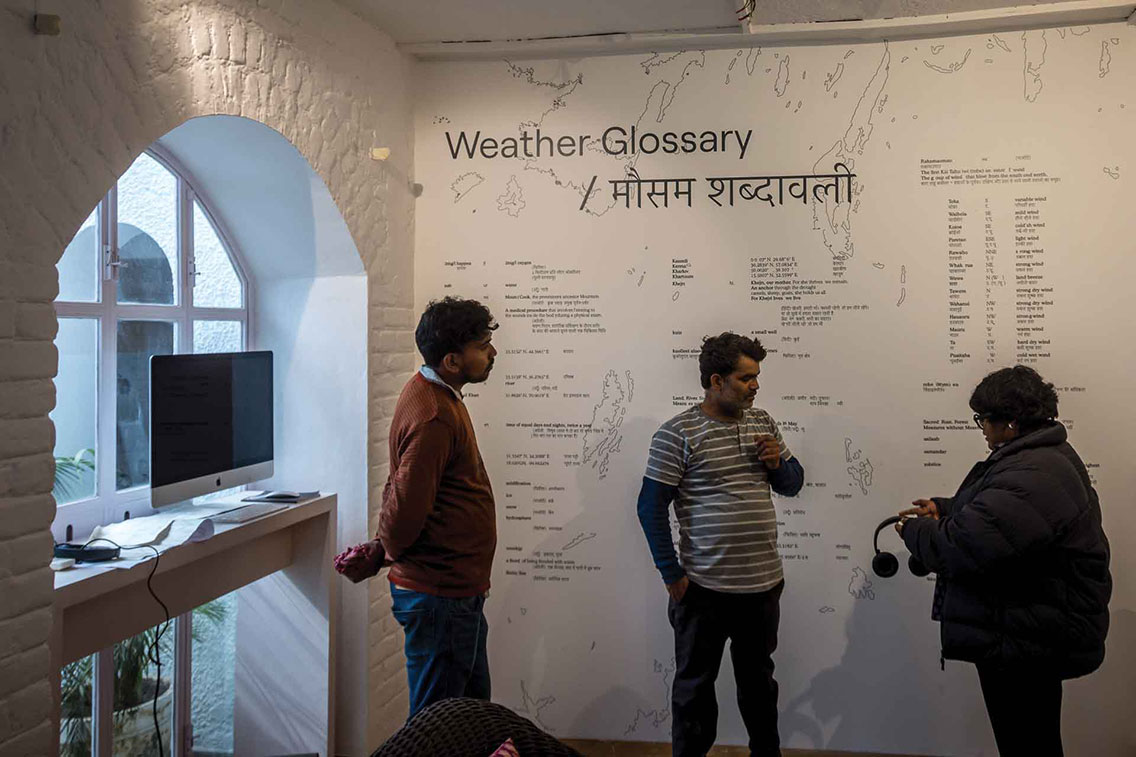
Weather Glossary, Reading Room at Khōj. 28° North and Parallel Weathers, Khōj (2024).
Courtesy of Khōj International Artists’ Association.
The morning after the deluge, we visit the India Art Fair in Okhla, New Delhi. Passes scanned and bags x-rayed, we arrive to the vibrant commerce of the Art Fair halls on the once densely populated flood plain of the Yamuna River. Residential colonies in the narrow dirt lanes of have been rezoned as the NSIC Exhibition Grounds15. Outside swarms of dust, insects, circling kites (avian predators), jacket-wearing dogs and people subsist in barely breathable air. This is February in Winter: the air will become even more thickly laden with particulate matter from the agricultural fires of late Autumn. Cloggy molecules from exhaust fumes and factories cling to the remaining oxygen in the air, exacerbated by the naturally occurring fogs of low-lying Delhi.
In a knot of people after an intensive panel on the political agency of art, I meet theatre director Zuleikha Chaudhari and we stand out of the fray for a short, intensive conversation.16 She is the artistic director of the performance In the Matter of the Rights of Nature—A Staged Hearing, a fictionalised court case conceived with Khōj International Artists’ Association in collaboration with lawyer Harish Mehla.17 The hearing on the corruption of the air is staged at the Open Hand Monument at Chandigarh in the golden light of evening refracted through smog. Chandigarh serves as the shared capital of Punjab to the north, west and the south, and Haryana to the east, regions where farmers were forced into unsustainable practices of stubble-burning by the conversion of the water-intensive wheat and rice-growing areas in the 1950s. Water can only be used for three months of the year so this intensifies multi-cropping on arable land from paddies to wheat fields. Multi-cropping demands fast turnover of crops and clearing by fire of the stubble-remnants each season. The unbearable air that this burning practice causes is brought to the performed court for a hearing filed by Khōj International Artists’ Association, Zuleikha Chaudhari and Maya Anandan, represented by her mother and legal guardian, Ms. Radhika Chopra.
In multiple languages, Hindi, Punjabi and English, the staged performance revolves around the Rights of Nature as an extension of the Right to Life within Article 21 of the Constitution of India. The hearing is enacted by actor-lawyers, real artist-activists involved in relational art practices with farmers, and a fictitious Farmers Union, whose livelihood has become dependent on stubble-burning. While taking place in the thickness of open air, the hearing still adhered to the legal protocols and procedures of the National Green Tribunal in order to explore principles of natural justice. The script developed with Harish Mehla took several years to write and drew on previous trials and collected testimony. Collectively the complainants indict the Union of India through the Ministry of Environment. The human-mattering of air, the matter of justice for the biosphere, and the social toll on humanity suffuses the arguments put forth by these three parties. The atmosphere of Delhi and Chandigarh appears as a modernist haze, which according to Steven Connor, “brings the sky down to earth, or dissolves the grounds of the earth, dissolving the relations between sky and earth, creating interference patterns between high and low, frontality and immersion. The meaning of modernist haze is the loss of the sky – or, at least, the loss of its distance, its aura of unapproachability.”18 In the Matter of the Rights of Nature—A Staged Hearing enacts these real losses.
This hearing is “theatre but not theatre,” reflects the director of Khōj, Pooja Sood.19 Several of the actors making submissions to this quasi-fictional court hearing are environmental campaigners who have filed many real petitions to the government to uphold the Environmental Protection Act of 1986. ‘Real’ actors including three practising lawyers, Manmohan Lal Sarin, Mannat Anand, and Harish Mehla, appear before the court in the hearing. In addition, there were three subject-expert witnesses, Kahan Singh Pannu, Manish Shrivastava and Tarini Mehta, who is an Associate Professor of Environmental Law. Three ‘real’ retired judges complete with stiff white collars and dark gowns play themselves: Justice Rajive Bhalla, Justice Kamaljit Singh Garewal, and Justice K Kannan.
The artists, also playing themselves in the hearing, foreground their artwork as ecological testimony and social practice to bridge the urban and rural divide. They are artist and performer Shweta Bhattad, filmmaker Randeep Maddoke, and the duo Jiten Thukral and Sumir Tagra. Thukral and Tagra‘s (T&T) creative practice spans data visualisation, gaming, archiving, and publishing. While their early work dealt with the politics of consumer culture, their recent interest in ecology and climate change involved revisiting their own family histories of migration and farming in the state of Punjab. While in New Delhi I visited Sustaina (2024) at Bikaner house, an exhibition curated by T&T and Srinivas Aditya Mopidevi which foregrounded artworks, ‚grass roots‘ designed artefacts and materials that offer ways through the ecological crisis. A constitutive building material used throughout the exhibition for display was formed from wheat stubble, posing an alternative second life to ash and atmospheric particulate.
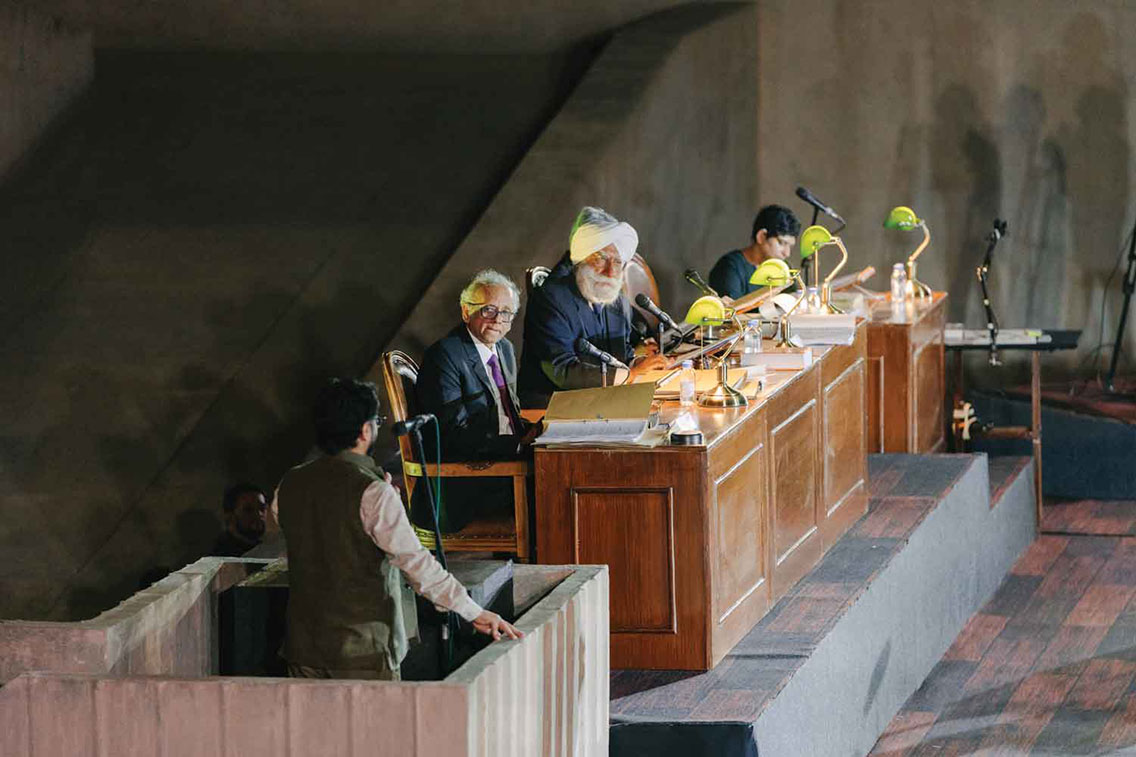
Khōj International Artists’ Association with Zuleikha Chaudhari,
In the Matter of the Rights of Nature—A Staged Hearing. Chandigarh (March 5, 2023).
Courtesy of Khōj International Artists’ Association.
During In the Matter of the Rights of Nature—A Staged Hearing in Chandigarh, T&T presented a board game as part of their testimony that traces the traumatic experience of women farmers whose husbands have been driven by suicide due to untenable farming conditions. They worked closely with women of the Punjab to understand the economy of loss through the failure of family crops as the climate changes, and also to understand how they survive. As part of T&T’s testimony, one round of their game entitled Weeping Farm was played by drawing cards and moving around the board, enacted in the court itself. When a card is drawn indicating cyclonic rain for instance, a player loses ground and moves back several places, embodying a rural character’s daily life through the seasons. Through empirical research the artists discovered the tragic statistic that every 40–45 minutes there is one farmer’s death by suicide, and this timeframe determines the length of the game. Weather circumstances and cycles of cropping are critical to the lives of the surviving widow-farmers but they are trapped in an end game; they cannot separate their livelihood from the changing climate.
Artist Shweta Bhattad, dressed in a raw cotton worker’s apron printed with a footprint, presented a video of the turning pages of a handmade book as evidence: The Eaten Cotton...A Love Story...A Cook Book (2022). The soft raw cotton, screen-printed book is an illustrated encounter between cotton-growing, weather and culture, a material witness to ecological upheaval.20 Bhattad is a founding member of the Gram Art Project Collective, a group of farmers, artists, women and makers who all live and work in and around the village of Paradsinga. The story, told in letters, follows two characters through the origins of cotton cropping to the realisation of the demand to relinquish the boundaries between human and non-human, old and young, city and village in order to survive: a collective concept developed through the Gram Art Project, signalling a return to Indigenous knowledges.
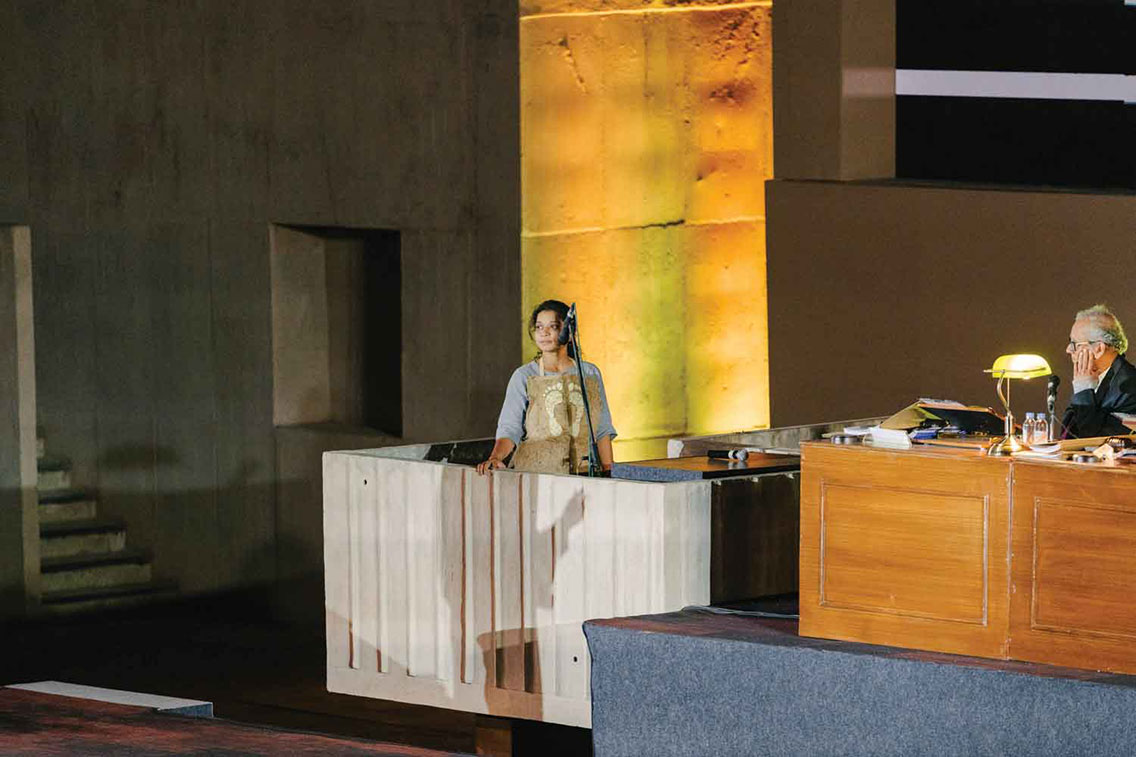
Khōj International Artists’ Association with Zuleikha Chaudhari,
In the Matter of the Rights of Nature–A Staged Hearing. Chandigarh (March 5, 2023).
Courtesy of Khōj International Artists’ Association.
The final artist-witness Randeep Maddoke’s film, Landless, documents the caste dynamics and bleak conditions for Dalits, agricultural workers in the Punjab region, including itinerant goat-herders in an unfolding ecological crisis. The three artworks each have in common a socio-relational human struggle with the new weathers, providing experiential testimony of an uncertain future. This project continues Khōj’s concerns with creative forms of testimony in many projects since Landscape as Evidence: Artist as Witness (2017).
The testimony of artists in the hearing, alongside the environmental lawyers and the farmers responsible for the burning, demonstrates how art in the form of “experimental jurisprudence” ignites the public sphere and calls for real change to be effected. Artists invent forms of experimental jurisprudence when legal and State mechanisms fail, to cite a phrase T.J. Demos developed in relation to artist Amy Balkin’s atmospheric propositions to the U.N.21 This might also be extended to the non-human: an owl alights on the Open Hand monument at the beginning of the video document of the hearing—an assembly across species divides. The owl might say, it is not only human bodies that are suffocating silently, look at us in the skies. At the end of the trial the judges affirm the claimants call for the rights of nature, and call on the whole nation, represented by the government to respond, rather than any one community. A “compromise settlement” is reached. Zuleikha tells me urgently that the next step is to take this fictional hearing concerning the rights of air to the real National Green Tribunal. Later that night, our group walk passed the arched green-lit, yet faded gate of the National Green Tribunal, a legislative body effectively suppressed under the government of Narendra Modi.
Experimental Jurisprudence and the Rights of Nature
Both Aotearoa New Zealand and India have pioneered radical environmental jurisprudence; considering the legal personhood of rivers and forests. The laws in both the immense continent of India and my tiny island are rich in protections of ‘Naturehood’, however, their implementation is poor. In the Matter of the Rights of Nature—A Staged Hearing reflects an ecocentric turn in the last decade in juridical thinking in India, even if the implementation of environmental protection has been poor. Economist Rita Brara (2017) argues that India has “made some steps toward navigating an ecocentric course, even if intermittently, by experimenting with a language for the Rights of Nature that draws on India’s Constitution, the drift of international currents and treaties, the judgments of its apex and provincial courts, as well as the rulings of a green tribunal.”22 Brara suggests further that many of the religious and ethical traditions of the Indian peoples that venerate nature appear in their juridical thought. She notes: “The notion of dharma, translated as ‘conduct’ according to inherent qualities or character, is understood to characterise all of Nature. [...] Nonviolence or ahimsa, too, continues to be an influential strain of thought in Indian religious traditions and affects the judicature as well.”23 In indigenous Māori worlding from Aotearoa New Zealand, weather elements are also ancestors and empathise with or affect human circumstances; the weather atua, supranatural beings, may be called or herald the oncoming weather. Artists trace the temporalities of weather in our bodies and in machinic data sets as well as legal systems.
In a judgment by the High Court in the province of Utttarakhand, Northern India, the ground-breaking law to recognise the legal rights of personhood to the Whanganui River in Aotearoa New Zealand was cited (2017). The court declared that since the Ganges and the Yamuna are sacred to a large number of Indians, these rivers should be accorded the status of living entities and granted the rights of a juristic or legal person in March 2017. However, the judgment of the provincial court at Uttarakhand was overruled by the Supreme Court of India in July 2017 on the grounds that it interfered with the rights of other provinces and raised issues concerning who would be regarded as responsible for compensation if the rivers were to flood.24 In relation to flooding of the Whanganui river, these objections have yet to manifest.
In Aotearoa New Zealand, the current right-wing government under Prime minister Christopher Luxton has repealed incentives for clean-cars, removed petrol taxes and smoke-free goals in his first 100 days in office—ecocidal acts of revenge politics following an era of centre left-government. The planet-upheaving cyclonic weathers that continue from these brutalist policies force bodies, biota and technologies into new assemblies.
Aerial Revolution
The art projects encountered in this narrative foment an aerial revolution that comes from the ground, from the breathers of air. They rally us to face the changing climate via the senses, to see the body itself as a sensor, and to reconstitute the impossible air of the present. Although weather is inconstant, it is crowded with substances, memories, and histories. As Connor has argued, the atmospheric science of urban meteorology has shown that since the 19th century the atmosphere “...is not just affected by contamination and irregularity—it is constituted by it.”25 When the exhausted air is filled with exhaust fumes and fog becomes smog, our bodies become smoggy through the act of respiration. The effects of the changing climate, visible and tasteable in the air, are symptoms of violent systems of power including the capitalist-colonial legacy in India, Aotearoa New Zealand and everywhere else. To recognise the rights of air is to guarantee our future survival along with our co-species.
When I left New Delhi I unspooled a trail of fossil-fuelled molecules from the petrochemistry of ancient forests. I left behind people living air-conditioned lives, and many others with no choice but to live at the roadside, always living in the air, in the exhaust of those who can move on. Yet in the thick air of my memory is also the scent of spices, the deep call of oud, and the light particles in ancient mosques swirling through porous panels. Within the clean-dirty spaces of aeroplanes, climate-controlled shopping malls and art fair exhibition halls we exist in modified weathers, buried in the staleness of regurgitated machinic air. Of fossil-fuelled travel, Connor writes: “For a mobile people, waste is the past.”26 Although this flight to India was my first long haul plane trip in six years, and a journey for which I weighed up the benefits of my presence as an artist and researcher, my carbon trail in the upper atmosphere, absorbed into the ocean, is the incontrovertible, biophysical thing: along with the Delhi air carried to the other side of the world inside my lungs.
The willing inhalation of incense in Paterson’s To Burn, Forest, Fire is an active co-respiration with trees and other species, or conspiration, an embodied form of witnessing to follow Neimanis and Verlie. The ceremony accentuates the simple biological connection we have to the respiration of trees through our breath. On the other hand, we are powerless to control our inhalation of unwanted atmospheric toxins without changing our fundamental desire for mobility and consumption. Neimanis and Verlie state:
We breathe together to survive, to empathise where possible, to recognise incommensurate suffering, to connect and entangle with others through shared breathing, and to create knowledges and responsibilities for breathing new worlds into life. Conspiratorial witnessing is therefore a breathy practice of collective action for climate justice.27
Air is now laden with compounds, it is a matter of concern never intangible or separate from culture; our atmosphere is becoming untenable for life, we breathe our waste. Artists witness, testify and speculate in powerful biophysical connections to weather as medium. Such artworks reflect the labour of extraordinary and radical thinking through experimental forms of environmental justice as in In the Matter of the Rights of Nature—A Staged Hearing; rituals in the case of Katie Paterson’s To Burn, Forest, Fire; and real politics fused with future speculation in Mithu Sen’s I Bleed River 2124.
6 February 2024, 21°, AQI 370, Tāmaki Makaurau Auckland, New Zealand
No sooner had I arrived home when my phone pinged in an emergency alert: my suburb was on fire; close all the doors and windows to keep safe from toxic smoke. Out of sight on the industrial edge of town a refuse station was burning, the winds carrying the unwelcome airborne matter of burning plastic to my home. While last Summer the cyclone-drenching floods swept my city and pōhutukawa trees and homes slipped into the sea, this Summer of 2024 a drought and hot El Niño winds have caused a fire to escalate. For three days the sound of helicopters fills the air, heaving monsoon buckets of sea water from the harbour to dowse the flames.
Footnotes
1 https://worldweathernetwork.org
2 Neimanis and Verlie, “Breathing Climate Crises: feminist environmental humanities and more-than human witnessing,” 2023.
3 T. J. Demos, Amy Balkin: (In)visible Matter, 2013.
4 Katie Paterson, To Burn, Forest, Fire, IHME Helsinki Commission 2021 (2021-2024). The IHME Helsinki Commission has taken place in 40 ceremonies in 15 different indoor and outdoor places from September 2021 in Helsinki to diverse audiences, https://worldweathernetwork.org/report/toburnforestfire/
5 “Palaeontologists characterise mass extinctions as times when the Earth loses more than three-quarters of its species in a geologically short interval, as has happened only five times in the past 540 million years or so. Biologists now suggest that a sixth mass extinction may be under way, given the known species losses over the past few centuries and millennia.” - Barnosky, A.D., N. Matzke, S. Tomiya, G.O.U. Wogan, B. Swartz, T.B. Quental and E.A. Ferrer, Has the Earth’s sixth mass extinction already arrived? 2011.
6 The name given to the last 11,700 years of the Earth’s history.
7 Text adapted from Katie Paterson. Maguire, Salonen and Zalasiewiczi, Art meets geology.
8 David George Haskell, “On the aromas of the first and last forests.” In Katie Paterson, Instruction Booklet 6.
9 Astrida Neimanis and Verlie 116-117.
10 Nerea Calvillo, “Political airs: From monitoring to attuned sensing pollution.”
11 See 28° North and Parallel Weathers. https://khojstudios.org/event/28-north-and-parallel-weathers/
12 Janine Randerson, Weather as Medium: Toward a Meteorological Art.
13 Mithu Sen, I Bleed River 2124.
14 Peter Sloterdijk, Terror from the Air.
15 National Small Industries Corporation.
16 Art and Agency. Panel including Khōj’s director Pooja Sood, Monica Bello (Cern), Professor Bonaventure Soh Bejeng Nidikung and Shuddhabrata Senguputa of Raqs Media Collective. India Art Fair, 2 February 2024.
17 Khōj International Artists’ Association, https://worldweathernetwork.org/report/khoj-report-2/
18 Connor 192.
19 Pooja Sood, Janine Randerson, Indranjan Banjeree, Alina Tiphagne, Conversation in the Khōj canteen 29 January, New Delhi, 2024.
20 Susan Schuppli, Material Witness.
21 T. J. Demos, Amy Balkin: (In)visible Matter.
22 Brara, “Courting Nature: Advances in Indian Jurisprudence,” 31-32.
23 Brara 32.
24 Brara 35.
25 Connor 191
26 Connor 272.
27 Neimanis and Verlie 118.
References
Brara, Rita. “Courting Nature: Advances in Indian Jurisprudence.” RCC Perspectives, No. 6, Rachel Carson Center, Munich, 2017.
Barnosky, A.D., N. Matzke, S. Tomiya, G.O.U. Wogan, B. Swartz, T.B. Quental and E.A. Ferrer, “Has the Earth’s sixth mass extinction already arrived?” Nature 471, 2011, DOI: 10.1038/nature09678, pp. 51-57.
Calvillo, Nerea. “Political airs: From monitoring to attuned sensing pollution.” Social Studies of Science, Vol. 48 Issue 3, Sage Journals, 2018, DOI: 10.1177/0306312718784656.
Connor, Steven. The Matter of Air: Science and Art of the Ethereal. Reaktion Books, Chicago, 2010.
Demos, T. J. “Amy Balkin: (In)visible Matter.” International New Media Gallery Catalogue, edited by Edwin Coomasaru and Tom Snow, New Westminster, 2013.
Haskell, David George. “On the aromas of the first and last forests.” To Burn, Forest, Fire instruction booklet, IHME Helsinki for the World Weather Network, Helsinki, 2021.
Neimanis, Astrida and Verlie, Blanche. “Breathing Climate Crises: feminist environmental humanities and more-than-human witnessing.” Angelaki: Journal of the Theoretical Humanities, Vol. 28, No. 4, 2023, Taylor & Francis Online, https://www.tandfonline.com/doi/full/10.1080/0969725X.2023.2233810.
Paterson Katie, Siobhan Maguire, J. Sakari Salonen. and Zalasiewicz. “Art meets geology.” To Burn, Forest, Fire, to-burn-forest-fire.com, https://to-burn-forest-fire.com/. Accessed 16 March 2024.
Paterson, Katie. To Burn, Forest, Fire Instruction Booklet, IHME Helsinki for the World Weather Network, Helsinki, 2021.
Randerson, Janine. Weather as Medium: Toward a Meteorological Art. The MIT Press, Cambridge, MA, 2018.
Schuppli, Susan. Material Witness: Media, Forensics, Evidence. The MIT Press, Cambridge, MA, 2020.
Sloterdijk, Peter. Terror from the Air. Translated by Amy Patton and Steve Corcoran. Semiotext(e), Los Angeles, CA, 2009.
Visvanathan, Mallika. “Weathering Crisis: On 28° North and Parallel Weathers.” ASAP | art: alternative south asia photography art, https://asapconnect.in/post/696/singleevents/weather-ing-crisis. Accessed 15 March 2024.
Essays
Monsoon Equinox
It is the start of the year 2050. The months have melted away and the seasons seep into one another, liquid, languid. Time’s passage is guided solely by the cycles of the sun and moon, the Gregorian days of waged time a blurry memory of a past long gone. Back in the Old World, people learnt to manipulate time with the mechanics of manmade devices. They made clocks that could shift time back and forth with the turn of temperate seasons. An hour more to the working day, even as the daylight hours shortened; one less hour of sleep, even as the nights grew longer.
Here on the equator in the historied Riau-Lingga Archipelago, where the present-day Singapore state sits, time has always been consistent. Day and night will again remain at equilibrium in the year 2050, especially during the Monsoon Equinox when the Earth’s rotation is at zero degrees both latitudinally and longitudinally. The days will start at seven when the sun rises, and nights will start at seven again when the moon ascends. The only period in history when equatorial time was out of joint was when the ones who came from the Old World occupied these lands, and the tumultuous years after their exit, when the then-newly formed equatorial nation states grappled with the aftermath of Greenwich Mean Time (GMT), another Old World mechanism that used the longitudinal Prime Meridian at 51° 28’ 38’’ N as the false ground zero of all-world time. Up until 1984, the position of Greenwich north of the equator was treated as the centre to which all other places on Earth had to coordinate their time. When rulership over the archipelagos and highlands running along the equator got scrambled up by conquest, there remained a period of confusion even after the occupying forces left, despite the revolutionary fervour of decolonisation, as to how to align time to the false centre of Greenwich. As an example, until 1941, Malayan Time was standardised with the Straits Settlements across all its lands and waters, to GMT +07:30. After the Malayan Federation split, there was more confusion to come, as Malaysia shifted its Old World-inherited clocks forward to +08:00 in 1981, and its ex-Federation counterpart Singapore chose to follow suit to match, for the sake of retaining business and travel relations across its new divisions.
Now, time is the same everywhere, cycling through the seven seasons all across the world. Many expect that at this year’s Conference of the Parties (COP) during the season of White Dew, it will be announced that the net-zero targets for carbon emissions, as set out in the Paris Agreement in 2015, have miraculously been met.
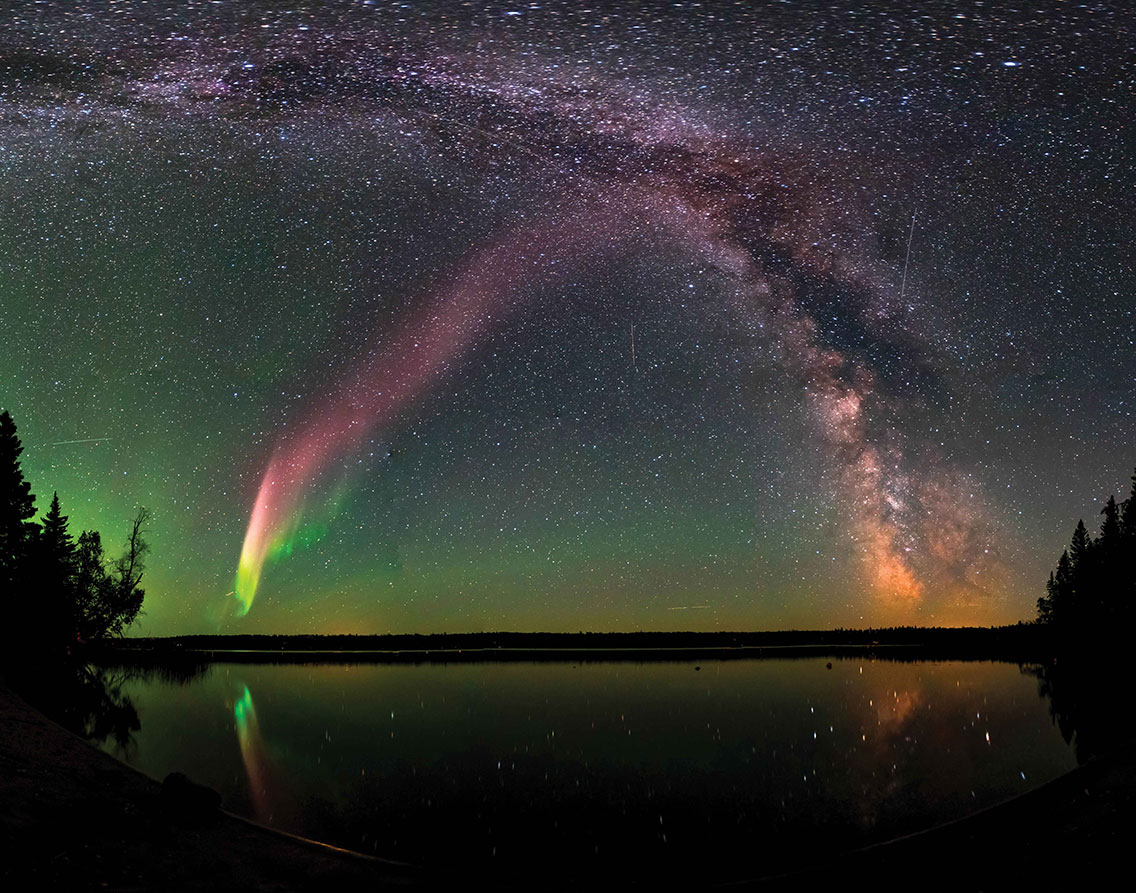
STEVE (Strong Thermal Emission Velocity Enhancement) and the Milky Way at Childs Lake, Manitoba, Canada, 2018. The picture is a
composite of 11 images stitched together. Photo by Krista Tinder, courtesy of NASA Goddard Space Flight Centre/Flickr.
Yet too much damage has already been wrought, and some changes remain irreversible, like the disappearance of the season named winter. Now, even at the poles of the Earth, a new year starts when the monsoon surges cause widespread, continuous, moderate to heavy rain, at times with 25–35km/h winds in the first half of the season, and rapid development of afternoon and early evening showers. There are no more glaciers or sea ice left on the Earth’s surface, only in the relics of deep freezers. As the last ancient ice sheet melted away in 2049, the polar vortex no longer remains polar, inciting a combination of warming air and ocean temperatures from the poles to the equator, and frequent occurrences of geomagnetic storms along the equatorial belt. Boreas (north wind) and Auster (south wind) are also no longer, having slowly been absorbed into the monsoon drifts of the equator since 2016, when the Strong Thermal Emission Velocity Enhancement (STEVE) phenomenon was first officially discovered. Instead of the Auroras Borealis and Australis, namesakes of the Grecian north and south winds, STEVE has been erupting across the sky every night during the Monsoon Equinox, a hazy enchantment of magenta amid the constant rain and warm winds of the season, a phenomenon which we can expect to continue seeing in 2050 as well. After the Monsoon Equinox, comes the season of Lalang Fires.1 Fierce winds are expected to plough through again this Lalang Fire season, when the warm monsoon winds turn dry and unpredictable, sparking grass fires across the island. It starts with the slow crepitation from burning weeds, with sound travelling fast towards the city centre. As always, it will be a busy season full of mayhem for the local Civil Defence Force, but they have maintained a strong track record of being reliable first responders to crises of varying natures since 1948, when a record-breaking heatwave sparked twenty-two fires across just four days. Investigations found that the cause of the outbreaks were unattended joss sticks at cemeteries during the Qingming Festival, a Taoist day of offerings to the spirits of deceased ancestors which historically took place 106 days after the Winter Solstice. Since the early 2010s, after the enactment of the New Burial Policy in 1998 that cited land scarcity as a reason to impose a fifteen-year term on burial grounds, Qingming rites began to migrate to temple columbariums as the dead were exhumed from the ground, and cremated or reinterred into crypts instead, depending on one’s religious beliefs. In 2007, the Crypt Burial System was introduced alongside the New Burial Policy, which saw the mass transference of Muslim places of rest to a grid-like cemetery in Choa Chu Kang, and the gradual disappearance of multifaith burial sites.
These days, Qingming is observed throughout the season, but temple managements have banned unattended fires in rites and rituals. They have also reduced the number of joss sticks that can be used for prayer (Ng, 2023). The institutionalisation of such practices has not meant their acceptance from devotees. The Force responded quickly and effectively to the 1948 fires, though, and have continued to do so since. Although Qingming-related grassfire outbreaks have dwindled over the years, it is predicted that the 2050 season of the Lalang Fires will not be any easier to manage than previous years, as dry winds blow across the island wilder than ever, at high speeds. For better or for worse, it has been remarked that “‘crisis’ is the metier of the Singaporean state.”2 Crisis conjures chaos, unmanageable and unruly. Crisis invokes control, as in damage control, a calculated managerial impulse enforced en masse. Chaos evokes anarchy, as in calls to action, the emergence of self-organised methods of living together in a more-than-human world. These first fifty years of the Anthropocene have oscillated wildly between crisis and chaos, a long, difficult balancing act between impulses to control, and grassroots organisational movements.
After the Lalang Fires comes the Awakening of Insects. The lingering heat of the grassfires warms the soil; the Earth becomes humid as hot air rises from the heated ground. Meanwhile, the hot humid air from the north is strong and creates frequent winds. Arising as a countermovement to the preventative measures against the grassfires, the Awakening of Insects has become a season of vernacular, syncretic ceremonies, when bonfires are lit in open fields to collectively mourn the losses of the last fifty years, while awakening new cycles of life. Unlike during the season of Lalang Fires, though the winds fan the flames of the ceremonial bonfires that are held during this season to rouse the insects from their slumber, humidity swallows the fires again by nightfall, and no major damage is expected.
As the earth warms, various species of insects, non-human and post-human, awaken from hibernation and rise from the soil. They swarm the skies, unhindered by the skyscrapers that used to dominate the Singapore horizon.
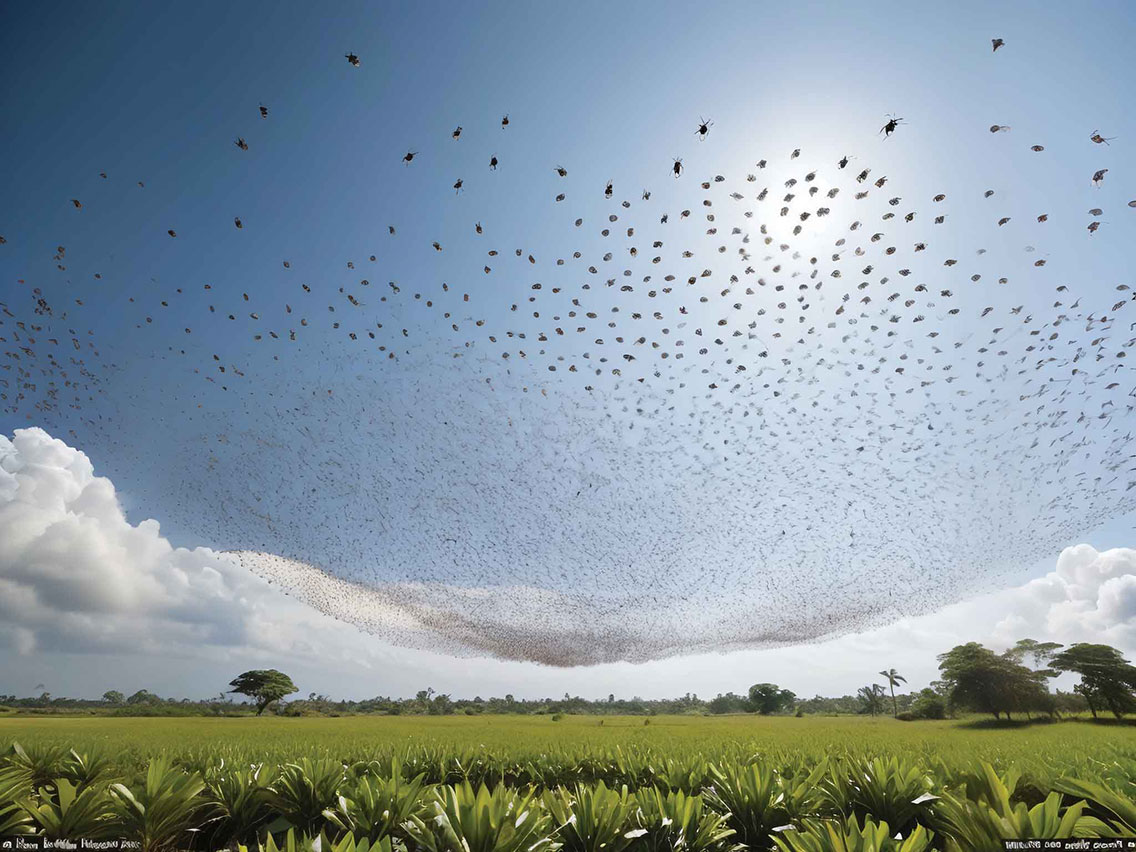
Image of a swarm of insects over an open field, created with Open AI DALL-E 3 text-to-image generation software.
Courtesy the author.
In murmurations numbering in the thousands, they begin their migratory journeys across the world, scattering lifegiving pollen and seeds along the way. Across the climate discourse that has developed since the start of the twenty-first century, some words often appear as suffixes: crisis and control, alongside others like action, adaptation, displacement, justice, migration, mitigation, reparations. These climate-related syntaxes generated a paradox of concurrent yet unsynchronised scenarios, where the consequences of centuries of anthropogenic climate change created extreme inequity throughout the world. Small islands in warming and rising seas were the first to initiate a global call to action, yet many of them were the first to suffer the consequences. The Paris Agreement has been fulfilled, but not without sacrifices and losses.
The Awakening of Insects is a time for mourning, while looking ahead. Many believe that the government’s 30 by 30 initiative, which aimed to achieve 30% of local food growth by 2030, failed because of their lack of support to preserve local and indigenous fishing and foraging techniques. Instead, an expensive, techno-engineering development programme was pursued with the singular goal of increasing agri- and aquacultural yields. In the process, open-air, land-based farms and open-sea fishing were forcibly replacing with confined, microclimatic solutions.
The word ‘microclimate’ implies the ability to control or manipulate ‘climate’ into something scalable and manageable, which has been proven to be an impossible task, though not for a lack of trying especially in the case of Singapore. Entrenched as it is in a long history of protectionism and safeguarding national interest, this logic of control fits neatly into its founding narrative of survival, that propagated the creation myth of the formation of the modern nation state. Early efforts to terraform the island’s natural landscape into a microclimate optimised for maximum productivity evidence this survival-of-the-fittest mindset. The narrative of climate control continued for a long time to undergird the development of the island-state as an ongoing project of constant monitoring, upgrading, and optimisation in the interest of microclimatic survival and flourishing.
But it was the park’s microclimate that he was most concerned about. Unceremoniously taking leave of the parks’ officials, he and Mrs Lee took an unscheduled walk along the Esplanade, with security officers and reporters hovering. Walking through the Anderson Bridge tunnel and past Victoria Theatre, they stopped by the Singapore River, near the statue of Stamford Raffles. There, the prime minister gave reporters his verdict. The pavement was so broad, he said, that the trees, even when fully grown, would leave large areas exposed to the sun. He noted that although the sun had nearly set, one could feel the heat through the soles of one’s shoes. He squatted suddenly and placed a palm inches off the ground. He could sense the heat radiating from the pavement, he said.
—Cherian George
Air-Conditioned Nation: Revisited, 20203
“Think of Singapore instead as the Air-Conditioned Nation,” the media scholar Cherian George once suggested, “a society with a unique blend of comfort and central control, where people have mastered their environment, but at the cost of individual autonomy, and at the risk of unsustainability.”4 And indeed, the time of unsustainability arrived, climaxing in the 2030s, heralded by the mass teardown of towering office and housing complexes as they turned from novel urban planning solutions to solve land scarcity, into safety hazards, as natural barriers of protection against strong winds slowly eroded away.
Tall, towering buildings, constructed with modernist materials like steel, glass, concrete and so on, became too heavy to withstand the relentless storms that come with Grain Rain, the season that follows the Awakening of Insects. As the ice sheets melted, sea levels continued to rise, and skyscrapers got torn down block by block in desperate efforts to keep reclaimed lands afloat. Their mass and centre of gravity were too high for the artificial islands on which they were built to remain buoyant amidst the floods that rushed in against the old water-breakers and sea walls. These historic fixtures have been around since the early 1990s, when the government first started mandating that every new reclamation and construction project had to be built to double the height of the expected sea level rise in annual Intergovernmental Panel on Climate Change (IPCC) estimates, and vulnerable highways constantly elevated. As more and more stone and cement were added to meet these standards, they started to weigh heavier and heavier on already sinking islands. By the late 2010s, 70% to 80% of Singapore’s coast, both natural and reclaimed, was already lined with hard walls or gradated stone embankments,5 but they could never keep up with the ever-increasing heights of new construction projects.
Inevitably, some islands sank, but for the most part, people have learnt to live with the rising seas. Bamboo rafts have become popular again, for their durability and tensile strength against the strong winds and currents that come with Grain Rain season. Historically celebrated by fishing villages in the coastal areas, Grain Rain marks the start of the fisherfolks’ first voyage of the year. On the first day of the season, marked by the first downpour since the Monsoon Equinox, people would worship the sea and stage sacrifice rites. The custom dates back thousands of years ago when people believed they owed a good harvest to the gods, who protected them from the stormy seas. This period of rainfall is also extremely important for the growth of crops. As the old saying goes, “rain brings up the growth of hundreds of grains.” It’s warmer than ever, but we are coping. There are less office buildings than there were before, as air-conditioning technology for hundreds of floors of square footage became too costly to bear, not with the net-zero target that had to be met.
As the soil absorbs the rainfall of Grain Rain season, the earth warms again with the season of Rising Heat. During this season, the mid-afternoon heat is expected to reach an average maximum of 38 degrees Celsius, which meteorologists hope will be the limit for the next fifty years. Lazy natives, some were called by neocolonial leaders who had adopted or been indoctrinated by Greenwich Mean Time, for seeking shade under generous banyans in the mid-afternoon heat.6 Even then, the elemental forces of the equator proved powerful resistors to the clockwork rhythm of manmade time. When the red-haired ones first landed here, they too could not deal with the heat, and perhaps never learnt to do so. A piece of advice in the Malayan Federation’s local daily Morning Tribune read in 1936, more than a hundred years after their first landing, “If you want to look and feel cool, rearrange your living schedule so that you will not have to hurry and worry so much … Allow yourself time for a brief siesta and a cooling shower …”7
The ‘living schedule’ on the equator (though not quite about a cool, leisurely, and worry-free life), however, was always already in tune with the eddying movements of heat, governed by the cycles of the sun and moon. Workers of the land would rise with the sun while taking breaks in the shade, while fisherfolk who work on floating farms would follow the push and pull of tides, as the moon waxes and wanes. They work this way not out of laziness or indolence, but because they know it makes no sense to work against the weather, or on a time out of joint.
Across the 2010s and early 2020s, construction companies learnt this the hard way when they started losing workers to heat-related accidents, despite groups like the SG Climate Rally (SGCR) warning and advocating heavily against such workers’ violations. Construction entities have since dwindled in influence or transformed into unionised coalitions. The construction boom in Singapore infamously started in 1961, following the notorious Bukit Ho Swee fire that skyrocketed the profile of the then-nascent Housing Developing Board (HDB). The fire, which broke out in the tightly packed and highly flammable kampong squatter settlement of wooden houses in Bukit Ho Swee, rendered some 16,000 people homeless, despite a robust ‘culture of fire’ that existed in kampong settlements, in which local volunteer firefighting squads consisting of unemployed youth and secret society members took turns to patrol the kampongs. The biggest fire yet in Singapore history, outdoing even the 1948 grassfires, it is considered by many as the pivotal moment in the transformation Singapore’s architectural and social landscape, turning unruly urban squalor and ‘inert’ squatter communities into modern, lawful citizens living in planned estates.8
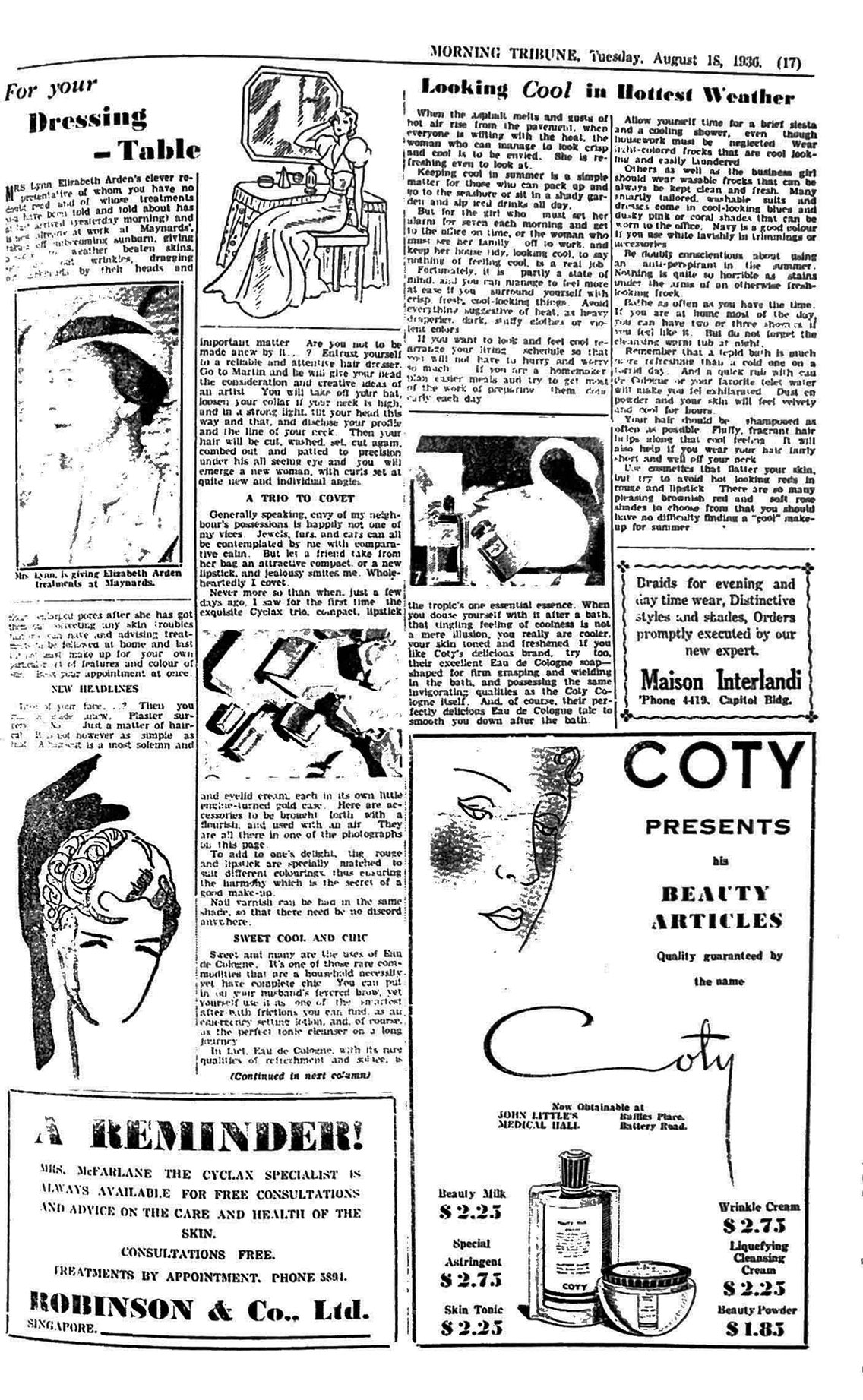
“Looking Cool in Hottest Weather.” The Morning Tribune, 18 August 1936, p.17.
Courtesy National Library Board, Singapore. First cited in an essay by Fiona
Williamson in the chapter “Lalang Fires” in The 2050 Weather Almanac,
ed. Soh Kay Min and Ng Mei Jia, 2024.
Till this day, the cause of the conflagration remains a mystery, though there were whispers during the heated pre-independence years of the early 1960s, that the Bukit Ho Swee fire was a case of arson, sparked by the then-ruling party to declare a state of emergency that would blaze a path straight through the kampongs, so to speak, and clear space to launch their highly-anticipated high-rise public housing model. These rumours were never verified but reveal an enduring fact of public perception and the power of grassroot beliefs. Even as the heat of fire dissipates, the smoke of secrets lingers in the air long after. This season of Rising Heat, the case of the Bukit Ho Swee fire is tabled to be reopened for investigation, as civil society calls for accountability for the numerous heat-related deaths on construction sites force the courts to locate and address the historical root of the problem.

Tan Choo Kuan, Rebuilding Bukit Ho Swee, 1962.
Ink on paper, 37.3 x 27.2 cm. Gift of Ms Tan Teng Teng. Collection of National
Gallery Singapore. Courtesy of National Heritage Board, Singapore
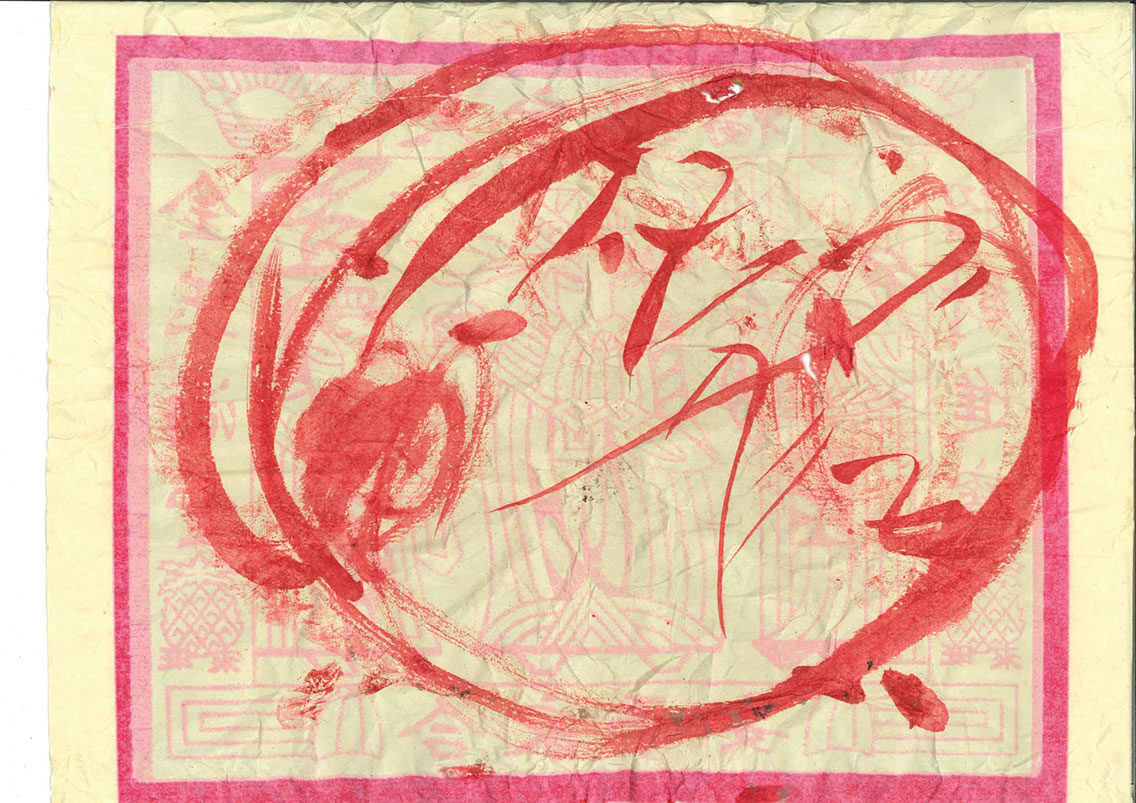
Ink drawing on joss paper by Thunder Marshall Leizhenzi, during a consultation
at Shui Gou Guan Temple, Singapore, on 27 November, 2023.
Courtesy of Shui Gou Guan Temple.
Bolts of lightning illuminate the sky in the season of Sumatra Squalls, as hot afternoons get subsumed by sudden thunderstorms and short-duration showers, and strong wind gusts up to 40–80km/h stir up the seas from the predawn hours until midday. Taoist devotees have long believed that the Thunder Marshall is most active during this season. A leading deity of Heaven’s Department of Thunder, he descends to the mortal realm every two weeks during this season, to commune and provide consul with his congregation, channelling his presence through spirit mediums and ritual performances. The Thunder Marshall’s likeness is said to be that of a bird, and the howling squalls of the season’s early morning wind gusts are believed to be a sign heralding his arrival, alongside booms of thunder that rumble like a drumbeat through the air and in one’s chest. Legend has it that at the bidding of the Heavens, he metes out punishment to both earthly mortals guilty of secret crimes, and evil spirits who have used their knowledge of Taoism to cause harm in the realm of Earth.
Yet the power of the deities resides in the power of belief in their presence. It is based on a dialectical relationship between the spirit and mortal realms. Within the last fifty years, the mortal realm has encountered an unprecedented series of ecological trials, as fires during the hot seasons took away lives and destroyed infrastructure, or lack of rainfall during Grain Rain in some years resulted in poor harvests and hungry ghosts. Belief in the gods waxed and waned, as people wondered if their prayers were being heard at all. As a rare interview with the Thunder Marshall conducted in 2023 showed, however, the deities do not hold any material sway over events of the mortal realm, neither are they capable of controlling the weather.9 Rather, they exist with the cycles of nature as it transforms: the two seasons of fire, Lalang Fires and the Awakening of Insects, used to be one. But as the Thunder Department saw the sincere, continuing need of the people to mourn with open fires, even as temple managements banned the practice, Madame Wind, another deity of the department and a trusted assistant of the Thunder Marshall, turned the dry gusts wet and humid, tamping out the bonfires that would otherwise spread through the island.
Historically, years began with the Winter Solstice. It was the first solar term to emerge in the traditional lunisolar calendar. As the months melted away and winter disappeared, White Dew has become the last season of the year. As the squalls die down and storms abate, an unusual chilly vortex is left to signal the last of the seven seasons. When air-conditioning was still a widely utilised tool of climate control and heat relief, meteorologists struggled to forecast the season of White Dew as its namesake dewy residue, a result of vapours condensing on grass and trees, were spotted all the time instead of just during the morning hours. Since the mass teardown of high-rise buildings lined with vertical columns of air-conditioning units for each household, it has been much easier to recognise the arrival of White Dew.
There was a period when the invention of the air-conditioner was seen as a life-changing technology that changed the lives of people in the tropical regions. This was the time in between the late 1980s and the early 2000s, when the ‘lazy native’ myth had yet to die away. A fabled leader of the time once said, “before air-con, mental concentration and with it the quality of work deteriorated as the day got hotter and more humid... Historically advanced civilisations have flourished in the cooler climates. Now, lifestyles have become comparable to those in temperate zones and civilisation in the tropical zones need no longer lag behind.”10 In the year 2050, however, the coldest season has been lost, and some like the artist Kent Chan (in his videos Future Tropics, 2023; Warm Fronts, 2022; Monsoon Sessions, 2022) even anticipate a complete mono-climatic expansion in the next few hundred years, in which all meridians and parallels will become tropical. This White Dew is expected to be slightly warmer than the last, considering the melting of the last ice sheet in the past year. Along with the possibility of a New Tropics, this issue is expected to be a key point of discussion at the season’s annual Conference of the Parties.



Kent Chan, Future Tropics, 2023, video still. Courtesy the artist.
Acknowledgements
The research for this essay is supported by the Ministry of Education, Singapore, under its Academic Research Fund Tier 2 grant for the project Climate Crisis and Cultural Loss (MOE-T2EP40120-0002).
Footnotes
1 Lalang is a tall grass (Imperata cylindrica) with linear leaves that can grow up to 2m tall, found in tropical, sub-tropical and monsoonal climates.
2 Waldby 372.
3 George 17.
4 Ibid. 19.
5 Schneider-Mayerson 169.
6 Alatas.
7 “Looking Cool…” 17.
8 Loh 19.
9 Ng, “Introduction…”
10 George 18.
References
Alatas, Syed Hussein. The Myth of the Lazy Native: A Study of the Image of the Malays, Filipinos and Javanese from the 16th to the 20th Century and Its Function in the Ideology of Colonial Capitalism. Oxon, UK and New York, US: Frank Cass and Company Limited, 1977.
George, Cherian. Air-Conditioned Nation Revisited: Essays on Singapore Politics. Singapore: Ethos Books, 2020.
“Imperata cylindrica,” National Parks, 2023. www.nparks.gov.sg/florafaunaweb/flora/4/3/4325
Loh, Kah Seng. Squatters into Citizens: The 1961 Bukit Ho Swee Fire and the Making of Modern Singapore. Singapore: NUS Press, 2013.
“Looking Cool in Hottest Weather.” The Morning Tribune, 18 August 1936, p.17. First cited in an essay by Fiona Williamson in the chapter “Lalang Fires” in The 2050 Weather Almanac, ed. Soh Kay Min and Ng Mei Jia, 2024.
NASA Goddard Space Flight Centre/Flickr, www.flickr.com/photos/gsfc/26938621338/in/album-72157693734878994/)
Ng, Mei Jia. Introduction to “In conversation with a deity: how’s the weather lately?” The 2050 Weather Almanac, ed. Soh Kay Min and Ng Mei Jia, 2024.
Schneider-Mayerson, Matthew. “Some Islands will Rise: Singapore in the Anthropocene.” Resilience: A Journal of the Environmental Humanities, Vol. 4, No. 2–3, Spring–Fall 2017.
Waldby, Catherine. “Singapore Biopolis: Bare Life in the City State.” East Asian Science, Technology and Society: An International Journal, Vol. 3, 2009, Issue 2-3: Double Issue: Emergent Studies of Science and Technology in Southeast Asia.
Essays
Weather Report Australia
James Geurts—Weatherman
James Geurts performs many rituals, through which he tells many stories, involving water and journeying, incorporating them in temporary arrangements of light and 3D structures. These are accompanied by less ephemeral marks on man-made surfaces, notably drawings and photographic prints. Fluidity, or mutability, is his leitmotif.
—Dr Julie Louise Bacon, Edinburgh,
Beyond interpretation and judgement, writing the story of art.1
I’m sitting on a North Melbourne decking with artist James Geurts, discussing the many weather-related projects he’s undertaken over the past three decades. We’re in 37-degree heat, as Australia feels the full force of climate change. Bush fires burn out of control west of nearby Ballarat. He’s telling me about Standing Wave: Drawing Tide, a work he made at The Bay of Fundy in 2012, and exhibited at the Dalhousie Art Gallery in Halifax, Nova Scotia.
“A standing wave is a phenomenon produced when the particular frequency holds an equal harmonic resonance,” he explains to me. “The Bay of Fundy is one of the only large tidal water bodies where the in-and-out-going tides harmonise with the shape of the geology, causing a natural “standing wave” phenomenon. This in turn creates extreme tidal pulses.” I’d heard talk of this mythical phenomenon when, as a young art student in 1973, I’d worked as a lighthouse keeper on three uninhabited islands off the West Coast of Scotland, experiencing all kinds of freakish weather, with fog being the most cunning.
Now I was hearing about it first-hand. “The in-situ research undertook 11 hours occupying the tidal zone (the duration of an in- and out-going tide) drawing and measuring the experience of how the body and perception comprehend such large bodies of moving water. The spaces between the fluorescent tubes with which the work was partly fabricated are intuitive, based on the site experience, in order to create a wave within a wave, a pulse that undulates both ways simultaneously to emulate the resonant frequency.” Later, I google this work, as I do the many projects Geurts has undertaken in Hoorn (Netherlands, 2014); London (UK); Israel, Palestine and the Occupied Territories (Middle East, 2011); Tasmania, (Australia, 2018)); Brussels (Belgium, 2010); Kuandu Museum of Fine Arts (Taiwan, 2017); Quebec (Canada, 2009); and Point Nepean (Australia, 2022). My online search takes me back to the Standing Wave: Drawing Tide project at The Bay of Fundy. In Visual Art News magazine (January, 2013), Allison Saunders quotes him as saying, “I see everything I do as part of a drawing methodology…sometimes I spend hours or days drawing, as a way of listening. Sometimes that’s the work in itself, and that’s enough.”
Geurts is a self-confessed psychogeographer. More than most he understands the Situationists’ old dictum, “The Map is Not the Territory”. He moves from East Jerusalem to Gaza or from Belgium to The Netherlands with the confidence and freedom of a river, more concerned with the physicality of the natural environment that frames him, than with cartography or currency exchange.
Floodplains Taipei, Melbourne
Floodplains, and how they are affected by local weather conditions, have also been of ongoing fascination to Geurts. Indeed Floodplain (2018) is the descriptive name for a major project based at the NGV Federation Square in Melbourne and spreading its liquid tentacles across the whole 242-kilometres of the Yarra River. In her catalogue essay (Perimeter Editions), Annika Kristensen speaks of Geurts’ “meticulous research process” that saw him “spend months traipsing the banks of the river itself, and trawling for information in the State Library of Victoria and in the Melbourne Water archives.” By contrast to this well-planned and meticulous research, the last major installation I saw of his was the huge contribution he made to the FrontBeach, BackBeach project in 2023, on the Mornington Peninsula. I was fortunate to witness him installing this Standing Wave from lengths of neon tubing and a rats’ nest of wires and cables. I saw him advancing through doubt rather than certainty as he tried different configurations and experimented with site-lines, taking decisions ‘on the hop’ as he tested some propositions and discarded others. The 4m x 5m high pulsing sculpture found its form as a grid of fluorescent tubes that appear to be collapsing under the pressure of extreme weather, unhinged tubes of light form a breaking wave, cascading down the centre of the sculpture.
I’d heard of another floodplain work Geurts made a few years earlier while on a residency at the Kuandu Museum of Fine Art, Taiwan. It was titled Watergate (2017). As the burning sun set over North Melbourne, I asked him to fill in the details. “Taipei City was built in a floodplain,” he tells me. “After realising this, town planners and engineers created many interventions of the river to prevent future floods, including a 10m high wall of concrete between the city and the Tamsui River, to attempt to prevent the city flooding during typhoons. Through the residency I investigated the vulnerable positioning of the city, exploring the management of the river, its straightening and infrastructure designed to avert flooding. I focused on a large, militarised dike wall, which is a potent marker of the physical and psychological barrier between the city and the river. The research centred on the Dunhuang Evacuation Gate, one of the few openings in the wall where large metal gates are closed if threatened by a typhoon surge. An initial durational drawing at the site reimagined the rupture of this threshold during a flooding event, where the gate failed to close. A bioluminescent light sculpture was staged at the same site, an outline drawing of a floodgate, underlining the critical juncture where nature and culture meet. The sculpture is an impossible proposition, a dysfunctional gate, amplifying the futility of trying to stop extreme weather. The light sculpture was positioned between the existing Dunhuang Evacuation Gate and the river, aligned to set up a new threshold, illuminated in the space between day and night. The sculpture was then reconfigured back into the museum, inverting the exterior experience to the interior space of the gallery.”
Messing with the Technology Interface
I ask Geurts about his use of colour, often but not always, through neon, and about other artists with whom he feels an affinity. He points me in the direction of an online review of his Quebec work in Reflections of Québec (2009) written by Anne-Lise Griffon and published in Inter Actuel magazine, No 103. She writes: “At the intersection of Land Art and Minimalism, this installation is paradigmatic of the work produced by James Geurts; time and the ambiance of luminosity intervene, playing a pivotal role in the construction of the artwork. Geurts transforms his chosen site into a moving body, permeable to variations in time and climate.” And in a footnote adds, “The installation displayed some of the characteristics of Andy Goldsworthy’s work with water and ice. The use of modulating light sources, revealing aspects of space, strongly evokes the work of Dan Flavin. For example, The Diagonal of Personal Ecstasy (The Diagonal of May 25, 1963), a work consisting of a single yellow neon attached to the wall of his studio at a 45- degree angle, prompting a re-reading of the space.”
Geurts picks up the story in his own words, in a poetic monologue that he throws at me like a latter-day King Lear wrestling with the elements. “So I got permission to turn this local swimming pool, this outdoor swimming pool, into a living monochrome, into a living artwork to collaborate with the weather. I positioned yellow lights situated in each corner, and it created the whole pool mass, as a yellow monochrome… it kind of created a hearth, or a warm arena, to allow the weather to change visibly within the monochrome throughout the three months that the installation occupied. People could see from a walking platform around the top of the pool looking into it, through the winter, through snow… documenting how the work had changed through always changing weather conditions… It filled up with heavy rain, then it would freeze, and then there would be sleet, then deep snow... And then there was a big storm where one of the yellow lights, which was precariously positioned on the ice, got pushed over because it was heavy, fell into the ice, and it must have burnt its way through the snow, and when it hit the water, it created this electrical charge and created this amoebic electrical rupture-drawing through the snow. And it turned off…but also left the residue of it melting into the snow.”
‘Tip of the iceberg’ is a journalistic cliché which I would normally, to use another one, avoid like the plague. However, it is a phrase that relates to both the weather and climate change, and to the works of James Geurts. I have only exposed the very tip of his decades-long practice and would urge you to visit his extensive website to fully appreciate the oeuvre of this nomadic psychogeographer.
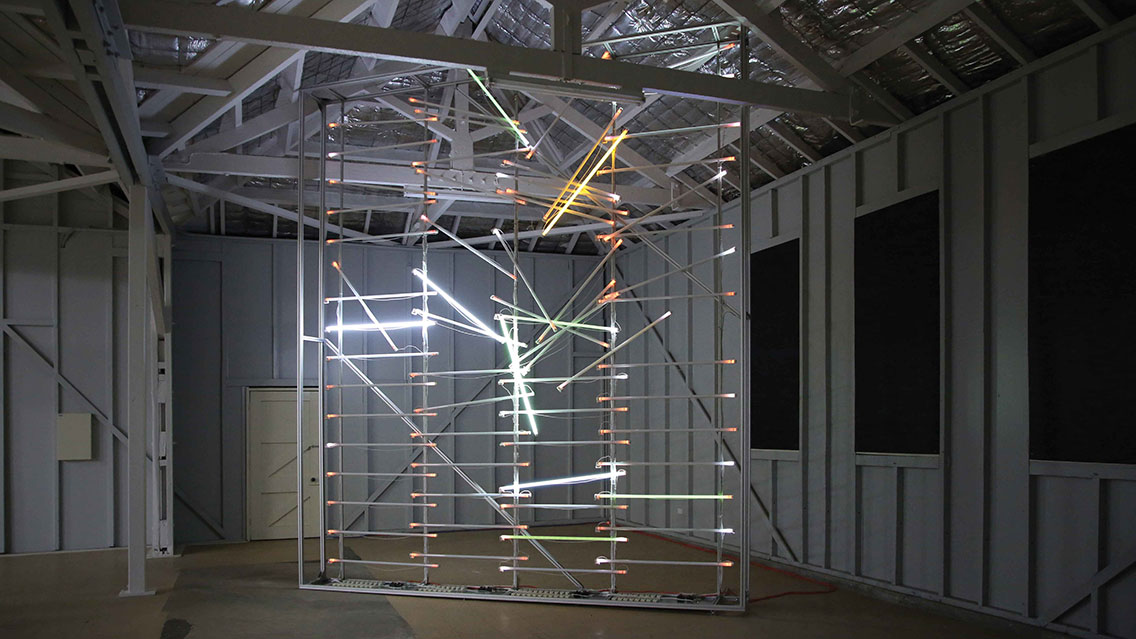
Standing Wave
Site-responsive kinetic light sculpture
5m x 4.2m x 2m
Point Nepean National Park, Victoria
FrontBeach, BackBeach, Public Art Commission 2022
Courtesy the artist
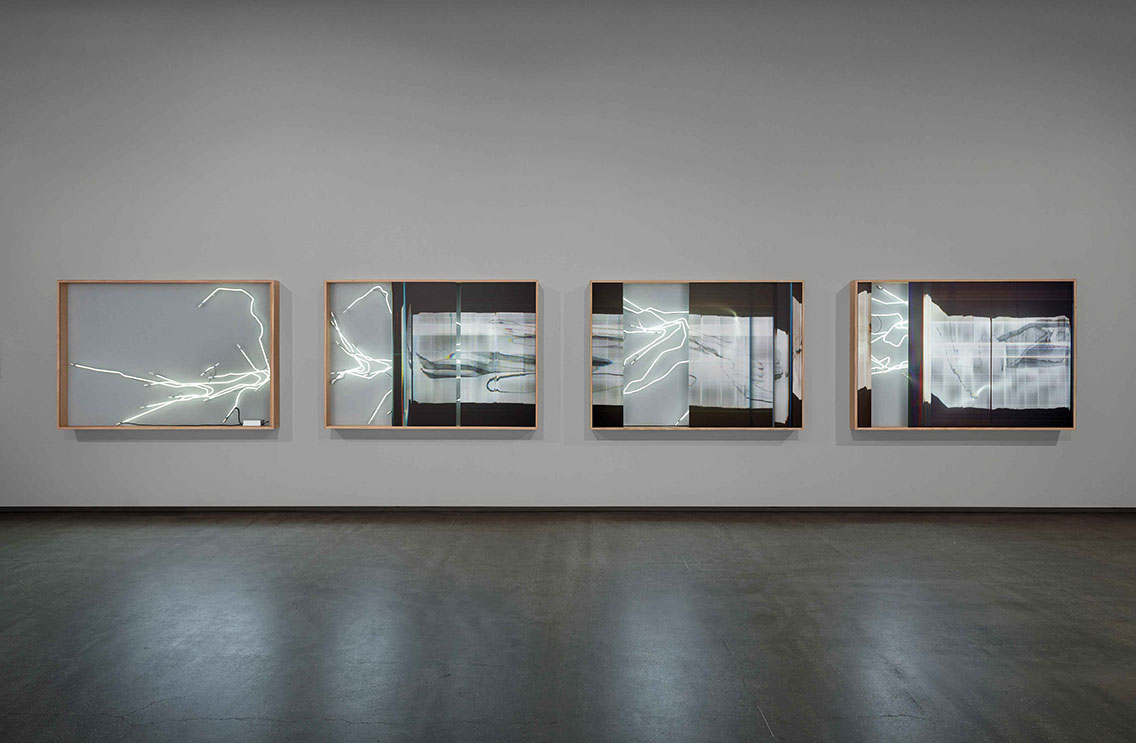
Flow Equation
4 x (2m x 1.4m x 17cm)
Neon, scanned work on paper, timber frame and Dibond
TarraWarra Biennial
TarraWarra Museum of Art 2021
Courtesy the artist

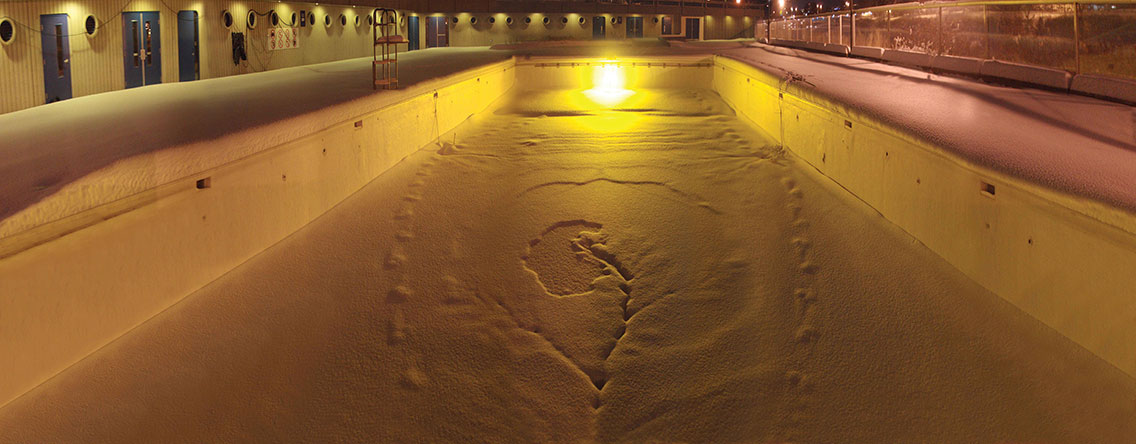
Living Monochrome
Site-specific durational light installation
20 x 8 x 3m
Piscine Saint-Roch, outdoor pool
La Chambre Blanche, Quebec 2009
Courtesy the artist
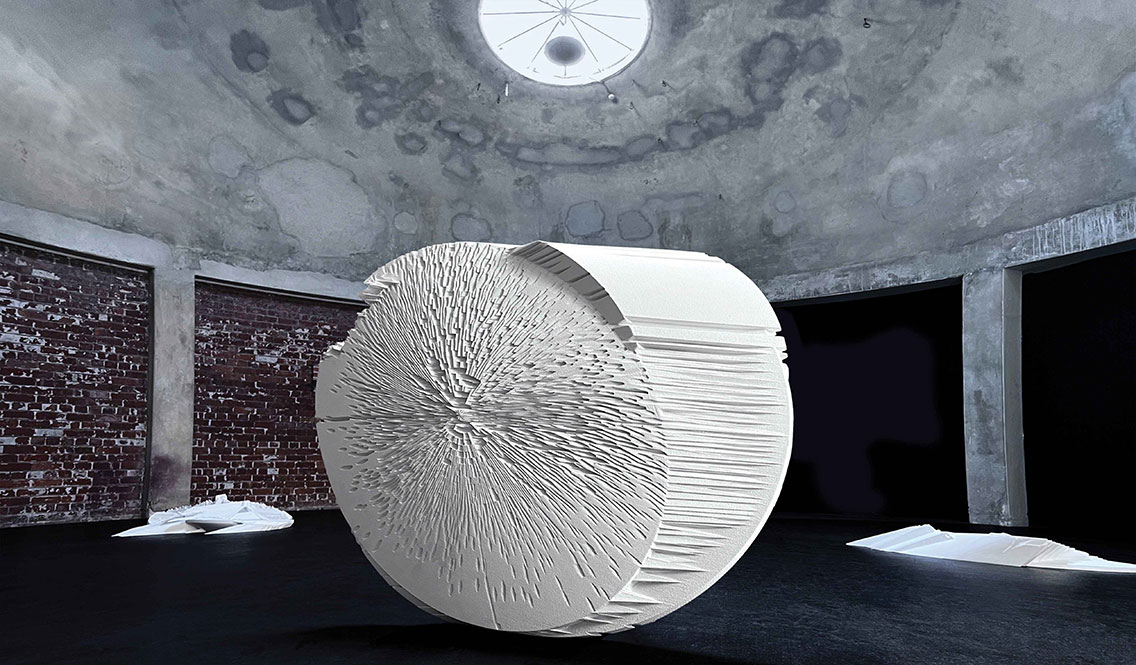
EON Project
Weather tracing frequencies
160 x 110 x 60cm
Bronze, white patina
T.C.L. Landscape Architects Australia, GAGPROJECTS Satellite exhibition 2022
Courtesy the artist
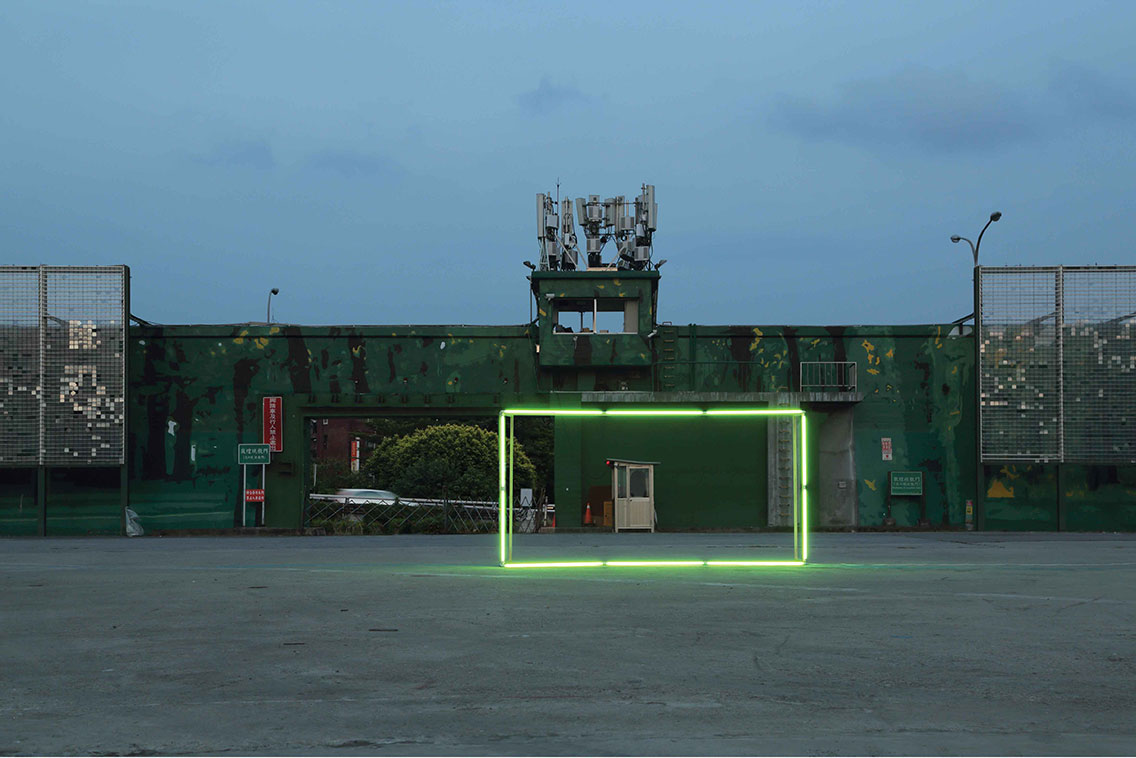
Watergate
Site and time-specific installation at Tamsui River
4 x 2 x 1m
Fluorescent lights, generator, timber structure
Dunhuang Evacuation Gate
Kuandu Museum of Fine Art (KdMoFA), Taiwan 2017
Courtesy the artist

Aqueduct Sluice
Light installation at site of Birrarung (Yarra River) intervention
Neon, solar, battery, converters
Floodplain Project, National Gallery of Victoria 2018
Courtesy the artist
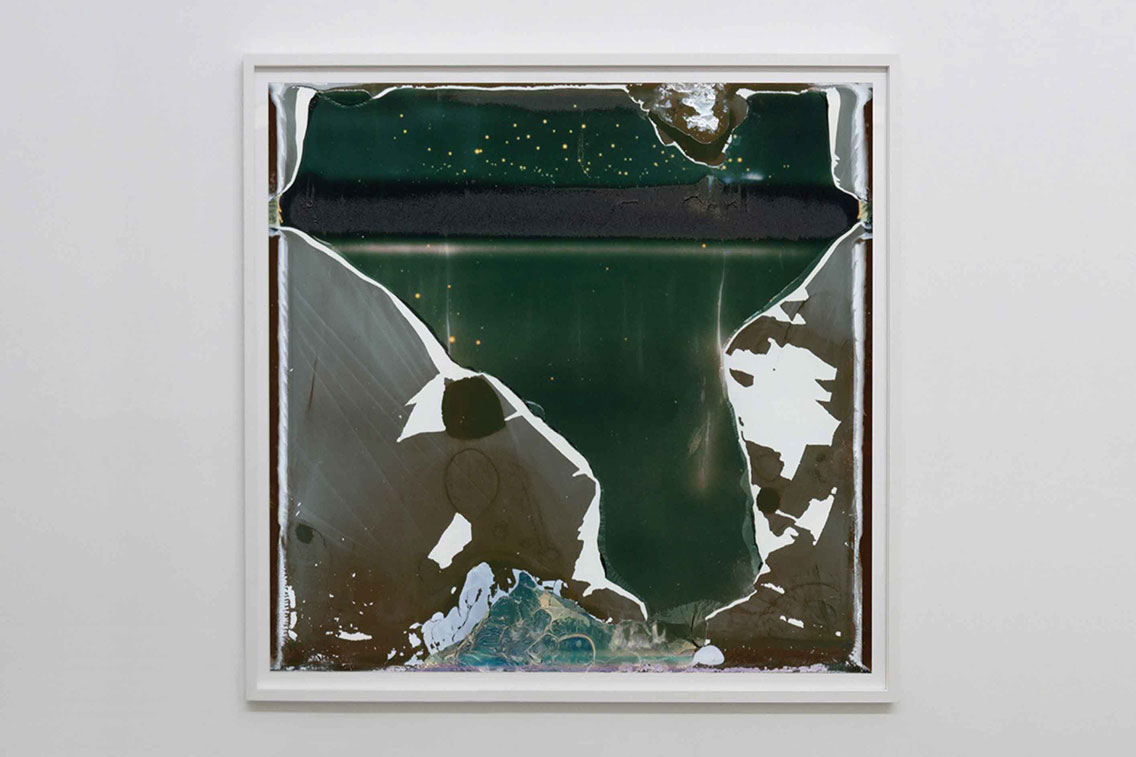
Weather Action_P1 -20
Site-specific atmosphere photograph
150 x 160cm
Polaroid film, weather, dust
Framed print
Seismic Field, GAGPROJECTS 2018
Courtesy the artist
Roots, and a Very Long Leash
Peter Hill in Conversation with artist Franziska Furter
The weather is fundamentally necessary for life on earth but it can also destroy whole livelihoods in seconds. The weather always exists. It’s there day and night and never stops. It’s always in motion and it changes all the time.
—Franziska Furter, artist proposal for NGV Triennial,
3 August 2022
Peter Hill
Your ambitious installation in Melbourne at the NGV Triennial was really in three parts that came together to make a whole. There was the huge, square, tufted rug, comprised of infrared satellite imagery of weather patterns, particularly hurricanes and super-hurricanes. Above it, thousands of glass beads hung like banks of fog. And on the walls of the large gallery hung 19th-century seascape paintings by a range of artists including Turner, drawn from the collection - many of which had not been exhibited in the museum for decades. Did you conceive it like this from the beginning, or did it evolve gradually, up to and including the install? Please talk a little about how you conceived this great work.
Franziska Furter
Since I got the first email from the NGV two years ago the Installation developed and evolved up to the last minute of installing. Many things have changed along the way as it often does. Sometimes I changed things and sometimes changes came from the NGV.
Often my first draft contains many components. I have to find out in which direction I want to go, and I start to reduce and sharpen. While working on the installation I have to learn to trust the work. With this installation it wasn’t easy as I couldn’t just go to the space and spend time there when I had a question as I was on the other side of the planet. I didn’t know the space and its atmosphere in person, so I had to rely on models and ground plans a lot, and also on the curatorial team.
Because models and ground plans only help to a certain point, I often like to keep some decisions open to be able to adapt the work to the space. This is sometimes difficult for the curators and even harder for the installation team because it means things can change last minute. I love it because often it is part of the work and in the end the installation is much better. I had to learn to trust myself with my last moment decisions.
Except for the Falls of Schaffhausen (c. 1845) by JMW Turner, which was already hanging in that gallery and I wanted to keep it, the 19th-century paintings were chosen by the curatorial team who know the collection really intimately. I am super happy about their choices. This Turner painting was on the first list I got from the NGV about the collection in my space and I loved the idea that the painting shows a place in Switzerland. And it travelled all the way to Melbourne, like me. It was the inspiration for Haku, the bead installation.
Peter Hill
Is ‘Weather’ a theme you have worked with before, and if so, how did it manifest itself? Can you describe some earlier projects?
Franziska Furter
The interest in ‘weather’ started in Edinburgh, Scotland where I spent six months as an artist-in-residence in 2000. It was amazingly present all the time and people loved to talk about it constantly as well. And because I was always interested in the invisible, the ephemeral, change and movement of the weather got my attention and seemed to be a great inspiration for my work and a wonderful source for my titles. Most of my works touch on the weather somehow, either directly or peripherally, but it’s always there somewhere. It does shape my work and me, as it shapes our surroundings constantly. Maybe this installation at the NGV is the most direct one so far as I use infrared images of hurricanes for the rug, and in Haku, the beads trigger the association of rain or fog quite directly.
Also in Scotland, coming from a land-locked country like Switzerland, I became addicted to the four-times-daily, mantra-like Shipping Forecast on the BBC, covering the coastal waters of Britain.
Peter Hill
For centuries, romantic and idyllic depictions of the weather, from sublime Swiss Mountain views to French Impressionist picnics on the river, have been superseded by the apocalyptic reality of climate change, global warming, and rising sea levels. I’m interested in your thoughts on this, and where it might lead?
Franziska Furter
I think we need to see and remember both to be able to continue, and not lose trust and hope. There was always beauty and destruction, chaos and order. But we definitely have to change many things to prevent mainly poor people from suffering and animals and plants from getting extinct. Do you know Friederike Otto? She is an amazing scientist who wrote a really interesting book called Angry Weather (2021).
I’ve also just read a great book by Gabriele von Arnim called The Consolation of Beauty (2023), but it may not yet be translated into English. It asks questions like “Can I still enjoy beauty and feel happiness while there is war, climate change and while the planet seems to be collapsing?”
So for me it is important to also talk about beauty with my work. I think often beauty says more about decay than decay itself.
Peter Hill
In her wonderful catalogue essay about your work for the Triennial, titled State of the atmosphere, curator Katharina Prugger describes how you had been collecting infrared images for your archive long before they wound their way into your work, and that the first time you used them was for a series of wearable scarves. I’m fascinated by artists’ archives and the many different forms they take. Can you describe your own archive please, and a side-question from the above is your relationship to fashion. Were the scarves a one-off, or have you created other weather-related fashion-wear?
Franziska Furter
I spend a great deal of my time on research. Or maybe I rather call it “having a sometimes focused, sometimes unfocused, gaze on the world, and letting myself be guided along invisible paths.” I am reading and listening to books and articles, looking at magazines and images, and I love recommendations by others. And when I think that there is a spark, I put it aside or make a note in my sketchbook. I don’t have an orderly archive where I could find specific things again. It’s more like a volcano which spits stuff out like lava every now and again. Other stuff gets lost forever. Sometimes I look at this spitted lava and an idea grows. With the infrared images of the hurricanes, it was the same. I have had them for years, and I tried several things, but it never worked until I did the scarfs, not as an art project, more for fun. Through thinking along the path of textiles I found the technique of tufting rugs and decided to make one by myself. One thing led to the other. I always find out what I want through making, through failing, through keeping on making. Failing is maybe the wrong word because it is only failing in the eyes of my former expectations, but often the unexpected is much more interesting.
Peter Hill
I’m writing a book called The Nomad and the Hermit (In all of us) reflecting both on my time as a lighthouse keeper and on the four-year Fake News and Superfictions worldwide lecture tour I was on, moving from one artist residency to the next—Berlin, Bali, Scotland, Sydney, Tasmania—all cut short by COVID in 2020. Then I went from being a nomad to being a hermit in lockdown. I was delighted to hear that you consider yourself a Nomad too. Can you expand on this, in any way you like, but perhaps also mention the changes in weather patterns as you traverse the globe?
Franziska Furter
I love doing artist residencies. They are very much part of my practice. I wouldn’t call myself a full-hearted nomad as I always had a ‘home’, a place to go back to, a place where I had my materials, my things and my books. This ‘home’ has changed three times within the last 20 years. I went from Basel to London, from there to Berlin, and a few years ago back to Basel. I think I do need roots. And probably a very long leash. I am just back from my three-month trip to Australia, and while I was there, I realised again that I rather stay at one or two places for some weeks and get to know the people and the surroundings, than move from place to place every few days. When I think about it now, it feels like in all the places I went to with a residency the weather was always very present…But maybe that’s just everywhere…nowadays.
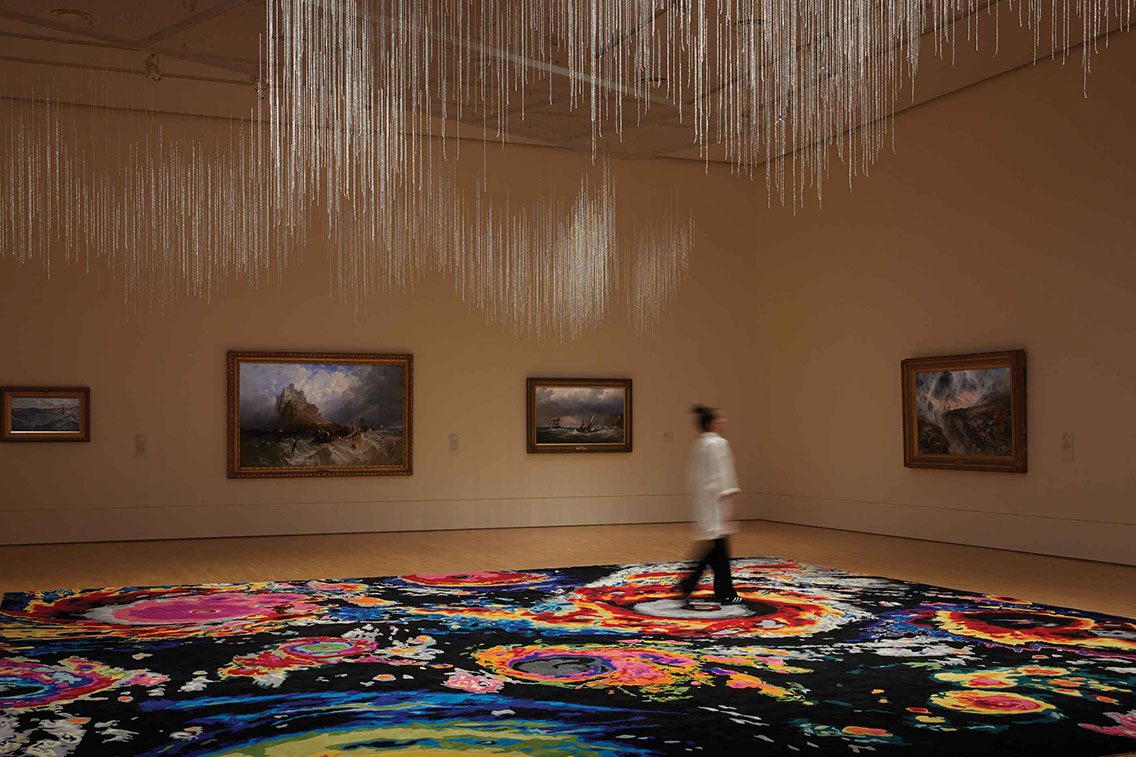
Installation view of Franziska Furter’s work Liquid Skies/Gwrwynton display in NGV
Triennial from 3 Dec 2023–7 Apr 2024 at NGV International, Melbourne.
Photo: Lillie Thompson
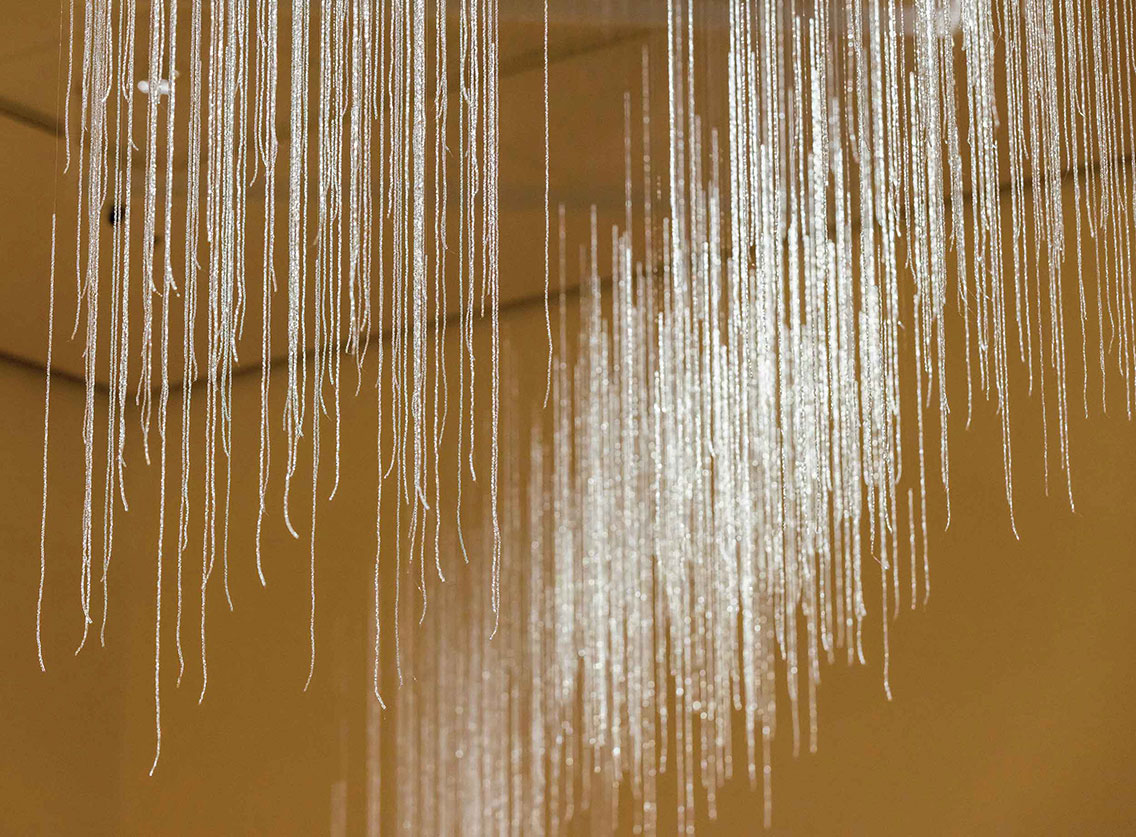
Installation view of Franziska Furter’s work Liquid Skies/Gwrwynton display in NGV
Triennial from 3 Dec 2023–7 Apr 2024 at NGV International, Melbourne.
Photo: Tim Carrafa

J. M. W. TURNER
Falls of Schaffhausen (Val d’Aosta) (c. 1845).
oil on canvas
91.5 x 122.0 cm
National Gallery of Victoria, Melbourne
Purchased with the assistance of a special grant from the
Government of Victoria and donations from Associated
Securities Limited, the Commonwealth Government
(through the Australia Council), the National Gallery Society
of Victoria, the National Art Collections Fund (Great Britain),
The Potter Foundation and other organisations, the Myer
family and the people of Victoria, 1973.
Footnotes
1 Exhibition essay (unpublished), Drawing Field, La Chambre Blanche, Québec 2009. Images and additional text are available at https://www.jamesgeurts.com/projects/water-gate-kdmofa
References
Bacon, Dr Julie Louise. “Beyond interpretation and judgement, writing the story of art.” Drawing Field, La Chambre Blanche, Québec 2009 (unpublished).
Griffon, Anne-Lise. “Reflections of Québec,” Inter Actuel magazine, No 103, Edition Interventions (Quebec) 2009.
Kristensen, Annika. Floodplains: James Geurts. Perimeter Editions, 2018.
Prugger, Katharina. “State of the atmosphere.” NGV Triennial 2023 Exhibition Catalogue. National Gallery of Victoria, 2023.
Essays
According to the National Aeronautics and Space Administration (NASA), weather refers to a short timescale of local climate change, and climate change refers to the broader ranges of changes that are happening to our planet; and global warming is one of the aspects of climate change. Although these terms are sometimes used interchangeably, one thing is certain: “human activities are driving the global warming trend observed since the mid-20th century.”1 The Intergovernmental Panel on Climate Change (IPCC) in its Fifth Assessment Report (AR5) also declared that “human influence on the climate system is clear, and recent anthropogenic emissions of greenhouse gases are the highest in history. […] Warming of the climate system is unequivocal, and since the 1950s, many of the observed changes are unprecedented over decades to millennia.”2 That said, climate change is never a physical phenomenon alone, with climatologist Mike Hulme arguing that it is also a set of cultural ideas (xxv-xxvii).3 In order to understand these ideas requires plural understanding of our relationship with the natural environment.
The liveability of a city is also measured by its sustainability and resilience – that is, how it is designed to provide for future generations and how quickly it can recover from shocks. These issues become more pertinent in an era of climate change, which pose more risks of extreme weather events and other disruptions. The arts are an important platform on which these issues can be explored.
—National Arts Council Singapore4
National Arts Council Singapore (NAC) in its latest Our SG Arts Plan (2023-2027) firmly puts the emphasis on the vital role of the arts in facilitating the discussion of these cultural ideas. Our understanding about the physical weather, climate change, global warming and environmental degradation is filtered through our perception of what they mean for us. How do we feel about them; sad, angry, fear, happy, or schadenfreude? Are the changes a threat, a challenge, a disaster, an opportunity, or a blessing? What do we want to do about them? Or do we want to/can we do something about them? Underneath these questions, it is all about us and our perception of sustainability. What defines sustainability? Who defines it? Driven by these questions, the paper focuses on the investigation of the project Alternative Ecology: The Community (2024), which aims to render a sensible network of ecological solidarity through creative practices. Different from the common approach of ecology that is rooted in the context of biology, Alternative Ecology discusses artists’ engagement with the crisis of climate change and environmental degradation. Through a combined mode of eco-aesthetics and action-driven inquiry that includes public art, discussion, workshops, talks, community gatherings, markets, guided tours and research sharing, I argue that the broad public engagement of Alternative Ecology with a multidisciplinary approach demonstrates a critical willingness in the humanities—artistic humanities. Artistic humanities, through the lens of art, bring the concern of environmental change more visibly to people’s everyday living—a genuine, ground-up approach for real change.
Alternative Ecology: The Community
Alternative Ecology is a project commissioned by NAC for Singapore Art Week (SAW) 2024 awarded from an open call selection. NAC’s commission award, in its vision of Our SG Arts Plan (2023-2027), reflects that the arts are the important platforms on which sustainability should be explored. The project has received additional support from Objectifs – Centre for Photography and Film, LASALLE College of the Arts (LASALLE), University of the Arts Singapore (UAS) and Zarch Collaboratives Pte Ltd. It was held from 13 to 28 January 2024 at the communal courtyard open-space of Objectifs and presented by the independent art space Comma Space. Conceived primarily as an art and ecology event, it was curated by myself and managed by artist Susanna Tan. The project consisted of three key components. The first, a sculptural social space titled Fragment of the Unknown Memory, made from bamboo by late artist/architect Eko Prawoto (1958–2023, Indonesia), which was constructed by his family and studio on site. The second, a series of programme activations, titled Bamboo Broadcast Studio, executed by Post-Museum (Singapore), which included some of their signature events, such as Really Really Free Market and Renew Earth Sweat Shop. The third, the curatorial activations planned by me, which included symposiums, eco-community booths and Sustainability Circle Meet-up. The project’s objective is:
to offer creative interpretations of the profound environmental challenges that we face today, and at the same time, explore the parallel role of an artist in acting as a catalyst for fostering community collaboration and promoting awareness through creative interpretations and discussions. This project demonstrates that art practices from the ground up come with a unique ‘magnetic field’ that connects the public, communities, professionals, creative practitioners from all walks of life to shape a liveable future.5
I consider Alternative Ecology an optimistic project embracing community as a key framework in defining the critical perspective on human relationships with our changing planet. It intends to create a site of alternative encounters to generate new possibilities in which art matters not only for viewing but also for taking action. Besides involving artists locally and internationally, the project evidentially has ‘magnetised’ people from disparate professions, allowing them to meet and communicate about the sustainability that matters to the everyday life of ordinary people, which I will explain further in the following chapters.

Alternative Ecology: The Community project poster
Crafting eco-aesthetics

Top view, Fragment of the Unknown Memory by Eko Prawoto, 2024
One of the critical components of the project is the use of the organic material bamboo to create a holding space – a social space. Being a member of the grass family, bamboo has a long history of being easy and flexible to use (wide range of species and heights) and environmentally sustainable (rapid growth) in its usage by humans. In early 2023, I started the conversation with Prawoto, a Yogyakarta based Indonesian artist/architect, to conceptualise a public art site specifically in the open space of Objectifs using only bamboo. However, Prawoto’s sudden passing on 13 September 2023 put the project on hold, with no certainty if it could still be carried out. Fortunately, Prawoto’s family and studio were determined to realise his final artwork in the most desirable way that he would have imagined. With their support and commitment, Prawoto’s final artwork, Fragment for Alternative Ecology, was hand-built by his family and studio on site as planned. The first activation within this space was the private memorial for Prawoto with invited guests who had worked with and known him in Singapore.
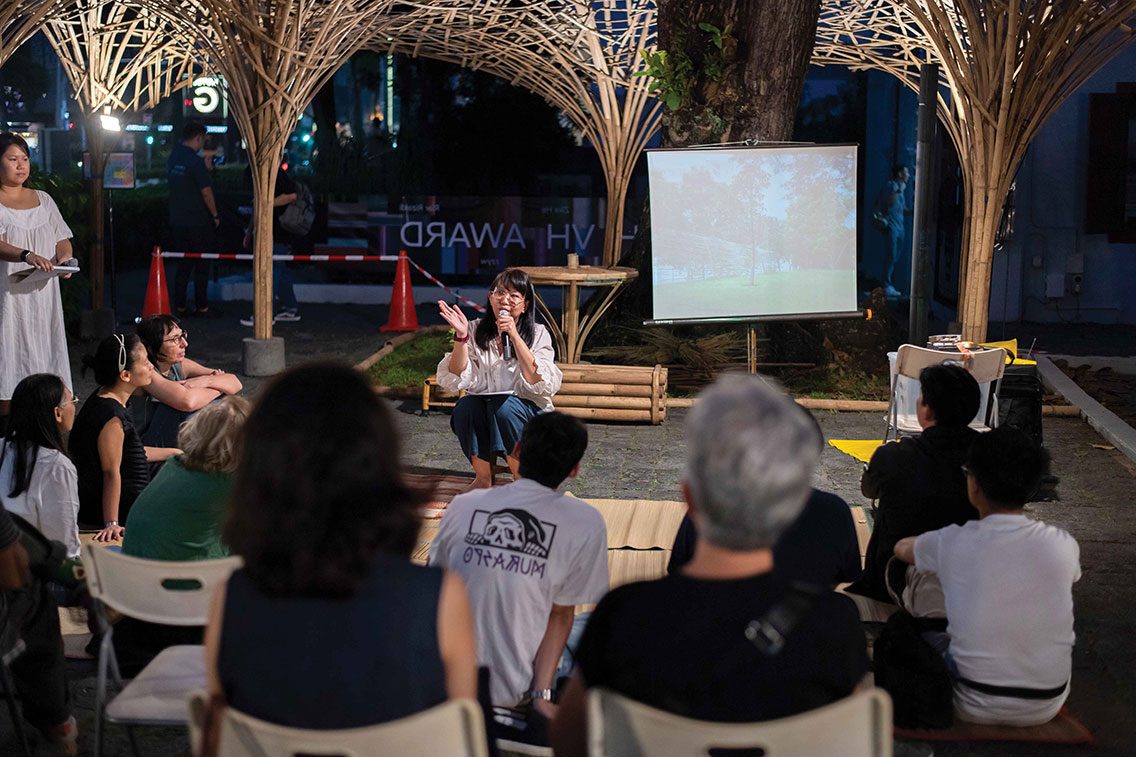
Private memorial of Eko Prawoto. Speaker Tamares Goh, curator of
Prawoto’s solo Garbha at the Esplanade–Theatres on the Bay in 2012

Private memorial of Eko Prawoto. Speaker Tegar Jati Prawoto,
youngest son of Prawoto
Ultimately, Fragment is conceived as a metaphor of ‘a better world’ underlined with a greener, humanistic and compassionate approach. It is an apt demonstration of Prawoto’s practice in believing “all humans share a universal connection to nature which defines our existence.”6 Prawoto is most well-known for his humanist and environmentally sustainable approach to his practices. He is a familiar name in Southeast Asian countries. His Wormhole, for example, the Singapore Biennale 2013 commission which consisted of three large bamboo mounds resembling the range of mountains in Indonesia, has been one of the most fondly remembered public art exhibits in Singapore. Tracing back, he first gained international acclaim taking part in the Venice Biennale of Architecture, Less Aesthetics, More Ethics (2000), which showcased his artistic, architectural rendering The Transitory Place: A Housing Project for the Urban Poor in Yogyakarta.7 Intriguing to notice that though the Biennale was dealing with the situation of less aesthetics, Prawoto’s artworks are indisputably beautiful. The appeal of aesthetics entrenched in the material of bamboo, as well as in the craft of the handmade, is irrefutable. The handmade is intimately tied to materiality. In the cultural framework of mass production, handmade is a sign, a symbol for anti-capitalist and anti-globalisation critique. Further, it demonstrates a mode of production that is tied to the inquiry of identity and culture in meeting not only personal but also collective needs.8

Side view, Fragment of the Unknown Memory by Eko Prawoto
Situated in the communal courtyard, which is heavily utilised by the general public on an everyday basis, Fragment, in its immersive scale and impressive handmade form, stands openly and elegantly, and cannot be unseen even when there is no programme activation. According to Herbert Marcuse, when “[i]n a situation where the miserable reality can be changed only through radical political praxis, the concern with aesthetics demands justification.”9 The beauty here embraced in Fragment standing solitarily occupying a newly claimed public space needs to be justified. In its upfront organic/handmade material state, Fragment visually enfolds the idea of eco-aesthetics functioning as an enquiry into the sensory knowledge of our natural environment that has been disrespected and ignored. It presents a delightful invitation, but at the same time, is a passive resistance to a society based on the values of capital. Along this line of thinking, the curatorial inclusion of Fragment offers, as what Kester argues, “the ability of aesthetic experience to transform our perceptions of difference and to open space for forms of knowledge that challenge cognitive, social, or political conventions.”10
Dialogical-based activations
As a structure, it is not yet complete. I would like to invite visitors to participate in the completion process. In that way, it will be our shared memory, our shared journey as human beings
—Prawoto11
Prawoto considered his structure incomplete without the engagement of the visitors. If we see his handcrafted Fragment as an open invitation for people to stop by and embrace, similar to those purposefully designed birdhouses hanging in the gardens waiting for the visit of birds, the programme activations by Post-Museum and me are a variety of ‘seeds’ curated to attract birds, i.e. the public. The public’s participation activated these programmes, and only with their engagement can Alternative Ecology be complete(d). Activations, utilised in this framework, are socially engaged, dialogic, action and community-based artistic social practices, which are, however, not new. As early as in the 90s, Suzi Gablik (1991)12 and Hal Foster (1996)13 have already discussed the growing need for contemporary artists interested in socially interactive art to resist bourgeois culture via making art to be useful and not just made for an aesthetic pleasure. In Singapore, community-based arts have a long history too, which has witnessed a substantial increase over the years.14 Nevertheless, in regard to art and environmental projects of this scale from a community and ground-up perspective, Alternative Ecology marks a new record. It initiated a total of 20 public activations and one private memorial hosted in the Fragment. Among them, 17 public activations were by Post-Museum, and four by me. The project attracted more than 1,115 active participants (directly participating in the activations) and at least 12,000 passive participants (the general public).
Post-Museum’s 17 activations in its totality are called Bamboo Broadcast Studio, comprising some of their signature programmes over the years. Post-Museum was established in 2007 in Singapore by husband-and-wife artists Jennifer Teo and Woon Tien Wei. They are widely known locally and internationally as “… a networked collective that creates situations and projects with local communities in order to understand and reimagine contemporary life.”15 They used to run a physical space in two shophouses on Rowell Road in the Kampong Kapur area between 2007 and 2011. During that period of time, their space was a popular network destination for cultural practitioners. Currently they are being nomadic. According to them: “Being ‘nomadic’ allows our practice to be ‘place’ driven. We are interested in how we can ‘practise the city’ in more meaningful ways. To ‘practise the city’ for us means asserting and claiming the ‘right to the city.’”16
Alternative Ecology offers a practising ground in the city centre that facilitated the “practice the city” and continue to claim the “right to the city”. As for myself, my art practices focus on our position with our environment in the contexts of ecology and knowledge production. Although I mainly played the role of a curator for Alternative Ecology, my approach to the overall project and the planning of the activations is, to a great extent, a form of artmaking, promoting the ideas of socially responsible art and building ecological communities through curating.
Our activations cover a wide range of community-based approaches, which broadly can be categorically defined as workshops, talks, education booths, free markets, tours and gatherings. The primary purpose for us is to enable the participation of people from various non-art sectors through artistic and creative means. For example, on 21 January in the hours 12–7pm, we hosted three activations. The first, Water Symposium, involved a moderator and speakers from Our Singapore Reefs, Stridy, Friends of Marine Park, Waterways Watch Society, Marine Conservation Groups, Nature Society Singapore, Young Nautilus and an independent artist, addressing the pressing challenges and exciting opportunities surrounding water conservation from the perspectives of environmental NGOs, scientists, volunteers and artists.17 The second, Sustainability Symposium, with a moderator and speakers from Nature Society Singapore, Singapore Youth Voices for Biodiversity, Post-Museum and LASALLE, discussed in depth how every one of us can take the lead to be change makers in coping with the challenge of sustainability.18 The third, comprises eco-community booths from Nature Society Singapore, Young Nautilus, Stridy and Textile Paper Lab presenting informative and hands-on activities for the participants and general public, raising environmental awareness. On that day we attracted a total of 157 direct participants from diverse professions. These activations effectively demonstrate that the bottom-up approach of making art is more relevant in formulating new social relations with like-minded grassroot organisations and individuals.

Water Symposium

Sustainability Symposium
“Alternative Ecology shared the official opening date of 20 January 2023 with two other indoor exhibitions organised by Objectifs: A Reservoir of Time and the 5th VH Award Exhibition. On the opening day, instead of providing buffets, like most exhibitions do in Singapore, we hosted Stone Soup Party—an interactive relational aesthetic practice. Drawing reference from the European folk tale Stone Soup, the party encouraged the public to bring along a vegetable (preferably locally grown and organic) and cook with us in the kitchen we set up under the Fragment. The soup with the participants’ contributions was shared with others. There were 278 visitors, with about half of them either bringing vegetables for cooking, and/or drinking soup from this sharing activation.


Stone Soup Party
Besides the bottom-up approach, we also hosted the Sustainability Circle Meet-up & Eco-Karaoke activation in collaboration with the Ministry of Sustainability and the Environment (MSE). Through the network of MSE, Sustainability Circle received people from different backgrounds coming together, sharing their sustainable practices either for business or everyday life hacks, and engaging in thoughtful conversations. It was a magical and fun night in connecting other fellow sustainability enablers (individuals, companies, ministry, organisations; a total of 82 people) in finding available support to further their sustainability goals.


Sustainability Circle Meet-up & Eco-Karaoke
On its closing day, we activated Really Really Free Market. Started in 2009, Really is a temporary ‘free’ market concept based on alternative gift economy. Built on the valuable acts of giving, sharing and caring, the project creates a temporal physical manifestation of a micro-utopia where the fundamental economic structure is being questioned.19 It is in its 77th edition, which was hosted on 28 January from 10am to 4pm. It attracted about 150 participants from all walks of life. Placing Really as the closing event of Alternative Ecology reflects the project team’s mindfulness on resource sustainability. At the closure of the project, the team successfully repurposed all the materials used to build Fragment (bamboo and bases), so nothing went to waste.
A site for humanities - artistic humanities
For geographer Doreen Massey, space is socially and contingently constructed, which is always in the process of being made. It is a product of interrelations and outcome of multiplicity of encountering.20 Fragment craved out a temporary site in a busy urban space. Its elegant low-technological gesture offered an eco-aesthetic temptation in uplifting such an encounter of space-making. Not relying on Fragment‘s materialised physical form alone but paired with the programme activations, the newly but temporarily claimed space inspires a social and imaginative interchange that is open-ended, exploratory and becoming (process driven). The project is quite different from Olafur Eliasson’s The Weather Project (2002), which was created with lights, projection and haze machines, to generate a spectacular site of climatical experience in Tate Modern’s Turbine Hall. Alternative Ecology, in contrast, in its totality, built by a humble dialogue-based community drawing inspiration from traditional and ancient knowledge. Besides the activations such as Stone Soup Party drawing inspiration from European folk tale in the early chapter, I would like to mention another activation, Animals’ Lawsuit Against Humanity. This is a reading performance led by the environmental and natural health educator Betty Khoo. She guided the participants to make animal masks, read the ancient animal rights tale from 10th Century Iraqi’s ecological fables, and then further presented the reading with a live argument between animals and humans resembling the format of a court hearing. A total of 25 children and adults from the public took part in the reading performance. Animals’ purposefully swapped the role of animal and human. Utilising dialogical-based participatory imagination, it put humans in the defendant’s position, forcing them to listen to others.

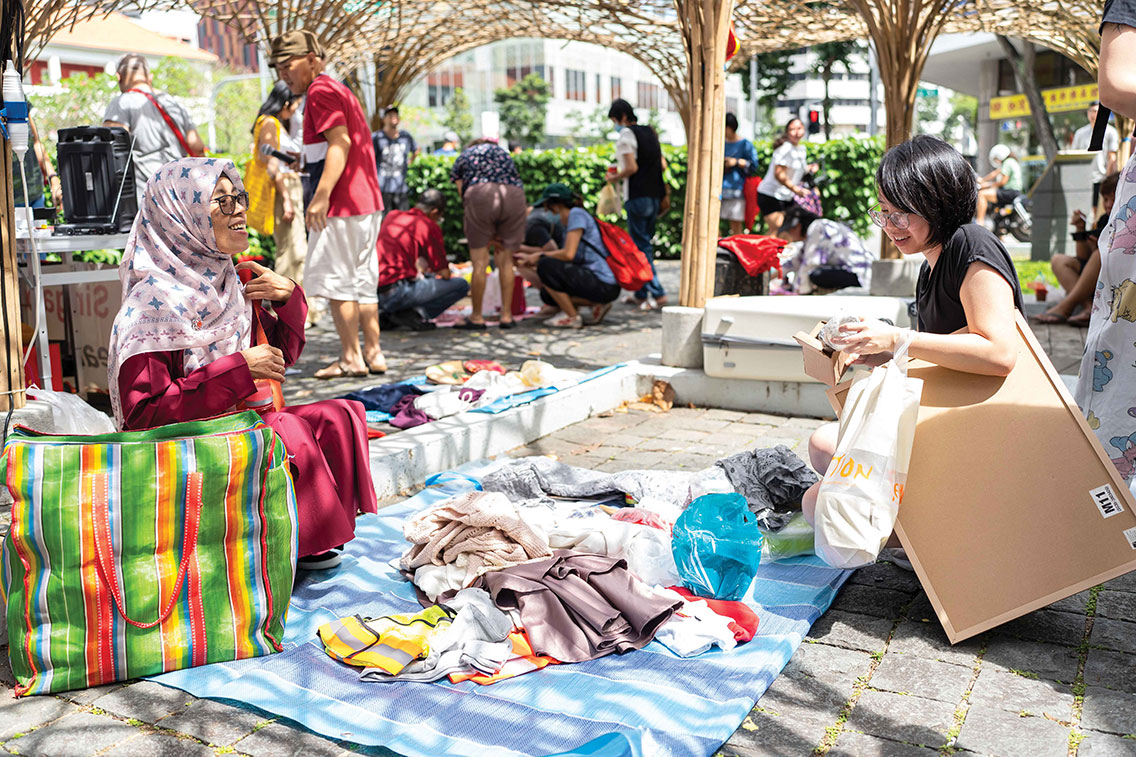
Really Really Free Market 77
The Animals’ role play acutely reveals that the temporary site created with Alternative Ecology is not owned by Prawoto, Post-Museum or the curator. Rather, it is co-owned, co-created and co-completed with the involvement of individuals, organisations, and local stakeholders from the ground, on the ground and for the ground. That said, Alternative Ecology has made a site—a site for humanity. It embodied the central concept of this project, which is fundamentally grounded in the ethic of care, conversation and respect engaged with active listening. Furthermore, it reflected the key curatorial framework in believing that environmental problems are a cultural and existential problem which requires understanding and awareness of our values and beliefs, and changing our basic ideas about how we should live. According to Kester, the arts eventually emerge in the discursive relationship established with the participants.21 In the case of Alternative Ecology, the arts arise from a process of conversation, individual and collective exchanges rooted in the humanities. Artistic humanities shown in the artists’ and curator’s active listening and empathetic care are visibly driven by the willingness to let the community shape their practices and themselves, which are established on a mutual influence.
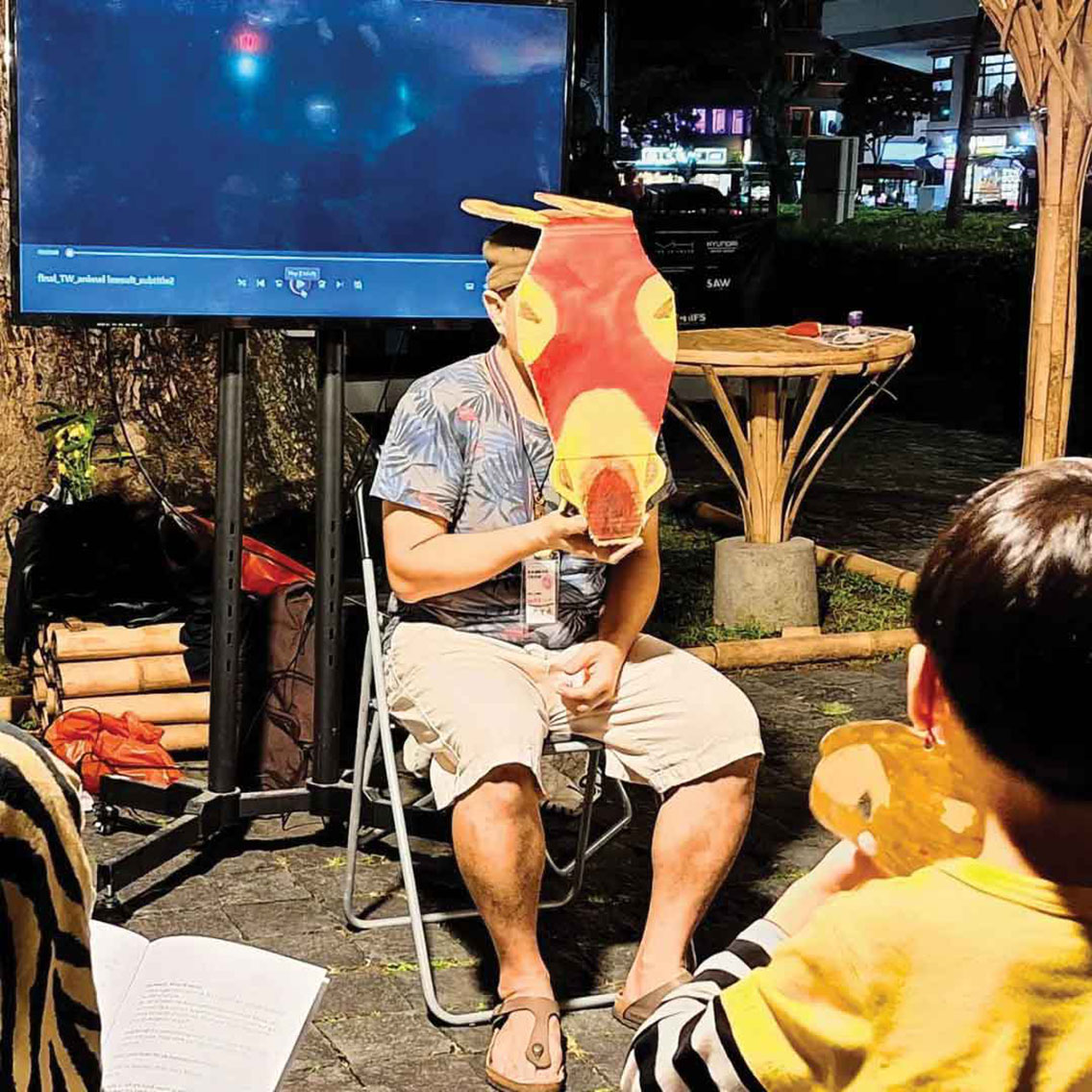
Animals’ Lawsuit Against Humanity
Photo: Nor Lastrina Hamid
What underlines the artistic humanities manifests the broader concept of environmental humanities. Hubbell and Ryan argued that environmental humanities “demand that people from a range of disciplines listen to one another, participate in a lively dialogue, and contribute ideas to the decision-making process.”22 From the project participants’ statistics, we can see Alternative Ecology has drawn participants from wide diverse backgrounds hitting a record number within the 16-day exhibition period. The participants included yoga instructors, filmmakers, geographers, marketing managers, scientists, retires, freelancers, homemakers, administrators, government officers, entrepreneurs, environmentalists, students and educators. They gathered and sat under the Fragment, took part in the programmes to engage, meet, learn, listen and experience. Though these exchanges are limited in verbal conversation and hands-on activities, they are indispensably filled with exchange of values. Such exchanges may not necessarily successfully create an alternative ecology with a direct cause-and-effect solution. In view of the global environmental threat in its magnitude, depth and complexity, it would be implausible to insist that art can avert global warming. What matters the most here is the multi-dimensional understanding and awareness enabled by artistic humanities. Claire Bishop is sceptical of such exchanges in feel-good community services provided by art, which may have misguided people. She argues that “artistic models of democracy have only a tenuous relationship to actual forms of democracy.”23 Although I acknowledge Bishop’s trenchant charge on the discursive outcome of social practices, I maintain that though it is difficult to provide statistics to prove the effectiveness of socially engaged art, the impact of such practices should nevertheless not be underestimated.
Curator Cecilie Sachs Olsen believes that “socially engaged art can work as an active and generative force in questioning given ‘truths’ and identities.”24 Likewise, art historian Wang Meiqin acknowledges that “[f]undamentally the purpose of SEPA [socially engaged public art]… is to enable people to work together to activate space, place and community that matter to the everyday life of ordinary people.”25 Once in an interview, Post-Museum said, “We believed that art should change the world, or it should participate in shaping a better world”.26 Post-Museum is clearly an optimistic and firm believer of the social responsibility of an artist. Echoing their views, I believe that art projects embracing artistic humanities rising from the ground for the community can play a critical role in contributing to compelling cognisance of the cultural ideas that Hulme reminded us to face today. Taking shape from both object-based (Fragment) and non-object dialogical based practices (activations), Alternative Ecology shows, in its broad multidisciplinary approach and humanistic curatorial framework, that contemporary artists today seek to more fully integrate their roles into the real-world issues by engaging the public and claiming the public sites. Artistic humanities are the humanities constructed through the processes of exchange, appreciation and communication between the artist, curator and interlocutors. This is based on a holistic approach in learning from and listening to each other respectfully. Artistic humanities are of critical importance in bringing climate change and environmental crisis into discussion, and in defining the set of cultural ideas on our relationship with the changing planet.
Unless otherwise stated, all photos: Comma space/ Wang Ruobing.
Footnotes
1 Global Climate Change. National Aeronautics and Space Administration.
2 AR5 Synthesis Report: Climate Change 2014. The Intergovernmental Panel on Climate Change, 2014.
3 Hulme, Why We Disagree About Climate Change: Understanding Controversy, Inaction and Opportunity, 2009.
4 Our SG Arts Plan (2023-2027). National Arts Council Singapore, 2023.
5 “Alternative Ecology: The Community,” Comma Space.
6 Wang, Ruobing, Placing Home Woodlands, 9.
7 Lentchner, “Eko Prawoto,
1958-2023.”
8 Black and Burisch 1-9.
9 Marcuse, The Aesthetic Dimension 1.
10 2011, The One and the Many, 11.
11 Foo, “Transcript: Interview with Eko Prawoto and Natalie Foo,” Garbha, 7 .
12 The Reenchantment of Art, 1991.
13 The Return of the Real: The Avant Garde at the End of the Century, 1996.
14 Cho, Duong, and Nasution 683-699.
15 “Alternative Ecology: The Community.”
16 Sanchez 102.
17 This panel consists of moderator/chair Sam Shu Qin (Our Singapore Reefs), and speakers Vanessa Tan (Stridy), Stephen Beng (Friends of Marine Park), Ding Kian Seng (Waterways Watch Society), Charles Lim (Artist), Lester Tan (Marine Conservation Group, Nature Society Singapore) and Ng Lee Kiang (Young Nautilus).
18 This panel consists of moderator/chair: Shawn Lum (Nature Society Singapore), speakers Ang Xiao Ting (Practice Tuckshop, Theatre Practice), Wang Ruobing (LASALLE College of the Arts), Gretel Seet (Singapore Youth Voices for Biodiversity) and Woon Tien Wei, Post-Museum.
19 Woon 23.
20 Massey 9.
21 1999, “The Art of Listening (and Being Heard),” 19.
22 Hubbell and John 3
23 Bishop 5.
24 Sachs 192.
25 Wang, Meiqin 11.
26 Sanchez.
References
“Alternative Ecology: The Community.” Comma Space. https://comma-space.com/alternative-ecology-the-community/. Accessed 2 Feb. 2024
AR5 Synthesis Report: Climate Change 2014. The Intergovernmental Panel on Climate Change, 2014, https://www.ipcc.ch/report/ar5/syr/. Accessed 10 Jan. 2024
Bishop, Claire. Artificial Hells: Participatory Art and the Politics of Spectatorship. Verso, 2012.
Black, Anthea and Burisch, Nicole. The New Politics of the Handmade: Craft, Art and Design. Bloomsbury Visual Arts, 2019
Cho, Im Sik, Duong, Quyen, and Nasution, Ivan. “Role of Research in Community Arts: Developing an Evaluation Framework in Singapore.” Community Development, vol. 47, Issue 5, Dec. 2016, pp 683-699.
Foo, Natalie. “Transcript: Interview with Eko Prawoto and Natalie Foo.” Garbha. Esplanade–Theatres on the Bay, 2012.
Foster, Hal. The Return of the Real: The Avant Garde at the End of the Century. The MIT University Press, 1996.
Gablik, Suzi. The Reenchantment of Art. Thames & Hudson, 1991.
“Global Climate Change.” NASA (National Aeronautics and Space Administration), https://climate.nasa.gov. Accessed 3 Jan. 2024
Hubbell, Andrew and Ryan, John. Introduction to the Environmental Humanities. Routledge, 2021.
Hulme, Mike. Why We Disagree About Climate Change: Understanding Controversy, Inaction and Opportunity. Cambridge University Press, 2009.
Kester, Grant. “The Art of Listening (and Being Heard): Jay Koh’s Discursive Networks”. Third Text: Third World Perspectives on Contemporary Art and Culture, 1999, vol. 47, 19-26.
Kester, Grant. The One and the Many: Contemporary Collaborative Art in a Global Context. Duke University Press, 2011.
Lentchner, Anna. “Eko Prawoto, 1958-2023.” ArtAsiaPacific, 25 Sep. 2023, https://artasiapacific.com/news/eko-prawoto-1958-2023. Accessed 9 Jan. 2024
Marcuse, Herbert. The Aesthetic Dimension: Toward a Critique of Marxist Aesthetics. Beacon Press, 1978.
Massey, Doreen. For Space. Sage, 2005.
Our SG Arts Plan (2023-2027). National Arts Council Singapore, 2023, https://www.nac.gov.sg/docs/default-source/the-arts-plan/our-sg-arts-plan_2023---2027_phase-4_updated.pdf?sfvrsn=bf188896_2. Accessed 15 Dec. 2023
Sachs, Cecilie. Socially Engaged Art and the Neoliberal City. Routledge, 2019.
Sanchez, Carolina. “Interview with the Founders of POST-MUSEUM: Jennifer Teo and Woon Tien Wei”. ONCURATING. Issue 41, 2019, pp 102-104.
Wang, Meiqin. Socially Engaged Public Art in East Asia: Space, Place and Community in Action. Vernon Press, 2022.
Wang, Ruobing. Placing Home Woodlands. Catalogue, self-published, 2018.
Woon, Tien Wei. “Still Here Somehow: Artists and Cultural Activism in Singapore’s Renaissance.” ONCURATING, Issue 35, 2017, pp 11-23.
Conversation
Hà Nội: Weathered Art: Radical Instinct, Community resilience and forecasting in a post-colonial space
ISSUE editor Venka Purushothaman in conversation with artists Tran Luong, Mithu Sen, Milenko Prvački and weatherman Huy Nguyen.
This conversation occurred in the ancient city of Hà Nội in Vietnam at APD Center (Art, Patronage and Development), on 21 and 22 March 2024. The discussion aims to be as close as possible to the participants’ comments within the vernacular expressions and has only been edited for clarity where needed. The original transcription was considerably longer; the present form is a focused rendition.
Inner Voices; River Stories
Venka Purushothaman
Thank you, everyone, for joining us.
ISSUE art journal is committed to giving artists a voice, not through their art but by listening to what they’ve got to say. Because artists are often rather silent when their works speak for them in many ways, this conversation aims to open a multidimensional space to explore your methods, materials, life, practice, and concerns. For us at the journal, the conversations are an important part of constructing an emerging artist ecosystem for our contemporary times.
The conversation is centred around the theme of Weather. We were quite concerned that there is deep concern and obsession with climate change, which is important. However, it has also become a distraction from other core concerns in society. For example, rising poverty, emerging youth populations, ageing communities, etc., are equally fighting for attention. So, we wanted to look at the concept of weather as a broader idea. One that looks at the condition of artists—what is the weather of our time? What is your weather?
We want to focus on three things. One of which is to invite you to share with us your current artistic practice, what you are currently working on, and why. Second, we are interested in your material, from objects to ideas, and thirdly, what are the kind of concerns that are preventing you from achieving what you’re doing in your practice, right?
Milenko Prvački
Weather influences us, as artists, definitely. It influences us in creating and rethinking our practice and the place where we’re staying. When Venka mentions our own practice, it’s not the presentation that you have to show but talk about how your practice is affected by weather or climate change. I have to say we cannot avoid politics, especially in Southeast Asia, because there are similar issues, and we will not publish anything you find that’s too risky for you.
Tran Luong: Artist as a social community developer
Tran Luong
Thank you for coming to my space. I am busy preparing for big works and preparing a book to be published by Mousse Publishing House in Italy. A retrospective of my work is being planned to be toured from Dubai, Australia, and New Zealand. My work cannot be shown in Vietnam. It contains politics and is sometimes also banned. People here have not seen my work.
Also, I have been involved in social development work with the UNDP1. So, in some projects, I play the role of a curator. From 2010 to 2012 ed, Riverscapes in flux2,invited and this was followed by an exhibition tour through Vietnam, Thailand, Cambodia, Indonesia, Myanmar, and the Philippines for the next 2 years. Unfortunately, the project did not include Singapore because you don’t have a river. The project enabled artists from Indonesia, the Philippines, Thailand, Vietnam, Cambodia and Malaysia involved, to go to a site for four months and study the environment and create work. The activity is on the engagement of artists with the environment rather than an exhibition. Artists have to learn how activists approach environmental and climate changes and discuss this with the curators. The project pushes the curators out of their ivory towers to work, dialogue and learn.
I must say that every project we have undertaken since around 2005 has already concerned us with the impact of climate change and global warming at that moment. Also, the dam construction in the Mekong River is of concern. The government does not like activists talking about the dams by the Chinese. The damming in many places, funded by Chinese money in places like Laos, is destroying the ecology of the Mekong Delta. We often hear in the news that an entire row of houses had fallen into the river because of over-construction.3 A lot of people fall into the river and die. In the last ten years, the damming upstream has reduced 35% to 40% of water coming downstream. That’s why the level of freshwater is not enough, and then the seawater seeps into the land. Rice farming in Vietnam has come down because the salt water comes 80 kilometres deep into the Mekong Delta.
Milenko Prvački
No one follows international law, or they are not obliged because it’s not their own river?
1 United Nations Development Programme
2 The project was sponsored and organised by the Goethe Institute Hanoi in collaboration with Goethe Institutes in the region.
3 According to Tran Luong, entire rows of houses collapsed into the river because the banks of the Mekong River collapsed. Riverbank erosion began to increase sharply in 2000 after China built eight dams on the upper reaches of the Mekong River. In the past, the highest average water flow speed was nine metres per second, but since the dam system and river bed improvements, the water flow has reached 13 metres per second or even more, which has impacted the riverbank causing landslides.
Tran Luong
Yeah, no one actually likes a water war. All Mekong River countries only look at immediate benefits, lack responsibility and vision, and China wants to control water resources as a political and military means, and direct water flows for internal purposes in their territory. So, we organise ourselves as a civil society and work in the mangrove forest in the Mekong Delta. But we get into trouble with the government and the corporations. You have to grow mangrove forests to protect eroding seashore. Because there is an increasing lack of flood water from the upstream due to the increase in the number of dams, higher sea levels have eroded into the mainland, and strong waves during the monsoon season wipe out mangrove forests and cause coastal erosion, each year depending on the region. We have lost land along the coast, the heaviest is the Mekong Delta, with some places lost from 35 to 50 metres per year.
Venka Purushothaman
Can you share with me how your interest in social development was formed? Where and what did you study?
Tran Luong
I came from a very backward European academy in Hanoi called Indochine École des Beaux-Arts. That is the only degree I have officially. The school was established by France in 1925, almost 100 years, and was one of the very early academy art schools in Southeast Asia and the Mekong region. People came from Phnom Penh, Bangkok, Saigon, and went to Hanoi to study. The school was a copy of École de Beaux-Arts in Paris and two professors from Paris, came to the founding of the Hanoi school. The school was very French style, very European French style. For about 6 decades, students from Saigon, Cambodia and Laos had to come to Hanoi to study at this school.
I studied during the war, so we spent a lot of time on field trips. I was born during the Cold War in 1960, and I was five years old when the Americans bombed Hanoi and North Vietnam. All children and women had to go to the countryside to hide from the bombing, so I did not go to school until I was 12 years old. I was actually born into an intellectual family quite high class, but I actually grew up as a countryside boy.
The first time they (the government) sent us to the countryside with our parents, they said it was for a few weeks. But finally, we were in the countryside in a different province for seven years. There was no school there, so I was self-taught. In fact, there are still schools in the countryside, but because of the war, sometimes the schools are open, sometimes they are not. Also, city children like us cannot attend school in the village, because every once in a while we have to move to a new location, which can be a way to ensure our safety. I have good skills in catching fish and swimming in the river, and that is attached to my artworks a lot, until today. I am totally a countryside boy.
The end of 1972 was the hardest bombing, which destroyed Hanoi a lot. And the Americans destroyed the whole country—like they say, carpet bombing with B-52s. They have big B-52s and throw small bombs 20sqm to each corner. So it’s like, destroy everything! And when they bomb, that means they make everything flat. And in Hanoi, they make the whole Kham Thien Street flat, killing thousands of people.

Tran Luong’s performance at the opening exhibition Polyphony Southeast Asia at AMNUA Nanjing, China 2019.
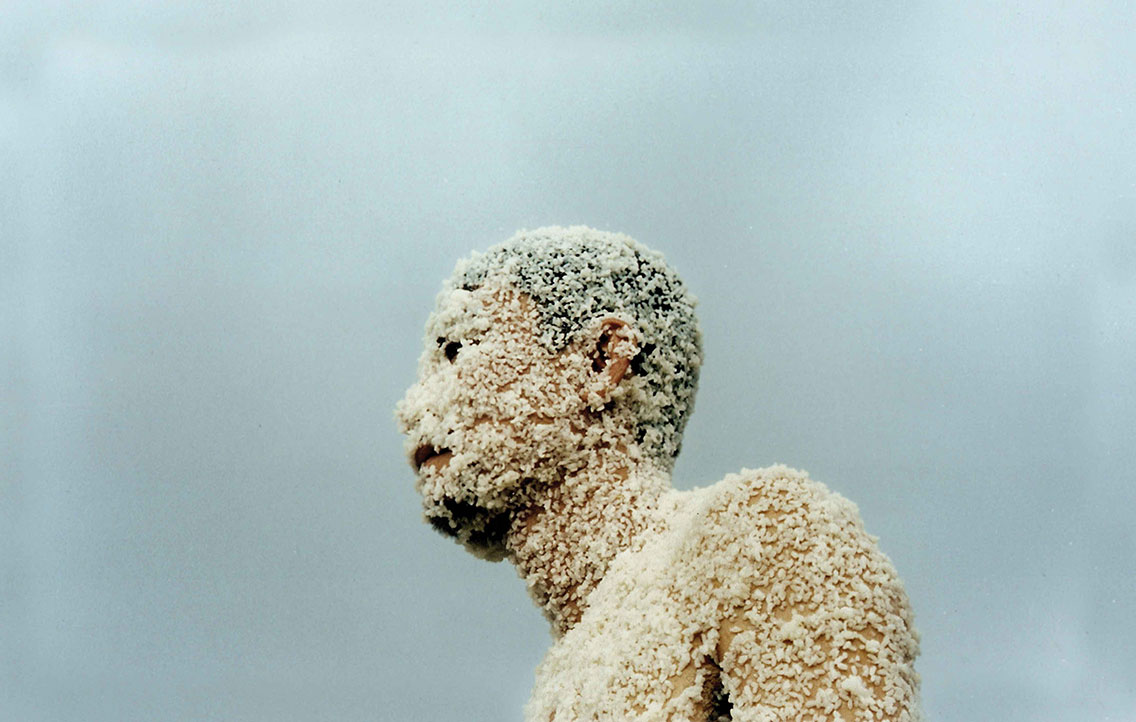
Steam Rice Man: Luong’s durational performance at Mao Khe Coal Mine Factory, 2001
So that moment, unfortunately but luckily, we were in town, because nothing had happened (no bombing) for a few months, and it was very peaceful. So whenever there is no bombing, people come back to the city. So I’m 12 years old, happy to stay in Ha Noi for a few months, and nothing happened. But suddenly, over 12 days and nights in December 1972, bombs flattened Bach Mai Hospital, killing many doctors and patients, bombs entered the French Embassy, killing the ambassador and his wife, and bombs flattened Kham Thien Street killing thousands of people, bombs destroyed the entire main building of Hanoi railway station, and many other places in Hanoi. That I’ll never forget.
They say 12-day carpet bombing. And you know what kind of bombing? Both sides used violence to negotiate for peace in Paris. They sit in Paris for many years; they say, please, submit an agreement between America, Russia, and two countries—North Vietnam and South Vietnam. They negotiated from around 1968 until around 1972, four years. Whenever the negotiations were stuck at the table, they started killing people. Communist troops fought with American troops and the southern government troops in border areas, they also terrorized with mines and raids right in the cities of south Vietnam. American bombs in north Vietnam killed normal people. And that’s a negotiation for peace. So I grew up from that.
Venka Purushothaman
The negotiating model hasn’t changed even today.
Tran Luong
Yeah, you see Kosovo, everything after that…
Milenko Prvački
You mentioned that you don’t exhibit here in Vietnam. I suppose this is the kind of decision artists make when they are impotent to change the system. You can be loud, but you’re not allowed to be loud, then you create another world, and you do something else. And I think these conditions also include weather and rivers.
I like this idea of the river, that’s why we went last year to Phnom Penh. I was born on the Danube River, and the Danube River connects most of Europe, from Schwarzwald in Germany to the Black Sea in Romania. Just like the Mekong. But they have wars over rivers.
Venka Purushothaman
How about your experience, Huy?
Milenko Prvački
You don’t have to talk about art as we want views from everyone.
Huy Nguyen: Weatherman
Huy Nguyen
You might find some art in my story!
I started to study the weather, climate change and disaster twenty years ago when I finished my PhD at Kyoto University in Japan. I started with a study of drought conditions in the Mekong region, especially in Laos, Cambodia, and Vietnam, between 2005 and 2006. Then, recently, I studied other countries like Bangladesh, Marshall Islands, and Indonesia. Most of the researches focus on how the local people adapt to extreme weather conditions. For example, in the areas of prolonged drought, meaning lack of water, I am interested in understanding how local people deal with it, using their traditional knowledge of prediction of weather and navigation over the ocean. It is interesting to see how knowledge changes from generation to generation. On the shores of the downstream Mekong Delta as well, understanding how the local people apply the weather forecast for their livelihood is important. Before they have smartphones; they can access weather information more easily. Before smartphones, people observed nature around them and had traditional knowledge transmitted through folk songs to predict the weather—like seeing the dragonfly…

Redemptorist Church in Hue city, Vietnam during the flood event on 15 October 2022.
Photo: Nguyen T.A. Phong
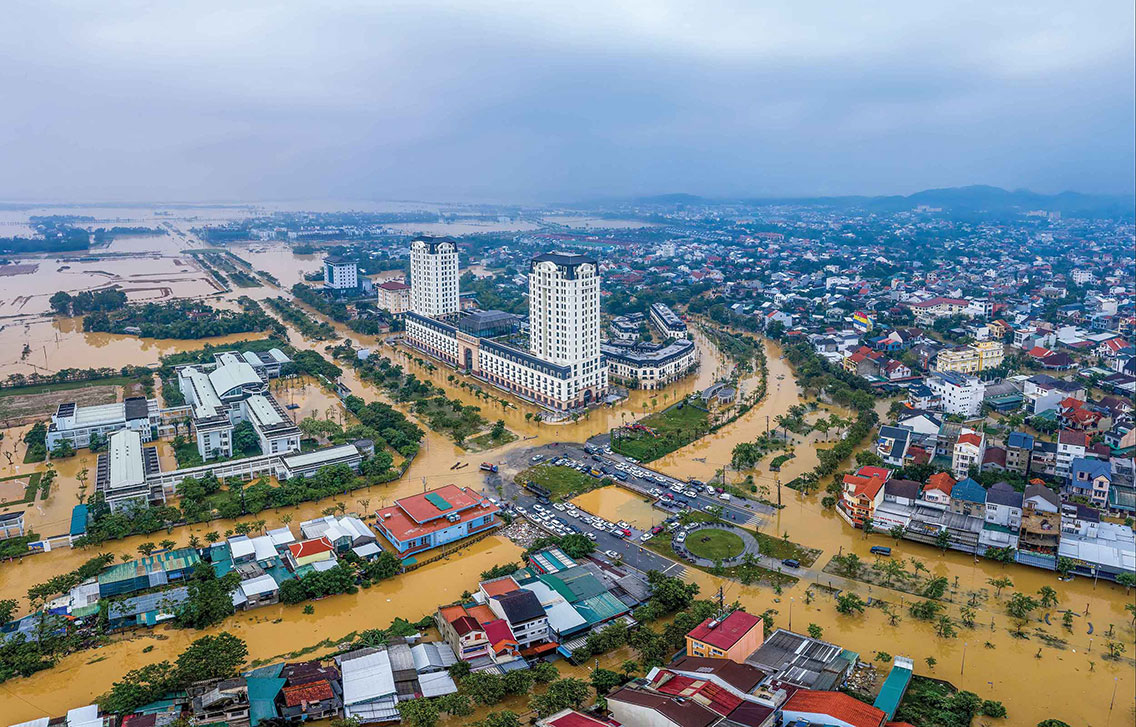
Manor area, a new developed area of Hue city during the flood event on 15 October 2022.
Photo: Nguyen T.A. Phong
Tran Luong
They fly at a very high level when it is sunny, low when it is rainy, and the middle level in normal conditions. In Vietnam, everyone, including myself, every morning, if we see a dragonfly, we will know the weather of the day.
But now urbanisation has destroyed everything and the young generations don’t know what it is.
Huy Nguyen
So those kinds of tradition, they put in the traditional song as well, and the poem. And it’s seeing the sun and the moon, and the prediction for the weather condition in the coming days. And so observe the plants and vegetables at the sea, and animals like ants, you know, as to observe the behaviour of ants, when groups of ants move up to higher floors, it means that there will be heavy rainfall coming soon. So, that kind of indigenous knowledge has been applied in many of the communities around the world.
So I was trying to see if it works in Vietnam, and can it in Bangladesh, Cambodia, Laos and Indonesia, as well. When I did my research inland of Vietnam and Indonesia, the people living there observed the mangrove leaves, and if the mangrove had young leaves growing up, it meant that there would be rain very soon, in the coming days. So, much of the traditional knowledge has been applied for a long time before, but it’s for the old people who can know and remember about it. But younger people do not do so, as they rely on technology, such as radio, and information from their cell phones. So traditional knowledge somehow had not been applied and transferred to the next generation.
Venka Purushothaman
What you say reminds me of the 2004 tsunami that hit Southeast Asia. Research shows that, particularly in Sri Lanka, many animals started to migrate inland weeks before the tsunami hit. People didn’t pick it up because we’ve become so urban that we have lost our sensing of the fact that we as humans are actually part of the environment, and urbanisation has actually disassociated us, our connection to the environment.
Milenko Prvački
Because it was normal local oral communication and kind of transition from grandfather to grandfather to father. And then because you have readymade information now, and nobody cares about nature. And this is a bit of a problem, because they can’t predict some things in advance, they can’t anticipate. Usually weather report is what is it about yesterday or today. But what we’re talking, it is about generations, and it’s about anticipation through nature.
Huy Nguyen
Similarly in Vietnam, I watch the weather forecast information on TV and it’s very funny. I open the forecast news, in 2000, in 1999 or in 1990. The weather forecast from the national centre, meteorological centre remains the same. It means there’s no change on the way of the weather forecast.
It’s very general information, like—tomorrow, some parts of the region will be rainy, some parts of the region will be windy, and visibility will be 10 kilometres. That alone shows that the local people are not really relying on the weather news from local television.
Because of this, I have my own weather forecast channel, and there are about half a million people who follow it.
Milenko Prvački
Half a million people, wow.
Tran Luong
He turned out to be a dangerous person, and the government started watching him because he has a half million followers. Ordinary people going to work can learn each day his show. And each day he says to people in an area to be careful: you clean up things; or go back to the seashore, because the weather will change soon. And people follow him. He is so famous now that the government wants to meet him.
Milenko Prvački
When I was young, I was listening to the weather report, but it was called a water report. So, the change in the Danube River in Germany will affect people who are travelling by ship or boat or fishing or whatever. And then there are sea reports and ocean reports because many people are going from the Mediterranean to the Philippines, you know. So they can listen to what is the situation of the water, what kind of weather, what level, how to navigate. They don’t do this form of specific reporting anymore.
Huy Nguyen
And another part of my research work recently, I was trying to see the correlation between the people in the Mekong Delta and their reasons for leaving their hometown to some other parts. Is there a correlation between people leaving their villages in search of jobs and the weather condition? Actually, there is a close correlation. For example, just after the historical drought in 2016, the number of farmers who left their farms increased the following year because they had no income in the fields and they had to move to Ho Chi Minh city and other places searching for jobs. Many people are permanent migrants. They’ve not gone back to their homeland.
But why not go back to their homeland? The problem is that if they go back, they don’t know what to do for their incomes because of the very hard conditions. The intrusion of salinity into the fields and the low productivity of agricultural products, the impact of the many dams upstream of the Mekong River just stopped water flow for fisheries to survive. The biodiversity in the lower Mekong delta has been impacted. Before, it was easy for people to live; it’s like they could catch fish, they could get some vegetables around the fields, to survive on their lunch and dinner, you know, for food.
But now, it is money or nothing. They have to pay. Before, nature provide food and water to people. Now people have to pay for water and food. That’s why many of these people migrate out of the Mekong and many are in debt with banks. Many take loans to start some agriculture or aquaculture project. And then it collapses, and then they are in debt, they move out.
These have some relation to weather conditions, particularly the prolonged drought, salinity intrusion, etc. They impact everyone, including our children. You know, in one family, one parent leaves for a job search in the city, so the children also lack parental support. And then some of them drop out of school, or the education is not good for them as there is no one taking care for them. That will impact the future generations.
Milenko Prvački
Domino effect.
Huy Nguyen
Yes, that’s right. That will be generation effected in the future.
Venka Purushothaman
Perhaps Mithu, we’ll come to you? We’ve heard some very interesting and strong perspectives.
Mithu Sen: Language and poetic Interludes
Mithu Sen
I hear such strong perspectives on weather and ecology, and you both are working so intensely with this idea or this, you know, situation. Whereas I’m an artist who is definitely not working on issues related to climate change and weather, though I can see that they are serious in today’s time.
I can see my work related to the human condition and affected by different kinds of politics and situations and balances. And so if I extend that idea of how this balance happens definitely, climate change is one of the issues. But that is again kind of connected with politics and the different kinds of demographic and economic and political conditions in different places. Not only particularly in my country but as a whole, how this whole general nature of human violence affects us over centuries.
I can give some examples from my work. Recently, I was working on a project with Khōj and World Weather Network, five artists were appointed to do something about the weather and the weather conditions in India and other places.
So I was given only one key phrase: 28th degree north parallel, which is actually one big line from one part of this country (India) in the west to the northeast. Interestingly, my studio is situated on this line. You know it’s in Delhi, and it starts from Rajasthan. I actually travelled to the northeast states, to Assam and Arunachal Pradesh border, following a river. Again, this river, the Brahmaputra, connects China, Tibet, India, and Bangladesh. My work is definitely not related to hardcore research and data, so I cannot put myself into that category. Rather my practice is based on human instincts and speculative intuition.
I perceive something as an issue like weather through metaphorical keywords like river and execute it as a speculative future. So that project I did with the river, it’s called I Bleed River4 and was dated 2124, so 100 years from now, how it becomes. So, I made a film, of course I was recording and shooting my journey for a week through the river.
But finally, I made one film, which is like out of four seconds of footage. It was after the high tide, you know, like during the low tide, in the back of the river, there’s left a little pothole full of water, because the tide is like the whole river has gone back to its place.
4 See cover for image.
Milenko Prvački
The remains.
Mithu Sen
Yeah, the remains of the water, and somehow I was so emotional. I felt trance-like, and I started seeing the future through this tiny pothole water body. I was in extreme fear that this was what was going to happen to the river a hundred years from now—a little remains.
So I cannot explain why, but definitely it was last year’s end, and when the Israel and Palestine war started, and the bombings were happening. So you know my whole thing is very imaginative, and when we fictionalise, I start seeing the rains, bombing like everywhere. So with the whole violence of war, including the Ukraine and Russia war, instead of working on weather-related things, I actually started researching the wars and the associated violence in the last maybe one year.
I made this imaginative video out of the four-second footage, where a river is burning - the edge of the river was on fire due to petrochemicals. There is a big projection of the river burning, and I kind of explained in four lines what violence is from Gaza to Kyiv. Because of war violence, our nature is becoming ashes; it’s ending.
Milenko Prvački
Just again, to connect the war and violence to the Vietnam experience.
Mithu Sen
Yes, yes, all countries.
Milenko Prvački
I remember, as a kid, looking at the destruction of Vietnam. It changed the environment because such an intense bombing changes the environment.
Mithu Sen
Lots of technical disruptions are happening, like deforestation and world pollution, forcing migrations that happen. This human-made systematic violence is affecting nature and our human life. It is traumatic. People are migrating and cannot reverse migrate, that is, return to their homes.
All these things make me think of the future and how I can also use my own freedom, leverage my practice, and execute something provocative so that people are provoked to think and act. I use this method in my practice by deliberately and intentionally creating some fear of what might happen.
Milenko Prvački
I think it’s important. In our previous dialogues, we could not separate politics from the lives of people in Southeast Asia.
Mithu Sen
Here, the politicians build dams and prevent the next countries from getting the water. You know, between India, Bangladesh and Pakistan we also have these issues, especially regarding the causes of drought, flood etc.
Everything is interlinked and interconnected, and the nature of violence is ever-present.
Milenko Prvački
You can’t ignore.
Mithu Sen
You cannot ignore. As an artist, this affects me a lot. And I really like to think about the kind of emotions as humans become traumatised and how their behavioural nature changes. So everything affects, you know? If I see somebody cutting down nature like trees and plants in the name of cleaning the city or something, I feel this is a kind of violence and inhumane. Which is repeated in the name of civilisation.
Venka Purushothaman
What sets the stage for you for these points of enquiry?
Mithu Sen
My mother is a poet and I was born in a very culturally aware intellectual family surrounded by music. Even being a Bengali family from Kolkata, we never lived in the city— rather moved to different places, mostly near the Himalayas because of my father’s work.
I went to study in Kala Bhavan in Santiniketan, Bengal. As you know, it is an open school. We used to get classes under the trees. You know, it rained, and it sounded very romantic. It’s only 25, 30 years ago, but it’s still very much the same today, as if it is part of nature. We did have classes in concrete buildings, but we hardly were there. We always used to bicycle, go around, and feel the weather on our skin. That was my upbringing, for seven years studying there.
Then I moved to the capital, New Delhi, which was a horrible experience because I had never been to such a big city. I started confronting different kinds of politics, including the social, political, and economic lingo—everything that was confronting. India, as a post-colonial country, has many hierarchies and hegemonies. I felt very less powerful, and my own identity crisis started very strongly.
It’s not very good right now in India as censorship is increasing. A lot of censoring in the last couple of years, especially the last 18 years, including my own practice. I never thought that my kind of art, from an artist who is directly not connected with strong politics is looked at. Even I can be under surveillance, my work can be censored. And this is happening, and this is experienced at different levels. It’s happening in a very subtle way, under the table like just. So, as an artist, what I constantly try to do is like as a trickster, I try to subvert and sabotage that kind of censorship and try to play and roleplay.
I was restless. Earlier, I was more like a poet because I wanted to be like my mother. I started writing at an early age and published my books in Bengali during my university days, so I had confidence that I understood things. But migrating to a different city for a job gave me a completely different idea of identity—rather, identity as a struggle. The contrast between Santiniketan (open and kind of equal) and Delhi (chaotic and unequal) was jarring.
My practice is also based on radical hospitality, which is about deconstructing regular role-play. My medium evolves to prevent the art market from getting to me to produce the same type of work. I resist that and keep changing my mediums every few months. This upsets the galleries. The art market tries to put artists in one kind of frame and try to glamourise and glorify one kind of style or identity, encouraging the artist to repeat the same thing. It’s a trap. As a feminist artist changing my approach constantly is my politics, where I intervene and disrupt the patriarchal shape of the market.
Milenko Prvački
As artists, we are all migrants in some form. Some people migrate physically, but most of the time, we migrate intellectually to find our own space. I find it’s quite common.
Radical instinct
Venka Purushothaman
I think it’s quite an interesting jumping-off point. One of the connecting ideas around all of you is how you find your space since all your actions have been very instinctual in many ways. It’s not theoretical, it’s not ideological, it’s instinctual. How do I respond to the conditions of my time? You know, just what you’re talking about, having your video channels and the weather, it’s instinctually building on histories that people have known, receive knowledge. And instinct is quiet; it’s often not used in the kind of creative space.
Tran Luong
Art today has become more classical and formalised.
Venka Purushothaman
That’s right, today, because today we live very much in a data-driven space. So the kind of instinct that drives us as humans is muted or it’s disappearing.
All of you talk about the fact that instinct also depends on how someone is going to look at it. Some would look at it as radical. Some would look at it as just ordinary. But through whose lens? If someone sees Huy’s work as 500,000 people watching, that means that’s radical. Alternatively, it could be simply, oh my god, 500,000 people are interested in me?
Or the fact that Tran, your works are only being shown outside of Vietnam and not here. Then how do you make that connection in spaces like these that we are sitting in? So some might see it as radical, and some might say it’s quite ordinary. Because the instinct ties back to some sort of radical practice. But radical not in the kind of the political sense, alright, but in terms of a practice.
How do you follow through with your instinct?
Mithu Sen
I do a lot of sabotage and subversion in the digital space. I kind of have a couple of Instagram accounts; one is for the conventional art market, very nicely done. Then, in parallel, I have another one, and then another two anonymous accounts that enable me to play and explore. I try to see who is following me, and I interview them when they like something that is not associated with Mithu Sen’s ‘popular’ aesthetics. I don’t hack, but change the information on my Wikipedia page. So I appoint students or interns who can do this. And it goes unnoticed. So you can also challenge that authentication, how much we can authenticate, I like to keep changing my data pathway. It is a kind of violation.
Milenko Prvački
Maybe subversion instead of violation?
Mithu Sen
No, what I’m saying is that, from others’ perspective, when I’m actually disrupting, I become a violator. Twenty years ago, I had a show called I Hate Pink where gender politics was addressed and colour was addressed as a violation, and today, in India, the saffron colour often violating us, as a political symbol.
From colour, I move quickly to perhaps violence in Manipur, where an ongoing violence is happening, and the government is almost invisible there; they are not doing anything. I extend the invisibility—a place that is constantly being ignored and violated by the government.
But I must say, I don’t understand politics. As a human being and as a citizen, I witness some unfair things happening every day. I have the right to talk about it and to say something. I feel traumatised by the violence around us. I return to my studio, I cannot draw a flower. We all are traumatised by some dominant powers. And that is making our behaviour change. And that behaviour change is very important, like how we are acting and reacting to these changes in our body and mind.
Tran Luong
I very much agree with Venka’s statement: “Because the instinct ties back to some sort of radical practice. But radical not in the kind of the political sense, all right, but in terms of a practice.” In the process of improvisation and perception of artists, instinct plays a role in keeping the axis of perception filled with personality and the local context without being eroded or distorted by the dominance of the social trend. The instinct to preserve the dare to speak up, dare to practice and dare to confront. When I was young, I felt I had an automatic mind that if I set out to do something, I would do it. But reality teaches me that it is a dream. I trained, I told you, at the academy, and I dreamed of being a big painter. Amid the war, I was quite successful.
We started a collective to create something more realistic and change the language of art. We were quite successful in the early years of Vietnam’s open door, from the mid-1980s to the mid-1990s. We started like an early group of artists who went out of the country, and very early, compared with other artists, we could go out. At that moment, we were controlled tightly, and it was not easy to get an invitation to a democratic country.
But after a while, when we had a free market, I suddenly found that it was quite dangerous. The free market came and changed our lives very quickly. For the first time in Vietnam, a painter had a more luxurious life than other artists, compared to film and theatre, which were still tightly controlled by communists. It was not easy for them to travel and to make something. But the painter was more independent, and it was easy to travel and decide our own future. And not much censorship, cannot follow us.
Around 1995, after extensive travelling, I suddenly found that, oh, the free market does not vitalise (it’s not a vitamin boost) but poison. Because artists were getting corrupted early because the market threw money at the artist, ordering them to paint what they wanted, “oh, this series fits well in the eyes of rich Japanese, please reproduce.” You paint for someone else and not for yourself. I’m proud that I say I’m the first artist in Vietnam to start the movement of rejecting the art markets’ proposition. In 1997, I quit painting to do conceptual performance. I found that the contemporary art form gives me more freedom to break away from censorship.
Also, I started thinking about what you can do to change the environment. As an otherwise self-taught learner and curator, I founded an alternative art space where people can talk freely without fear or self-censorship. I founded a studio in 1998; it can be said to be the first artist-run independent space. After that year, I founded the Hanoi Contemporary Art Centre.
So, my artworks express a very strong voice for politics and freedom even though my work itself deals with building environments for people. Since 2000, I have been working on bringing intellectuals and artists into the field of social development to help change the perspectives of people. I organised overnight field trips for artists to help them learn in real time instead of getting information from the newspaper. But they do not spend real-time learning.
Mithu Sen
We share a similar kind of struggle…
Tran Luong
There was an exhibition in Nanjing Museum, one month before COVID-19 involving a group of Southeast Asian artists. The artists tried to push the issue of the upstream dam construction in the Mekong, right in their centre.5
So I made a performance with a soda bottle filled with live fish in water, and the water flowed through my throat, emphasising—whether fish or human—that we need to survive together. We cannot separate. The fish can survive, and I can because I’m still breathing. So, the live performance really showed the real ecological problem in 20 minutes.
But it takes time to transform a conceptual piece of artwork into a direct message—not violent, not political teaching, but the rest of the fish is political. As you know, Vietnam and China are the ‘red’ fish covered by Maoism. I myself grew up in Maoism.
I made several performance works, very political work, thinking about how to turn it into a message. Since 2013, I have been performing with a hammer, everywhere from Paris to Tokyo. The sound of hammering, in many ways, recalls the return of the violent Russian and Chinese troops.
You know, the idea for a live hammering performance came from a very traditional moment. We have a long history of making gold and silver leaf sheets, which are used to decorate pagodas and the Buddha’s body in Buddhist rituals. Traditionally, people, the middle class, even
5 Tran Luong: “Because the organiser had printed the 9-dash line on the poster and banner of the exhibition, I objected to this incident. After that, the organisers removed the 9-dash line on onsite advertising media but still left it on the museum’s website and thus created quite a loud reaction from Vietnam and internationally. Two days after opening, the censors removed my works from the exhibition [I had three works: a 3-channel video projection, a video documentary, and a live performance]. Three other Vietnamese artists and I had to leave Nanjing immediately and fly back to Vietnam.”
the poor, can buy a bunch of goldleaf for the visiting pagoda. They stick the goldleaf to the Buddha’s body to receive energy from the Buddha. It’s a very strong, delicate, and amazingly peaceful ritual.
I was struck by the sound of Vietnamese people hammering. They hammer to make very delicate objects, to make peace. Then I suddenly found out that hammering can also kill. As I grew up, I discovered that hammering can also kill. Then, I created the work that I have made until now. I perform everywhere in the world, in almost 26 cities. It became a film montage, Coc Cach. This is how I adapt the artwork to my history and my life.
In 2007, I was arrested in front of the Mao portrait in Tiananmen Square, wearing a suit and hammering away. My work became significant, and somehow, my works became political just like that. The undercover police inside the Square came, and they stopped me. I tell them I did not dirty the ground; I’m an immigrant from far away. They thought I was Chinese, because it was 1 October (their national republic day), very big crowd. So I did it, and just 15 minutes later, the crowd was in front of me, and suddenly, someone, a big guy, undercover, held my hand, and he talked to me like a dog barking; I didn’t understand.
And I say I’m Vietnamese, I’m foreigner.
He just kept on, picked up the internal phone, and I realised he was police. A group of them, also undercover, came and made the audience go away by covering me.
I showed my other video work and said I cannot speak Chinese. They called someone to translate. They took my passport away bring to the police. I stayed three hours in Tiananmen Square, waiting until the vice-general of police of Beijing Station arrived. He was a senior, and his car could come inside the Square. He talked to me directly, “You Vietnamese?” He knows Vietnam and China [in] very strong conflict, I said yes. “Are you gonna perform more? I say no.” He said, “If you keep performing, I use the rule.” I reply, “Passport?” And he says “Don’t be silly, don’t do anything.” Luckily, someone filmed it from far away and the work in some way shows the 2007 relationship between Vietnam and China.
Huy Nguyen
So that is not so strict like North Korea. First of all, if you were in the NK, you would not be here.
Venka Purushothaman
I’m just interested in your own space, Huy, as to how you negotiate that tension. You are trained in Kyoto, and the Japanese lens of looking at tensions is different. How do they then deal with kind of negotiated space? Has it helped you sharpen your own space, right? Because your Vietnamese experience is quite distinctive from the way the Japanese mind trains you to think. I am aware that the Japanese are well-trained in disaster management, and each community responds quite distinctively to environmental challenges.
Huy Nguyen
Actually, it is in the education system and also in the family training system, which is passed on from generation to generation.
When I was the student in Japan, I thought site training (or learning about a space) from the beginning was important to everyone, whether you were working or just visiting Japan. These kinds of training provide you knowledge on how to cope with nature and manmade disasters. Because Japan is a country that experiences many kinds of disasters, the most hazardous quite frequently are earthquakes and tsunamis. That’s why the children are trained in elementary school about safe spaces to avoid the risks and how to respond to earthquakes and tsunamis. My two children, born in Japan, were trained in elementary school. Another system is training in the community; the Japanese train each other. They document the historical information of the disaster in their own communities and put it on the wall, put it in the notice on the wall. For example, every year, the level of the water since a tsunami is marked to remind newcomers to the next generation that the place has experienced a disaster. They apply technology for weather prediction and every citizen use it. They also have to comply with a law that when an earthquake, tsunami or typhoon happens, every telpatrichalevision must turn on live broadcasts for the reporting of the condition of the disaster.
If you make a comparison with Vietnam, it’s totally different. I still remember in 2020, there were prolonged flood conditions in central Vietnam. It was prolonged for 20 days and is not always in the same condition; it always changes. For example, in the beginning, there was a flood in Huế, the next day in the next province in Quảng Trị, and another day in Quang Binh province. But there is less of forecast news on television, less of warning notices to people.
Then, I started providing detailed information to people in the area about a very big flood coming into that area because I had data, both international and local. From that time, many people started to follow me because of the lack of information from national television. I posted on Facebook a story of what happens when a disaster happens in Japan, what television does. After that, many television stations in Vietnam changed their policy to talk live about disaster. They tried to invite experts from the meteorological centre to talk about the typhoon. I laughed. Okay, at least I have made some changes.
Tran Luong
They now make the reporter go to the site, which they never did before.
Milenko Prvački
It’s a very specific controlled environment, politically controlled environment. And they will justify like, oh we don’t want to disturb people, you know. But usually, it’s tragic because they are not informed. It’s not a Vietnamese syndrome, many countries have this problem.
Huy Nguyen
It puts up the space for political change.
Venka Purushothaman
But I think it also comes back to the idea of providing everyone early warning, and it comes back to my earlier point about instinct. We are always responding to some sort of an early warning because that’s something that artists have learnt in some ways. Because of your own personal transformation through your practice and situated experience in various environments, you have an intuition something might happen. There’s an early warning radar within you.
Tran Luong
The intuition about the possibility of early warning is real. But it also depends on the conditions and luck. That’s why I look for opportunities to organise hands-on projects and field trips for artists. I recall the artist field trip I organised in 2006 to see and experience inland Vietnam and its changes and challenges. Artists were to create work that responded to the experience. If they follow information that exists, it is propaganda, and their artwork is wrong. So they must find out for themselves. Since then, I have seen many artists’ work—not just only the voice and the message—becoming more independent and more real. I believe we build good contemporary artists. I’m very proud and very successful with that.
So this year and last year, in Project of Song Foundation in collaboration with the APD Centre, I sent nine young artists/activists on a field trip; some of them went to a mangrove tree forest in Vinh Chau town, Soc Trang province and some went to a dry forest in Ninh Thuan province, south central region of Vietnam. And I brought three of them to Village 3, Tra Linh commune, Bac Tra My district, and Lang Loan village, Tra Cang commune, Nam Tra My district, Quang Nam province, a central region of Vietnam , where we have a finished project. For two weeks, we organised a conference about our social development project. In five years, we would have built two villages, replacing where they have a problem with the mountain landslide. The villages will as they have better climate conditions, electricity, etc, and people return back to work and live. Now, I have a specific programme for rebuilding a traditional community house, which disappeared during the Vietnam War.
Venka Purushothaman
What you describe is a particular feature in Southeast Asia, where that kind of collectivism starts happening in the artists’ community first with a careful study of materials.
Tran Luong
Yes, nowadays, there is more material and more realistic art, and it is a massive turn in art. But it may promote the wrong future: working as a social developer in general without understanding the people and their communities.
Mithu Sen
Like when you specifically mention how instinctively artists assume or predict the future, and in terms of his or her work, how they take a position to change that own practice.
Around 2007, I was starting my own career and I was suddenly very popular in the art market, the West mostly. It’s always the exotic we are selling outside. And that is a trap.
I remember when I was in New York in 2006, there were a lot of works and solo shows happening, and within six months, my own artwork was prized five to six times more. I was very upset, and you know, I asked my gallery what the reason was. And they tried to say I’m very talented, and I should do my work, and they take care of the market. Of course, suddenly, in one year, you can buy a house.
I was in extreme fear and nervous. I said no, and I had to deal with the market in some way. So I launched a website called FreeMithu (https://freemithu.mithusen.com/), putting up 20 works at $1000 each every year. I started giving people free artworks, with conditions such as engaging the community all over the world. It’s free or it’s gifted a gift, you know what’s the politics inside the gift. It’s very interesting. So the whole idea of gift giving, because nothing is free, you know. And to also encounter the market. So if I make 40 works, so 40,000 dollars I earn in a year, but in case 10 works are going without the market, this 40,000 is becoming 30,000. So that was my very romantic way of nurturing or manipulating the market and subverting it.
I’m still doing this—it’s been 16 years now. It was one thing to create a community that wants to really engage in art without going through the market.
Last seven or eight years, I have been doing another project to address censorship. I started creating a legal paper for the government for my artwork, stating that I was declaring why I was making this work. So contractually, I declared all my object-based, material-based artworks as by-products. So this is like started in 2017. Right now I’m working on declaration number 26. So, all my works are by-products, and the rest of the process is my work, which is never executed in one form that the market can handle.
I also use a lot of different mediums like QR codes as my artwork, so that people scan and get to the back-end of each QR code. So, even if they own the QR code, the art owner, does not own the fixed back-end—which is rather unpredictably and randomly changing.
In 2007-08, I did a work on homosexuality called Black Candy (Iforgotmypenisathome). It was highly appreciated at that time, but later, with the change of government and censorship rules in 2019, two of the works from that season I wanted to share were not allowed as the government did not want to hurt sentiments because it had violence and nudity.
I took it as a kind of provocation; I blackened my work, which was originally mostly white, now overdrawn with beautiful, non-controversial images. When I displayed that work, I put a very small before and after photograph of the work (which people almost overlooked) as a declaration asking what kind of inappropriateness in that work made me be self-censored.
Challenging the market, the whole capitalist form of marketing, to deconstruct and kind of breaking is a form of ‘Un’. Un world, so Un-ing that kind of construct, that mythical construct that is in everything. Then, we create an alternative way of sabotaging and then reaching. So as an artist that way, that instinctual kind of function in our system happens, and then immediately we take that call.
Recently, in Dubai, they stopped (censored) me because I screamed “ceasefire!” I was performing a work speaking in a non-language about peace and healing. They said I could not do anything controversial. Even in the Middle East, in a place like Dubai, I cannot be pro-Palestine.
So, I always try to play different roles as an artist around the globe: in my country or outside. This gives space for some kind of experimentation and radicalism. If I am drawing strong erotica and sexualised images, I am deemed a “brave, feminist artist in town.” But they don’t want to see that feminist act where I’m also trying to subvert the market economy by freemithu project or artist declarations. They don’t want to see my feminism there. This kind of patriarchal format that makes artists or defines the identity of an artist is very interesting.t So it’s like my identity in India will be one kind, and in America, it is another type, and in Japan, it is another type. So it’s very interesting to confront different cultures and see how I am looked. For there is one kind of format for ‘Global South’ women artists—expected and projected. A particular range of issue-based practices by women artists are mostly celebrated and controlled by the invisible mainstream West.

FreeMithu 2007-
Freemithu is an ongoing web-based interactive project that started in early 2007
https://freemithu.mithusen.com/

Apolitically Black
2007–2019
mixed media on paper
diptych
152.4 x 121.9 cm each
Courtesy of artist
Venka Purushothaman
I find it interesting that what we call the marketplace today is quite distinctive in the sense that the options are there for the artist to choose different kinds of personas that they might want to take and play with and change with. And that’s something that’s very unique, and the marketplace also has its own control measures on how you function, because we can talk about political systems, but then there’s a marketplace, which is the free market economy, where your works travel to.
Tran Luong
No secret between the politician and the market runner! We have to know how to deal with it.
Venka Purushothaman
The marketplace has always been called the free market economy, which is outside of politics and government control. But governments have also discovered that the marketplace has become a very effective instrument of governmentality. Art marketplaces promote cultural signifiers of countries.
But I think an important part of the theme that’s emerging is how, through your own practice, you build resilient communities both for artists and the community at large. As for artists, whether you’re helping communities realise the weather patterns that affect their lives or enabling artists to understand the weather patterns of the art market is key to operating outside received systems of patriarchal, colonial and historical traps.
Tran Luong
I am concerned about how to see the potential way of working, understanding, and reading in the current world - to be sensitive enough, understand and respond to the ‘weather’ of the market controlled by the forces of self-interest behind it. The artist community and people in general need to reactivate the biological recognition system, which is the senses that have been blunted in the context of rapid and negative changes in the natural and social environment. One of the problems I see is that when we interpret things, our idea is to understand. However, we put too much weight on seeing and hearing to determine our understanding. We are not using our senses of smell, touch, and taste (our tongues are losing). Past ten years, I have been looking at how we maintain our senses or mystic sense or are we losing more than 100 senses?
In my mentoring classes, I try to raise awareness between artists and poor people in the villages at a human level so that we are not desensitised to the environment because of technology. We are not sensitive to tasting fruits anymore. We let our skin not be sensitive to the weather, not because of the temperature but humidity. It says a lot about our senses.
Huy Nguyen
Talking about the sense, just a brief story to share. When I worked in Japan, we had one group studying mythological (traditional) ways as to what we do, how we change ourselves, and change to each other.
Once per month, at least one day per month, we go to the beach of Kobe. Then, we have three ways of measuring the temperature and wind. One is to use the traditional, it’s not the very old tools, for example, temperature measure. That’s the first tool. Another tool is use the electricity sensor. The third one is a human sensor, that you can stand outside for five minutes and then record the temperature into a notice, and then make some comparison with the sense from the skin and from the old tools and also the modern tool. In this way, you observe and cast a sense around their surroundings. It is a good way to connect people to the environment and nature.
The Japanese system does train our body to acclimatise to change through rituals, as the human body has a sense of adapting to the weather and connecting with nature on its own through layers of material. It builds resilience.
Resilient Communities
Venka Purushothaman
The idea of resilient communities seems to be present in all your comments. How do we imagine those communities supporting each other and learning from each other? What does that mean to you, right? I’m just kind of interested in hearing your perspective on the role of translation and translatability in communities. I think translation is a big part of some of the things that you do—such as social development, public education and dismantling the power of language system—continuously problematising issues and spaces.
Huy Nguyen
In extreme events in Vietnam, community-based disasters help build social capital amongst the people and people in the same places. In the past, we have a very strong culture of helping each other. For example, during flood relief efforts, neighbours help each other by sharing safe spaces such as the second floor of their house. The mood to help build social capital. We can be proud to say that the social capital among the commune is that the villagers are very strong in Vietnam. However, today, people tend to be closed up because of safety.
Venka Purushothaman
Why do you think that’s happened?
Huy Nguyen
Before, people did not have good things inside their houses. Now, they have televisions, computers, and cell phones. They have something they want to protect. Trust is limited. This weakens the connection with neighbours. This is visible as the speed of development forces people to stay closed in, not open to others. This affects the resilience of communities. And that’s my observation.
Milenko Prvački
Could be. I have experienced living in Romania. It’s not about protecting what you have, but people don’t trust you because you don’t know who’s spying or who’s in control.
Mithu Sen
This is real. This thing about door/window grills, is it for the neighbours, or is it just for me? I can trust my neighbour, but I may not know who is passing by. So, it’s not like my neighbour; maybe I still trust them, but I still put the grills to protect myself from some other circumstances or some animals come, like the cows or the dogs, stray dogs. So, it can also be like that, but it is also like distrusting your neighbour.
Tran Luong
There is also another problem because of migration. People move, and with new people next to you, trust is less.
Mithu Sen
But I think because if we talk about community and trust, we may have to think beyond the physical location because your community may not always be one in your immediate surroundings. We develop our own communities based on trust, and they could be in different parts of the world or virtual.
A kind of trust emerged within a community, believing just in art.
As I mentioned earlier, moving from Kolkata to New Delhi and then to Glasgow—the anglophonic colonial atmosphere and its hierarchy and elitism made me numb from continuing to write Bengali poetry. I stopped writing for about 10 years. I went into silence. I wanted to understand true empathetic human communication—like how people communicate when you feel humiliated, and how we can overcome that too, you know, develop that compassion and empathy between us to create a community. During the 10 years of my complete silence from Bengali poetry I was practising my visual art, experimenting in this space language, its construct and myth. India has many languages, and dominant languages suppress many, many native languages. Similarly, around the world dominant/coloniser’s languages killed/suppressed others. I have experienced travelling around the world facing unknown languages and cultures. As an artist, as an experimental material self, I find myself throwing myself into vulnerable situations where I don’t understand Portuguese, Japanese or Chinese but discovered a mode of communication.
My confidence was building with something that was there, where I could still communicate and survive. With that kind of belief, I started performing, I call it ‘perform’, but I think it’s like my life, I do the gibberish non-language performance, to deconstruct all kinds of languages. Not to build another language. That is how I think, on a very conceptual level, here, the ‘weathering’ comes in. How you weather yourself, you know, how with your body, with your language, with your religion, everything. However, that also brings a lot of victimhood and polarisation.
Milenko Prvački
Polarisation is killing. But technological devices are helping. Japanese and Chinese almost don’t speak English. Last year, I was shocked at how they communicate. They have these devices to communicate with everyone.
Mithu Sen
The advancement of science and technology has made a space for different kinds of communities all over the world. But there is also instinct.
Venka Purushothaman
Community is built around language and trust. And just listening to what is being said, I think one of the key things is today we have a trust deficit, you know we don’t trust systems, governments, neighbours—we don’t trust ourselves for we may be vulnerable. So, I’m wondering if, more than trust, we should focus on reliability. Can I rely on someone to help me? It might not be my neighbour, but my global artist community, which might be a reliable community. Whether I trust them or not could be a different thing, but I could rely on them to help me if something is difficult.
Mithu Sen
Yes, it is possible.
Venka Purushothaman
Reliability does bring us back to some sort of social or associated engagement with various people. Relying on someone will allow us to transcend the translation and language issues and find a common purpose. In sociological terms, this is called associational relationships. We always build relationships associated with a purpose outside of the formal kinship systems.
Tran Luong
When I jump out of my ivory tower as an artist, I realise that you have to read different people and situations and understand the disconnect between my life in an artist community. When you live in your own artistic community, everything is quite easy and tolerated. You even fight with each other. That’s why I try and mentor artists to work in different spaces. It’s a kind of self-learning and getting more experienced by understanding others.
In working with communities in social development projects, first, we have to work to create trust. Secondly, co-design the way we make trust. If we do not ask them, give them a voice, or give them ideas, there will be no trust. I work closely with the village/province leaders and let their elders choose the land on which we will design and build. After many challenges, culturally specific concerns and government regulations, the people love the village we built for them, and other villagers come to stay here.
Milenko Prvački
Villages in Serbia are similar. When someone is not speaking at their level, they consider you a philosopher, which has a negative connotation. They hate intellectuals and only engage with people who can do something, convince and speak their language.
Tran Luong
Yeah, actually, they really hate us if we do not really like them.
Mithu Sen
Experience the real side of real people! It’s great that you already developed your organisation.
Tran Luong
Self-taught!
Mithu Sen
Your personal initiative in building this organisation and developing this kind of project is great.
Venka Purushothaman
One of the unifying themes that’s emerging for me is, how do we then, in looking into the future, look at artist education in different ways, just like the way you bring artists to work with the communities.
Tran Luong
Yes, education should change.
Venka Purushothaman
Right, it’s changing quite dramatically because artists’ education is also no longer about that isolation sitting in that studio, but by being located in those very communities—doing, making and living with their communities. So, it’s organic, with no separation between the environmentalist, the farmer, the artist. They are all building themselves into the way they actually think, do and want to live.
Mithu Sen
Contemporary art should be rethought completely beyond the object-based experience; it should be organic, and artists should not think so much about the longevity of their art and its archival material.
Tran Luong
Sorry for interrupting you, but if we look beyond, everything needs to change altogether. We have to change the rules. Museum structures are already backwards today. Art universities are no more fun. There should be less permanent faculty and more invited artists to teach. The class should be outside, not in the auditorium anymore.
Mithu Sen
Yes, you know, in Shantiniketan, where I studied, it was just like that.
It cannot happen overnight but organically. The speed of digital technology works for the young generation. A four-year-old can operate and show you everything. It is key to think about how our body and mind develop. Today, we seem to be occupied with art with a temporary, short-lived memory. The perception of perfection is changing.
Milenko Prvački
For 50 years, I did not care, but now, in my 70s, I am archiving because nothing exists in memory because of the speed of technology. I must say that all art is conditioned by technology. First, humans discovered they could paint caves with terracotta; it was an invention. It only took 20,000 years. After that, 300 years ago they found the fresco wall. And then oil, then photography...
Tran Luong
It’s very much based on scientific discovery of materials.
Milenko Prvački
Technology conditions a lot of things, especially art.
Mithu Sen
Are we only thinking about ourselves, protecting our past and archiving our history?... I’m just thinking radically.
Milenko Prvački
I know you are talking about choosing, choosing methods that are valid.
Huy Nguyen
Can I say something? We talked a lot about community engagement. When I worked in Japan, I had a small room for living on a floor with more than 10 rooms. No one knew each other. Every morning, we say Konnichiwa (hello) to people. And then when we meet each other nightly, we just say Konbanwa (good evening), no further communication. And that’s all we say to each other, even though we live under the same roof. Not because of language but because of culture. The Japanese have a kind of value—the best gift that you can give to someone is to not disturb them.
I have a friend, two friends actually, twin activists who do art: Le brothers, I don’t know if you know of them [question to Tran Luong]. When I visit one of them in Hue city, he is doing some performance painting. I ask, “What are you doing?” and he says, “I’m doing a performance.” Performance for him means he invites his neighbour to join him. For the project named In the Forest I saw him put oil over a wall and doors and invite some people to drop more oil.
And then I asked, “What are you doing?” He answers me, “I’m asking the tree how old it is, and I invite people also to ask the tree.” But actually, it’s not the tree, the door is made from wood, and that is the way he communicates with the neighbour, with a friend. Everyone can join the art activity. Art is not expensive, art is not that difficult to understand. Art is, you know, familiar and open—so I think.
Milenko Prvački
And that’s why public art, or community art, are good, because they are open. You don’t need money to see public art.
Huy Nguyen
No tickets, no access rights issues.
Weather Forecast
Venka Purushothaman
I want to get everyone’s weather forecast. What’s your forecast for the future?
Tran Luong
To fit into a world that is quickly changing, we as artists should not be quick at change, but we should keep our own speed. If we keep it slow enough, we can see things differently, and we can see things clearly than we stay on the train. Because if we stay on the same train, you know the vision of the landscape all the same.
But the solution, I think, and I practice this, is being site-specific. As things change, we as a society are destroying the environment. We should change our social structure. I really like that we talk about climate change, changing the environment—culture helps to change. So, being site-specific is important.
And how can it be site-specific? The modern is already growing, and artists today should take on the role of social developers. Artists need more knowledge, more practical works, more engagement and more crossing of continental borders. But if you look back to history, artists travel a lot rather than staying in the bamboo jungle. Cross-continental travel is a better thing to do, and I think many will travel in search of a better model of art practice. That is my forecast.
Mithu Sen
In my own way, which will be poetic and political, creating a speculative fictional kind of imaginative space is needed. I believe that something poetic will always be understood in the future. If I can create something through the medium of poetry—not in the sense of language or taste—but indulge in poetic freedom, speculating something like whether it’s a river or a forest or a human being having like a horn in their forehead will be very imaginative. A very strong experimental radical speculation that can create a kind of sense of fear, and also a sense of awareness, that as an artist, I can bring to that imaginative space.
Huy Nguyen
The weather changes hourly, hour by hour, and lifestyle as well. Movement is always about change. The central question is whether we adapt to the change or keep to our original values. So important in our work, I think, to try and keep values traditional, but still adapt to the movement, to the transition. Lifestyles are changing, technology will always develop, and we cannot even imagine what it will be. But some core values will still be there. We should try to adapt to protect our core values.
Milenko Prvački
I think that we need solidarity, altogether. It’s still weather, you are a scientist, you are a community-based activist, you are a poet, I’m…old. You know, but what I want to say is we need to unify in this. It shouldn’t be a political agenda to save this planet.
Venka Purushothaman
We all can contribute in our own way. I can’t do what he does, and he can’t do what I do, but we can build together. That’s all.
That is a wonderful closing because I think all of you really summarised some significant work. I totally agree that to move forward, the weather of our era has to be built on solidarity, core values, being poetic and changing at our pace.
We need each other’s help and to learn from each other. But to take it further, even in solidarity, we need a renewed commitment to our core values and our purpose. It’s not about saying what the right value is or not, but how we want to define our values at that moment.
And those values have to be underpinned by what is our emerging politics or philosophy that’s coming through. So, you talked about the new philosophy that is going to shape this generation because we are all in a moment where everyone is disagreeing with everything that happened in the 20th century. We are all in that moment of flux or turbulent weather, correct? I think that philosophy has to be wayfinding space for self-expression—finding meaning through different forms.
A lot of the answers are also not so much about the big picture as opposed to what we do onsite, in a site-specific location. So situatedness, and I think this is where it’s going to become very critical, because we need to be situated and, from that situation, see the world. But the point of it is, being situated, we can develop a point of view. through my community. And I think that’s what kind of beautifully came through these two days of conversations—I’ve learnt a lot, listening.

Mithu, Huy, Milenko, Venka and Tran at dialogue at APD Center. Photo: Sureni Salgadoe
Courtesy of LASALLE College of the Arts
Contributors’ Bios
Contributors’ Bios
Zuleikha Chaudhari (Mumbai/ New Delhi, India) is an interdisciplinary artist, theatre director and lighting designer based in Delhi. Her work takes the form of performances and installations and her ongoing research considers the structures and codes of performance as well the function and processes of the actor as reality and truth production.Since 2014 she has been exploring the framework of law as performance, the role of performance in law and the performativity of legal truth-production. Chaudhari’s work has been shown at numerous international festivals and exhibitions, such as the International Theatre Festival Kerala (2019); Berlin Biennale for Contemporary Art (2018); Kochi-Muziris Biennale (2016, 2017); Wiener Festwochen (2012); the Dhaka Art Summit (2018); and Seoul Performing Arts Festival (2007), among others. She is currently the director of the Alkazi Theatre Archives at The Alkazi Foundation for the Arts, New Delhi, is a 2019 Further Fellow of the Berlin Kuenstler Program (DAAD) and is a member of the Khōj International Artists’ Association.
Franziska Furter (Zurich/ Basel, Switzerland) studied sculpture in Basel, moved to London and later to Berlin before returning to Basel. Furter has been awarded residencies in Tokyo, London, Berlin, Paris, Cairo, Andratx and Edinburgh and has received several grants and prizes. She has published a Cahiers d’Artistes (2009) with Pro Helvetia and a monograph with texts by Karine Tissot, Nico Anklam and Fredrik Sjöberg. She has worked with Galerie Friedrich (Basel), Schleicher/Lange (Paris/Berlin), doggerfisher (Edinburgh) and is now represented by Lullin + Ferrari (Zurich). Her work can be found in numerous private and public collections such as MoMA, NY; Contemporary Art Society, Edinburgh; Kunstmuseum, Basel; Kupferstichkabinett, Berlin. She has had solo exhibitions at Bündner Kunstmuseum in Chur; Centre d’Art Contemporain Yverdon-Les-Baines in Yverdon and Birgit Lauda Art Foundation, Vienna. Her work has been shown at the NGV Triennial in Melbourne, Kunstmuseum Basel, Haus Konstruktiv in Zurich and the Nakanojo Biennale.
James Geurts (Victoria/ Melbourne, Australia) completed a Masters of Arts in RMIT, 2009 and Post Graduate research at the GEMAK Institute, The Hague, 2011. Geurts’ conceptually driven site-responsive practice focuses on the way that cultural and natural forces intersect to shape both landscape and perception. Through critical investigations he draws out unique aspects and contexts of each site. Recent projects explore the diversion of a river’s agency, superposition and paradigms of measurement, fusing the primordial with the technological and investigating concepts of time. His commissions, public artworks and awards include: Floodplain, National Gallery of Victoria (2018); Latent Channel, ACME London - Creative Australia (2022); EON Project, GAGPROJECTS (2022); Flow Equation,\TarraWarra Biennial (2021); Archaeology of Time, Creative Victoria Public Sculpture Fund (2016) and presentations with institutions such as the Kuandu Museum of Fine Arts, Taiwan (2017); White Cube London (2013); GEMAK Institute, The Hague (2011); La Chambre Blanche, Quebec (2009) and the Sovereign Asian Art Prize, Hong Kong (2022). In 2016, Geurts was a recipient of the Georges Mora Fellowship.
Peter Hill, PhD, (Glasgow, UK/ Melbourne, Australia) is an artist, writer and independent curator. He is an Honorary Enterprise Professor at the VCA, University of Melbourne and a Visiting Professor at CalArts (USA). As an artist, for over forty years he has been creating what he calls “Superfictions”—a cross between installation art and literary fiction. He has exhibited these Superfictions around the world, including at The Museum of Modern Art, Oxford (UK), The Biennale of Sydney (MCA), and Auckland Art Gallery (New Zealand). He has delivered Superfiction Performance Lectures in Berlin, Glasgow, MASS MoCA (USA), Shanghai, Hong Kong, Tasmania, The Sorbonne (Paris) and the Royal College of Art (London). As an art writer, he has contributed to numerous journals, art magazines and newspapers. His book Stargazing, Memoirs of a Young Lighthouse Keeper (Canongate/Penguin Random House, 2003) won Scotland’s 2004 Saltire Award.
Huy Nguyen, PhD, (Hanoi, Vietnam) is a senior advisor to Oxfam International on climate change. He obtained his PhD from Kyoto University Japan with a major in global environmental studies in 2010. His research and 20 years of working experience have been focused on disaster risk reduction, climate change adaptation, nature based solutions, water resource management, and education in emergencies in various countries including Vietnam, Indonesia, Pakistan, Japan, Laos, Bangladesh, Marshall Islands, Philippines, and Cambodia. He has written and published extensively on these topics. Huy has worked for ISET-International (Institute for Social and Environmental Transition - International) as a senior specialist in urban resilience from 2012-2016, as a postdoctoral fellow at Kyoto University (2010-2012) and a lecturer at Hue University (2002-2006), as well as working for development agencies such as UNISDR (United Nation – International Strategy for Disaster Risk Reduction), IFAD (International Fund for Agricultural Development) and UNESCO (United Nations Educational, Scientific and Cultural Organization).
Katie Paterson (Scotland) collaborates with scientists and researchers across the world and her projects consider our place on Earth in the context of geological time and change. The IHME Helsinki 2021 commission was born out of the artist’s fundamental drive to create artwork that heightens awareness of the sixth extinction. Her artworks make use of sophisticated technologies and specialist expertise to stage intimate, poetic and philosophical engagements between people and their natural environment. Paterson has exhibited internationally; her works have been included in major exhibitions including Turner Contemporary, Hayward Gallery, Tate Britain, Kunsthalle Wien, MCA Sydney, Guggenheim Museum, and The Scottish National Gallery of Modern Art. She was winner of the Visual Arts category of the South Bank Awards and is an Honorary Fellow of Edinburgh University.
Janine Randerson (Tāmaki Makaurau Auckland, New Zealand) is an associate professor in the School of Art & Design, Auckland University of Technology. She is an artist and writer whose moving image and performance works are exhibited in the Asia–Moana region and internationally. She often collaborates with artists, performers, community groups, mana whenua and environmental scientists- from urban meteorologists to glaciologists. Janine’s book Weather as Medium: Toward a meteorological art (MIT Press, 2018) focuses on modern and contemporary art and performance works that engage with our present and future weathers. She is currently curating the programme Huarere: Weather Eye, Weather Ear for Te Tuhi (Auckland, 2022-ongoing) as part of the World Weather Network platform for contemporary art. Randerson is also a LASER (Leonardo Art Science Evening Rendezvous) talk chair.
Dieter Roelstraete (Kortrijk, Belgium/Chicago, USA) is Curator for the Neubauer Collegium for Culture and Society at the University of Chicago, where he also teaches. He previously worked as a curator for documenta 14 in Kassel and Athens in 2017. Prior to that, he served as the Manilow Senior Curator at the Museum of Contemporary Art Chicago (2012-2015), where he organised and co-organised highly regarded exhibitions such as The Way of the Shovel: Art as Archaeology (2015); The Freedom Principle: Experiments in Art and Music 1965 to Now (2015); and Kerry James Marshall: Mastry (2016). From 2003 to 2011 Roelstraete was a curator at the Museum van Hedendaagse Kunst Antwerpen in his native Belgium. Recent freelance projects include exhibitions at the Schinkel Pavilion in Berlin, the Fondazione Prada in Milan and Venice, the George Economou Collection in Greece, and SMAK in Ghent. He has published extensively on contemporary art and related philosophical issues in numerous catalogues and journals.
Mithu Sen (West Bengal/ New Delhi, India) performs conceptual and interactive multi-format mediums to subvert hierarchical codes and rules, and their intersection with the structures (social, political, economic, or emotional) of our world. Braiding grotesque fiction, personal ephemera, and piercing humour to obscure societal codes, the by-products of her practice take the forms of drawings, poems, performances, videos, glitches, and instructional interventions. Sen has exhibited and performed in major international forums including the Sharjah Biennale 15, UAE (2023); 9th Asia Pacific Triennial of Contemporary Art, Brisbane (2018); Kiran Nadar Museum of Art, New Delhi (2017); Guggenheim Museum, New York (2016); Kochi-Muziris Biennale (2014); Dhaka Art Summit (2014); Bozar Museum, Brussels (2013); Tate Modern Project Space, London (2013); Zacheta Museum, Warsaw (2011); and the National Museum of Modern Art, Tokyo (2008). She was awarded the Skoda Prize in 2010, the Prudential Eye Award for Contemporary Asian Art – Drawing in 2015 and Performance Artist of the Year by India Today in 2020, and recently had a major survey of her last two decades of work at ACCA, Australian Centre for Contemporary Art in Melbourne.
Soh Kay Min (Singapore) is a researcher, writer, and curator, with an interest in elemental aesthetics and the ways in which they evidence historical and future entanglements between art, environment, and geopolitics. Recent research projects as a research associate at the School of Art, Design, and Media, Nanyang Technological University Singapore (NTU ADM) include Climate Crisis and Cultural Loss (2021–2024), Environmentally-Engaged Artistic Practices in South, Southeast Asia and the Pacific (2021–2023), and Understanding Southeast Asia as a ‘Geocultural’ Formation (2021–2023). Previously, Kay Min was assistant curator for the 17th Istanbul Biennial (2022) co-curated by Ute Meta Bauer, Amar Kanwar, and David Teh, and participated in the 7th Singapore Biennale (2022) as part of the collective AWKNDAFFR. Prior to that, they were part of the research team at NTU CCA Singapore (2018–2021), during which they co-curated the research presentation Vapour Islands: To live and die well together in a thick present (2019).
Tran Luong (Hanoi, Vietnam) is an independent curator, visual artist, social developer, and major figure in creating space for critical contemporary art in Vietnam. His works are grounded in local experiences, challenging socio-political legacies and policies that repress individual expression. A generous mentor of youth, Tran Luong goes beyond normal curatorship, encouraging performers to push boundaries, negotiating censorship with the authorities and creating exchanges between North, Centre, and South Vietnam. His moving artworks critique repression, emphasise human resilience and empower the individual through personal action and self-reflection. He is dedicated to developing spaces, initiatives, networks and communities for performance and video arts in Vietnam; to questioning dominant norms and supporting alternative visions in a context of censorship and conformity, and committed to freedom of expression, community enrichment and nurturing younger generations. He is a laureate of the 2014 Prince Claus Award.
Wang Ruobing, DPhil (Singapore) is an artist, educator and independent curator. Previously a curator at the National Gallery Singapore, she is currently a lecturer at LASALLE College of the Arts, University of the Arts Singapore. Her art practice explores our position with our environment in the contexts of ecology and knowledge production. She exhibits widely including venues such as the Groninger Museum (Netherlands), National Gallery Singapore, Singapore Botanic Gardens, Yuan Contemporary Art Museum (China), and EVA International, Ireland’s Biennial of Contemporary Art. As an academic, her research concentrates on identity, hybridity and transcultural discourse, particularly that of contemporary art in China and Southeast Asia. Curator of the exhibitions Alternative Ecology: The Community, Artist as Collector, and 12 Solo, Ruobing received her Doctor of Philosophy from the University of Oxford (UK) and is also the co-founder of Singapore-based independent platform Comma Space.
Milenko Prvački (former Yugoslavia/Singapore) graduated with a Master of Fine Arts (Painting) from the Institutul de Arte Plastice “Nicolae Grigorescu” in Bucharest, Romania. He is one of Singapore’s foremost artists and art educators, having taught at LASALLE College of the Arts, Singapore since 1994. He was Dean of the Faculty of Fine Arts for 10 years, and is currently Senior Fellow, Office of the President at the College. He also founded Tropical Lab, an annual international art camp for graduate students. He has exhibited extensively in Europe and USA since 1971, in Singapore and the region since 1993, most notable of which was the Biennale of Sydney in 2006. He has participated in numerous symposiums and art workshops worldwide, and acted as visiting professor at Musashino Art University in Japan; Sabanci University in Turkey; and University of Washington School of Art + Art History + Design, USA. He is Adjunct Professor at RMIT University, Melbourne, Australia. He was awarded the Chevalier de l’Ordre des Arts et des Lettres from France in 2011, and Singapore’s Cultural Medallion for Visual Arts in 2012. In 2020, he was awarded the National Art Award, Serbia.
Venka Purushothaman, PhD, (Singapore) is Deputy President and Provost at LASALLE College of the Arts, Singapore. He is an award-winning art writer with a distinguished career in the arts and creative industries in Singapore. He speaks internationally on transformative art and design education and works to enable the development of cultural leaders in Southeast Asia. Venka holds a PhD in Cultural Policy and Asian Cultural Studies from the University of Melbourne. He is a member of the Association Internationale des Critiques d’Art, (France/Singapore), Fellow of the Royal Society of the Arts (UK), University Fellow, Musashino Art University (Japan) and member of the International Cultural Relations Research Alliance of the Institut für Auslandsbeziehungen (Germany).
Susie Wong (Singapore) is an art writer, curator and artist. As writer, she has contributed to several publications, artist monographs and reviews in Singapore. She was a regular art reviewer in the 1990s for The Straits Times; a regular art feature writer for magazines such as The Arts Magazine (Esplanade); ID (Metropolitan), and d+a (Key Editions) on architecture and design, among many others. She has written for publications such as Southeast Asia Today (Roeder 1995); Liu Kang: Colourful Modernist (The National Art Gallery Singapore 2011) and Histories, Practices, Interventions (Institute of Contemporary Arts Singapore, 2016).
